Compounds for imaging tau proteins that accumulate in the brain
Higuchi , et al.
U.S. patent number 10,604,516 [Application Number 14/346,914] was granted by the patent office on 2020-03-31 for compounds for imaging tau proteins that accumulate in the brain. This patent grant is currently assigned to National Institutes for Quantum and Radiological Science and Technology. The grantee listed for this patent is National Institutes for Quantum and Radiological Science and Technology. Invention is credited to Meiei Cho, Makoto Higuchi, Masahiro Maruyama, Hitoshi Shimada, Tetsuya Suhara.



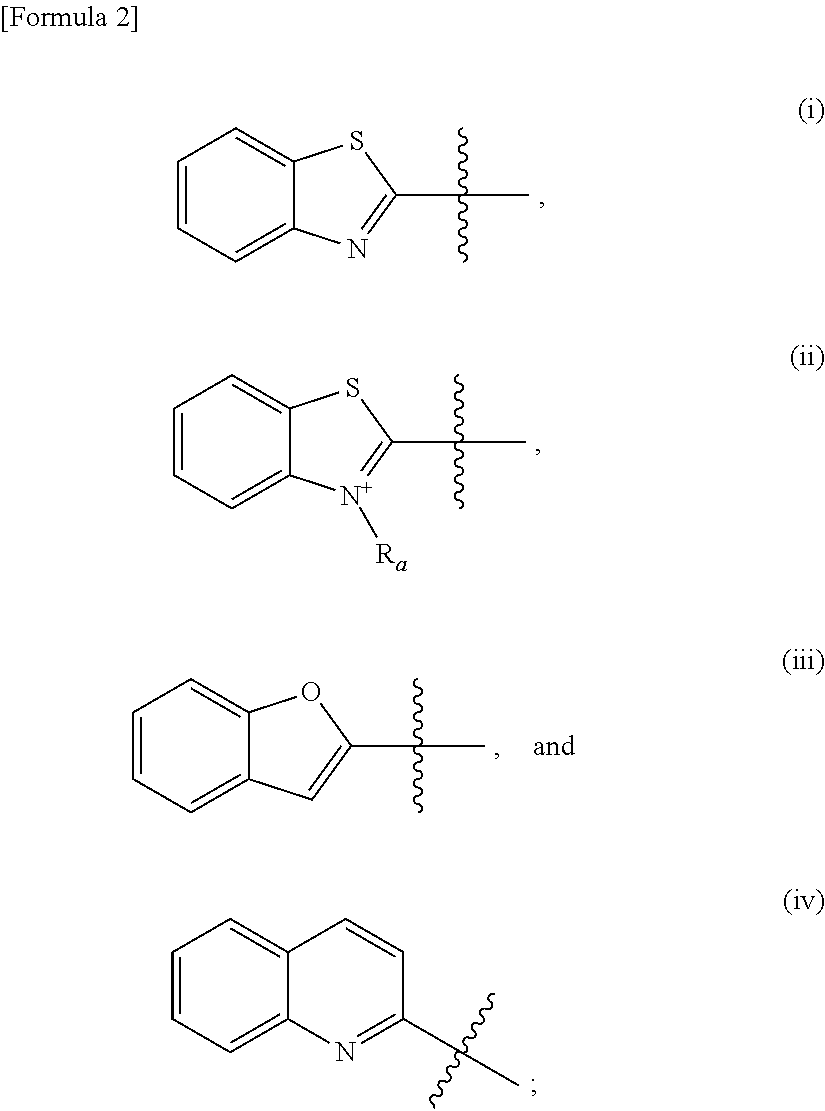
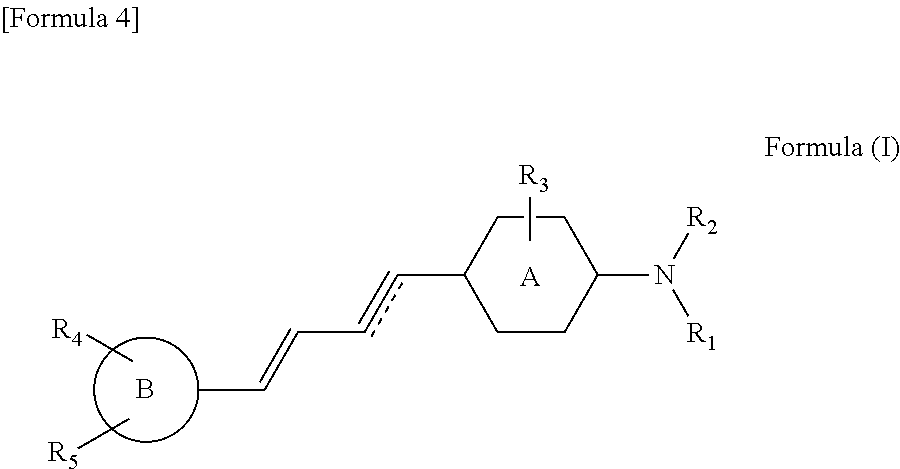


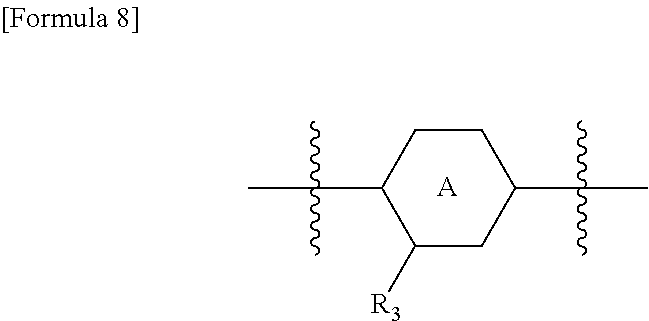

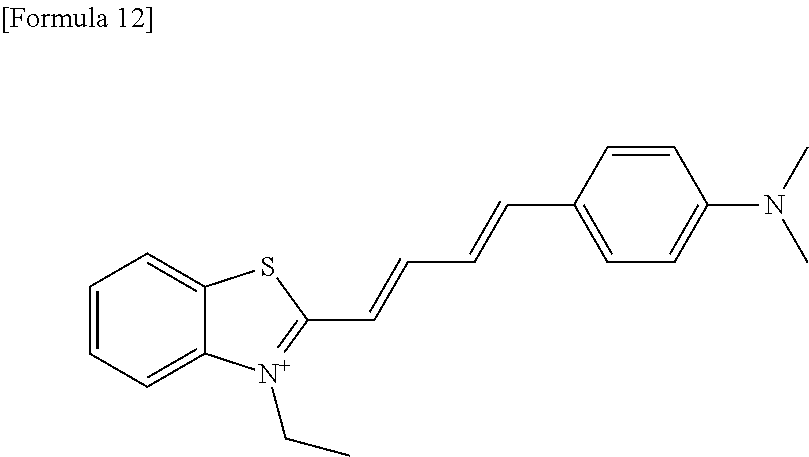


View All Diagrams
| United States Patent | 10,604,516 |
| Higuchi , et al. | March 31, 2020 |
Compounds for imaging tau proteins that accumulate in the brain
Abstract
The present invention provides a compound represented by the following formula (I), a pharmaceutically acceptable salt thereof, or a solvate thereof. ##STR00001## wherein: R.sub.1 and R.sub.2 are each separately selected from the group consisting of hydrogen, alkyl, alkenyl, acyl, and hydroxyalkyl; R.sub.3 is hydrogen or halogen; ring A is a benzene ring or a pyridine ring; ring B is selected from the group consisting of the following formulas (i), (ii), (iii), and (iv): ##STR00002## in the formula (ii), R.sub.a is alkyl; R.sub.4 and R.sub.5 are each separately selected from the group consisting of hydrogen, hydroxy, alkoxy, haloalkoxy, halohydroxyalkoxy, and aminoalkyl; and [Formula 3] represents a double bond or a triple bond. The above compound can be used as a molecular probe for imaging tau proteins that accumulate in the brain.
| Inventors: | Higuchi; Makoto (Chiba, JP), Suhara; Tetsuya (Chiba, JP), Maruyama; Masahiro (Chiba, JP), Cho; Meiei (Chiba, JP), Shimada; Hitoshi (Chiba, JP) | ||||||||||
|---|---|---|---|---|---|---|---|---|---|---|---|
| Applicant: |
|
||||||||||
| Assignee: | National Institutes for Quantum and
Radiological Science and Technology (JP) |
||||||||||
| Family ID: | 50287280 | ||||||||||
| Appl. No.: | 14/346,914 | ||||||||||
| Filed: | December 21, 2012 | ||||||||||
| PCT Filed: | December 21, 2012 | ||||||||||
| PCT No.: | PCT/JP2012/083286 | ||||||||||
| 371(c)(1),(2),(4) Date: | March 24, 2014 | ||||||||||
| PCT Pub. No.: | WO2014/097474 | ||||||||||
| PCT Pub. Date: | June 26, 2014 |
Prior Publication Data
| Document Identifier | Publication Date | |
|---|---|---|
| US 20150239878 A1 | Aug 27, 2015 | |
| Current U.S. Class: | 1/1 |
| Current CPC Class: | C07F 7/1804 (20130101); C07D 417/14 (20130101); A61P 25/28 (20180101); A61K 49/0017 (20130101); C07D 417/06 (20130101); C07D 405/06 (20130101); C07D 277/64 (20130101); C07D 401/06 (20130101); C07D 405/14 (20130101); C07D 401/14 (20130101); A61K 49/0021 (20130101) |
| Current International Class: | A61B 8/00 (20060101); C07D 417/06 (20060101); C07F 7/18 (20060101); C07D 405/14 (20060101); C07D 405/06 (20060101); C07D 417/14 (20060101); C07D 277/64 (20060101); A61K 49/00 (20060101); C07D 401/14 (20060101); A61B 10/00 (20060101); A61B 5/00 (20060101); C07D 401/06 (20060101) |
| Field of Search: | ;424/9.6 |
References Cited [Referenced By]
U.S. Patent Documents
| 3833863 | September 1974 | Webster et al. |
| 5130228 | July 1992 | Wade et al. |
| 5264329 | November 1993 | Wade et al. |
| 7910579 | March 2011 | Kudo et al. |
| 2006/0018825 | January 2006 | Kudo et al. |
| 2009/0028787 | January 2009 | Gravenfors et al. |
| 2011/0130305 | June 2011 | Patton et al. |
| 1867552 | Nov 2006 | CN | |||
| 1655287 | May 2006 | EP | |||
| 2397139 | Dec 2011 | EP | |||
| 55-053333 | Apr 1980 | JP | |||
| 61-275836 | Dec 1986 | JP | |||
| 2007-106755 | Apr 2007 | JP | |||
| 2009-519239 | May 2009 | JP | |||
| 2011/512354 | May 2012 | JP | |||
| 2011/0516866 | May 2012 | JP | |||
| 2012/102106 | Mar 2013 | JP | |||
| WO-2010/024769 | Mar 2010 | WO | |||
| WO 2010/087315 | Aug 2010 | WO | |||
| WO 2010/087315 | Aug 2010 | WO | |||
| WO 2011/065980 | Jun 2011 | WO | |||
Other References
|
Kung et al. JACS 2001, 123, 12740-12741. cited by examiner . Matsumura et al. Med. Chem. Commun. 2011, 2, 596-600. cited by examiner . International Search Report for PCT/JP2012/083286, dated Mar. 5, 2013, 5 pgs. cited by applicant . Etaiw et al., "Photophysics of benzazole derived push-pull butadienes: A highly sensitive fluorescence probes", Journal of Photochemistry and Photobiology, A: Chemistry, 2006, vol. 177, No. 2-3, pp. 238-247. cited by applicant . Wang et al., "A near infrared dye laser pumped by nitrogen laser light", Zhongguo Jiguang, 1989, vol. 16, No. 8, pp. 492-495. cited by applicant . Ehrenberg et al., "Surface potential on purple membranes and its sidedness studied by a resonance Raman dye probe", Biophysical Journal,1984, vol. 45, No. 4, pp. 663-670. cited by applicant . Z. P. Zhuang et. al., Radioiodinated Styrylbenzenes and Thioflavins as Probes for Amyloid Aggregates, J. Med. Chem. 2001, vol. 44, pp. 1905-1914. cited by applicant . Yoshiyama et al, Synapse Loss and Microglial Activation Precede Tangles in a P301S Tauopathy Mouse Model, Neuron, Feb. 1, 2007, vol. 53 pp. 337-351. cited by applicant . Arriagada et al., Neurofibrillary Tangles but not Senile Plaques Parallel Duration and Severity of Alzheimer's Disease, Neurology, 1992, vol. 42, pp. 631-639. cited by applicant . Ballatore et al., Tau-mediated Neurodegeneration in Alzheimer's Disease and related Disorders, Nature Reviews/Neuroscience, Sep. 2007, vol. 8, pp. 663-672. cited by applicant . Christer B. Aakeroy et al., Directed Supramolecular Assembly of Cu(II)-based "Paddlewheels" into Infinite 1-D Chains Using Structurally Bifunctional Ligands, The Toyal Society of Chemistry, Dalton Trans. 2006, pp. 1627-1635. cited by applicant . La Clair, James J., "Selective Detection of the Carbohydrate-Bound State of Concanavalin A at the Single Molecule Level", Journal of the American Chemical Society, 1997, vol. 119, No. 33, pp. 7676-7684. cited by applicant . Maruyama et al., "Imaging of Tau Pathology in a Tauopathy Mouse Model and in Alzheimer Patients Compared to Normal Controls", Neuron Article, vol. 79, Sep. 18, 2013, pp. 1094-1108. cited by applicant . Xu et al., "Tau protein, .alpha..beta.protein and Alzheimer's disease A protein and its role", Journal of Practice on Clinical Medicines, 2008, vol. 12, No. 3, pp. 118-120, Chinese lauguage. cited by applicant. |
Primary Examiner: Hartley; Michael G.
Assistant Examiner: Donohue; Sean R
Attorney, Agent or Firm: Mintz Levin Cohn Ferris Glovsky and Popeo PC
Claims
The invention claimed is:
1. A compound selected from the following: ##STR00103## or a pharmaceutically acceptable salt thereof, or a solvate thereof.
2. The compound of claim 1, wherein one or more atoms are a radioisotope of the atom or atoms.
3. A composition comprising the compound of claim 1, or a pharmaceutically acceptable salt thereof, or a solvate thereof, and a pharmaceutically acceptable carrier.
4. A method of tau imaging, comprising: (a) administering an effective dose of the compound of claim 1, or a pharmaceutically acceptable salt thereof, or a solvate thereof, to a mammal; and (b) imaging the brain of the mammal.
Description
RELATED APPLICATIONS
This application is a national stage entry, filed under 35 U.S.C. 371, of International Application No. PCT/JP2012/083286, filed Dec. 21, 2012, the entire content of which is incorporated by reference herein in its entirety.
TECHNICAL FIELD
The present invention relates to novel compounds for imaging tau proteins that accumulate in the brain, methods of preparing the compounds, intermediates thereof, and methods of use thereof.
BACKGROUND
In many neurodegenerative diseases such as Alzheimer's disease (AD), tau protein aggregates accumulate in brain cells, generally referred to as "tauopathies." Of these, in familial frontotemporal lobar degeneration (FTLD) (known as frontotemporal dementia and Parkinsonism linked to chromosome 17 (FTDP-17)), genetic mutations in tau genes have been discovered. After that, a study of Tg mice that overexpressed human wild type (WT) or FTDP-17 mutant tau proteins has made it clear that tau amyloid production takes part in the mechanism of neurodegenerative episodes in Alzheimer's disease (AD) and non-Alzheimer-type (non-AD) tauopathies (non-patent literature 1). Also, it has been shown that tau protein aggregates in AD, referred to as neurofibrillary tangles (NFT), are closely linked to disease severity than senile plaques that are made of amyloid .beta. peptides (A.beta.) (non-patent literature 2). By contrast with amyloid precursor protein (APP) Tg mice in which A.beta. aggregates accumulate without a decrease of neurons, tau Tg mice exhibit a significant decrease of neurons (non-patent literature 3). It is therefore necessary, in future studies, to make the neurotoxicity of fibrous tau proteins in tauopathies pathologically clear, by a comparative evaluation of the living human brain and the mouse brain.
In vivo imaging--for example, positron emission tomography (PET), optical imaging, and nuclear magnetic resonance imaging--is able to visualize A.beta. deposits in AD patients and AD mouse models in vivo. As molecular probes to be used thereupon, compounds such as [.sup.18F]FDDNP, [.sup.11C]6-OH-BTA-1(PIB), [.sup.11C]AZD2184, [.sup.11C]BF-227, [.sup.18F]-BAY94-9172, and [.sup.18F]AV-45 are known (patent literatures 1 to 4). Among these, [.sup.18F]FDDNP has been suggested to bind to both senile plaques and NFTs. However, since this compound has binding to the dense core of A.beta. aggregates, interactions with tau pathologies in AD patients have not been shown clearly. In addition, there is a problem that this compound does not bind to tau aggregates in non-AD tauopathy brains without senile plaques, and therefore cannot directly show binding to tau pathologies in vivo. Consequently, development of novel compounds that specifically bind to tau proteins that accumulate in the brain due to AD and non-AD tauopathies, and that allow imaging of tau aggregates, has been sought after.
CITATION LIST
Patent Literature
Patent Literature 1: Japanese Unexamined Patent Application Publication (Translation of PCT Application) No. 2009-519239
Patent literature 2: Japanese Unexamined Patent Application Publication No. 2012-102106
Patent literature 3: Japanese Unexamined Patent Application Publication (Translation of PCT Application) No. 2011-516866
Patent literature 4: Japanese Unexamined Patent Application Publication (Translation of PCT Application) No. 2011-512354
Non-patent Literature
Non-patent literature 1: Ballatore, C et al., Tau-mediated neurodegeneration in Alzheimer's disease and related disorders, Nat. Rev. Neurosci, 8, 663-72 (2007).
Non-patent literature 2: Arriagada, P. V. et al., Neurofibrillary tangles but not senile plaques parallel duration and severity of Alzheimer's disease, Neurology 42, 631-639 (1992).
Non-patent literature 3: Yoshiya, Y. et al., Synapse loss and microglial activation precede tangles in a P301S tauopathy mouse model, Neuron 53, 337-351 (2007).
SUMMARY OF INVENTION
Technical Problem
It is an object of the present invention to provide novel compounds that can specifically bind to tau proteins that accumulate in the brain.
Solution to Problem
The present inventors have tested compounds of various dimensions for binding to tau aggregates. As a result of this, it has been found out that compounds having a basic structure of specific length ranging from 13 to 19 .ANG. exhibit affinity to tau aggregates in living organisms including AD and non-AD tauopathy patients. From this perspective, the present inventors have developed novel compounds that can specifically bind to tau aggregates.
The present invention provides a compound represented by the following formula (I), a pharmaceutically acceptable salt thereof, or a solvate thereof:
##STR00003## wherein:
R.sub.1 and R.sub.2 are each separately selected from the group consisting of hydrogen, alkyl, alkenyl, acyl, and hydroxyalkyl;
R.sub.3 is hydrogen or halogen;
ring A is a benzene ring or a pyridine ring;
ring B is selected from the group consisting of the following formulas (i), (ii), (iii), and (iv):
##STR00004##
in the formula (ii), R.sub.a is alkyl;
R.sub.4 and R.sub.5 are each separately selected from the group consisting of hydrogen, hydroxy, alkoxy, haloalkoxy, halohydroxyalkoxy, and aminoalkyl; and [Formula 3] represents a double bond or a triple bond. In one embodiment, in the compound of the formula (I), one or more atoms are a radioisotope of the atom(s).
Advantageous Effects of Invention
The compounds of the present invention can specifically bind to tau aggregates. Consequently, it is possible to image tau proteins that accumulate in the brain using the compounds of the present invention.
After being administered in mammals, the compounds of the present invention can quickly pass the blood brain barrier. The half-life of the compounds of the present invention to last in the brain is approximately 10 minutes, and therefore has an advantage of having little influence on the human body. Also, the compounds of the present invention have fluorescence properties, so that the compounds of the present invention, when labeled with a radioactive isotope, are capable of double imaging, by the fluorescence properties and radioactivity of the compounds themselves.
BRIEF DESCRIPTION OF DRAWINGS
FIG. 1 shows confocal fluorescence images of frontal cortex slices of AD patients;
FIG. 1a shows images that are stained with PIB and FSB, and with an anti-A.beta.N3 (pE) antibody;
FIG. 1b shows images that are stained with PBB1 to PBB5, and with an anti-A.beta.N3 (pE) antibody;
FIG. 2 shows double fluorescence staining images of AD NFTs and Pick's disease by FSB, PIB, THK523, FDDNP, BF-227, PBB1 to PBB5, and AT8;
FIG. 3A shows the results of in vitro and ex vivo labeling of NFT-like tau inclusions in PS19 mice using PBB1 to PBB5;
FIG. 3B shows the results of in vitro labeling of AD NFTs and NFT-like tau inclusions in PS19 mice using compounds other than PBB1 to PBB5;
FIG. 4 shows the results of non-invasive near-infrared imaging using PBB5;
FIG. 5 shows real-time 2-photon laser scanning images using PBB3;
FIG. 6A shows the results of PET and autoradiographic detections of tau pathologies of PS19 mice using [.sup.11C]PBB2 and [.sup.11C]PBB3;
FIG. 6B shows the results of PET and autoradiographic detections of PS19 mice and non-Tg WT mice using [.sup.11C]PBB2;
FIG. 7 shows coronal-plane PET images in the brains of WT mice (left panel) and PS19 Tg mice (right panel) to which [.sup.11C]mPBB5 is injected; and
FIG. 8 shows autoradiography images (FIG. 8a) and PET images (FIG. 8b) of brain slices of AD patients using [.sup.11C]PBB3 and [.sup.11C]PIB.
DESCRIPTION OF EMBODIMENTS
(1. Definitions)
The term "alkyl" means a monovalent group that is produced when aliphatic saturated hydrocarbon misses one hydrogen atom. An alkyl has, for example, 1 to 15 carbon atoms, and typically has 1 to 10, 1 to 8, 1 to 6, 1 to 5, 1 to 4, 1 to 3, 1 to 2, or 2 to 6 carbon atoms. An alkyl may be a straight chain or may be branched. Examples of alkyls include, but are by no means limited to, methyl, ethyl, propyl, isopropyl, 2-methyl-1-propyl, 2-methyl-2-propyl, 2-methyl-1-butyl, 3-methyl-1-butyl, 2-methyl-3-butyl, 2,2-dimethyl-1-propyl, 2-methyl-1-pentyl, 3-methyl-1-pentyl, 4-methyl-1-pentyl, 2-methyl-2-pentyl, 3-methyl-2-pentyl, 4-methyl-2-pentyl, 2,2-dimethyl-1-butyl, 3,3-dimethyl-1-butyl, 2-ethyl-1-butyl, butyl, isobutyl, t-butyl, pentyl, isopentyl, neopentyl, and hexyl. An alkyl may furthermore be substituted by an adequate substituent.
In this description, 1 to 15, 1 to 10, 1 to 8, 1 to 6, 1 to 5, 1 to 4, 1 to 3, 1 to 2, 2 to 8, 2 to 6, 2 to 4, 3 to 8, 3 to 6, 4 to 8, and 4 to 6 carbon atoms will be represented as C.sub.1-15, C.sub.1-10, C.sub.1-8, C.sub.1-6, C.sub.1-5, C.sub.1-4, C.sub.1-3, C.sub.1-2, C.sub.2-8, C.sub.2-6, C.sub.2-4, C.sub.3-8, C.sub.3-6, C.sub.4-8, and C.sub.4-6, respectively.
The term "cycloalkyl" means a monovalent group that is produced when aliphatic saturated hydrocarbon forming a carbocyclic ring misses one hydrogen atom. A cycloalkyl has, for example, 3 to 10 carbon atoms, and typically has 3 to 8, 3 to 6, 3 to 5, 3 to 4, 4 to 5, 4 to 6, or 4 to 8 carbon atoms. Examples of cycloalkyls include, but are by no means limited to, cyclopropane, cyclobutane, cyclopentane, cyclohexane, cycloheptane, and cyclooctane. A cycloalkyl may furthermore be substituted by an adequate substituent.
The term "alkenyl" means an unsaturated aliphatic hydrocarbon group that has at least one double bond. An alkenyl has, for example, 2 to 15 carbon atoms, and typically has, 2 to 10, 2 to 8, 2 to 6, 2 to 5, 2 to 4, 2 to 3, 3 to 6, 3 to 8, 4 to 6, 4 to 7, or 4 to 8 carbon atoms. An alkenyl may be a straight chain or may be branched. Examples of alkenyls include, but are by no means limited to, to be specific, vinyl (--CH.dbd.CH.sub.2), allyl (--CH.sub.2CH.dbd.CH.sub.2), --CH.dbd.CH(CH.sub.3), --CH.dbd.C(CH.sub.3).sub.2, --C(CH.sub.3).dbd.CH.sub.2, --C(CH.sub.3).dbd.CH(CH.sub.3), --C(CH.sub.2CH.sub.3).dbd.CH.sub.2, 1,3-butadienyl (--CH.dbd.CH--CH.dbd.CH.sub.2), and hepta-1,6-diene-4-yl (--CH.sub.2--(CH.sub.2CH.dbd.CH.sub.2).sub.2). An alkenyl may furthermore be substituted by an adequate substituent.
The term "alkynyl" means an unsaturated aliphatic hydrocarbon group that has at least one triple bond. An alkynyl has, for example, 2 to 15 carbon atoms, and typically has 2 to 10, 2 to 8, 2 to 6, 2 to 5, 2 to 4, 2 to 3, 3 to 6, 4 to 6, 4 to 7, or 4 to 8 carbon atoms. An alkynyl may be a straight chain or may be branched. Examples of alkynyls include, but are by no means limited to, ethynyl (--C.ident.CH), --C.ident.CH(CH.sub.3), --C.ident.C(CH.sub.2CH.sub.3), --CH.sub.2C.ident.CH, --CH.sub.2C.ident.C(CH.sub.3), and --CH.sub.2C.ident.C(CH.sub.2CH.sub.3). An alkynyl may furthermore be substituted by an adequate substituent.
The term "acyl" means a group that is represented by "--CO--R." Here, R is, for example, an alkyl, an alkenyl, or an alkynyl. Examples of acyls include, but are by no means limited to, acetyl (--COCH3), ethylcarbonyl, propylcarbonyl, pentylcarbonyl, cyclohexylcarbonyl, octylcarbonyl, 2-ethylhexylcarbonyl, dodecylcarbonyl, phenylcarbonyl, benzylcarbonyl, naphthylcarbonyl and pyridylcarbonyl. An acyl may furthermore be substituted by an adequate substituent.
The term "hydroxy" or "hydroxyl" means --OH. The term "hydroxyalkyl" means an alkyl group that is substituted by a hydroxy group (--OH). Examples of hydroxyalkyls include, but are by no means limited to, hydroxymethyl (--CH.sub.2OH), 2-hydroxyethyl (--CH.sub.2CH.sub.2OH), 1-hydroxyethyl (--CH(OH)CH.sub.3), 3-hydroxypropyl (--CH.sub.2CH.sub.2CH.sub.2OH), 2-hydroxypropyl (--CH.sub.2CH(OH)CH.sub.3), and 1-hydroxypropyl (--CH(OH)CH.sub.2CH.sub.3). A hydroxyalkyl may furthermore be substituted by an adequate substituent. The term "halogen" or "halo" means fluoro (--F), chloro (--Cl), bromo (--Br), and iodine (--I).
The term "alkoxy" means an alkyl that is bound to other groups via oxygen atoms (that is, --O-alkyl). Examples of alkoxys include, but are by no means limited to, methoxy (--O-methyl), ethoxy (--O-ethyl), propoxy (--O-propyl), --O-isopropyl, --O-2-methyl-1-propyl, --O-2-methyl-2-propyl, --O-2-methyl-1-butyl, --O-3-methyl-1-butyl, --O-2-methyl-3-butyl, --O-2,2-dimethyl-1-propyl, --O-2-methyl-1-pentyl, 3-O-methyl-1-pentyl, --O-4-methyl-1-pentyl, --O-2-methyl-2-pentyl, --O-3-methyl-2-pentyl, --O-4-methyl-2-pentyl, --O-2,2-dimethyl-1-butyl, --O-3,3-dimethyl-1-butyl, --O-2-ethyl-1-butyl, --O-butyl, --O-isobutyl, --O-t-butyl, --O-pentyl, --O-isopentyl, --O-neopentyl, and --O-hexyl. An alkoxy may furthermore be substituted by an adequate substituent.
The term "haloalkyl" means an alkyl that is substituted by at least one halogen. Haloalkyls include fluoroalkyl, chloroalkyl, bromoalkyl, and iodoalkyl. Examples of haloalkyls include, but are by no means limited to, fluoromethyl, chloromethyl, bromomethyl, iodomethyl, fluoroethyl, chloroethyl, bromoethyl, iodoethyl, fluoropropyl, chloropropyl, bromopropyl, iodopropyl, fluorobutyl, chlorobutyl, bromobutyl, iodobutyl, fluoropentyl, chloropentyl, bromopentyl, iodopentyl, fluorohexyl, chlorohexyl, bromohexyl, iodohexyl, fluoroheptyl, chloroheptyl, bromoheptyl, iodoheptyl, fluorooctyl, chlorooctyl, bromooctyl, and iodooctyl. A haloalkyl may furthermore be substituted by an adequate substituent.
The term "haloalkoxy" means an alkoxy that is substituted by at least one halogen (that is, --O-haloalkyl). Haloalkoxys include fluoroalkoxy, chloroalkoxy, bromoalkoxy, and iodoalkoxy.
The term "halohydroxyalkyl" means a hydroxyalkyl that is substituted by halogen. Halohydroxyalkyls include fluorohydroxyalkyl, chlorohydroxyalkyl, bromohydroxyalkyl, and iodohydroxyalkyl. Examples of halohydroxyalkyls include 1-bromo-3-propanol, 1-iodo-3-propanol, 1-bromo-2-ethanol, 1-iodo-2-ethanol, 1-bromo-1-methanol or 1-iodo-1-methanol.
The term "halohydroxyalkoxy" means a haloalkoxy that is substituted by a hydroxy group. Halohydroxyalkoxys include fluorohydroxyalkoxy, chlorohydroxyalkoxy, bromohydroxyalkoxy, and iodohydroxyalkoxy. Examples of halohydroxyalkoxys include --O--CH(F)(OH), --O--CH.sub.2CH(F)(OH), --O--CH(OH)--CH.sub.2(F), --O--CH.sub.2--CH(F)(OH), --O--CH(OH)--CH.sub.2--CH.sub.2(F), --O--CH.sub.2--CH(OH)--CH.sub.2(F), --O--CH(CH.sub.2--F)(CH.sub.2OH) and --O--CH.sub.2--CH.sub.2--CH(F)(OH).
The term "nitro" means --NO.sub.2. The term "amino" means --NH.sub.2. The term "aminoalkyl" means an alkyl group that is substituted by an amino group. Examples of aminoalkyls include, but are by no means limited to, aminomethyl, aminoethyl, aminopropyl, aminoisopropyl, aminobutyl, aminopentyl, aminohexyl, and aminooctyl.
The term "substituent" means one or more atoms or an atomic group that is introduced in a given chemical structural formula. Examples of substituents include, for example, C.sub.1-8 alkyls (methyl, ethyl, n-propyl, iso-propyl, n-butyl, sec-butyl, iso-butyl, tert-butyl, or n-hexyl, or its isomer, and so on), C.sub.2-8 alkenyls (vinyl, allyl, --CH.dbd.CH(CH.sub.3), --CH.dbd.C(CH.sub.3).sub.2, --C(CH.sub.3).dbd.CH.sub.2, --C(CH.sub.3).dbd.CH(CH.sub.3), --C(CH.sub.2CH.sub.3).dbd.CH.sub.2 and so on), C.sub.2-8 alkynyl(ethynyl, --C.ident.CH(CH.sub.3), --C.ident.C(CH.sub.2CH.sub.3), --CH.sub.2C.ident.CH, --CH.sub.2C.ident.C(CH.sub.3), --CH.sub.2C.ident.C(CH.sub.2CH.sub.3) and so on), alkoxy, hydroxy, halogen, haloalkyl, cycloalkyl (cyclopropyl, cyclobutyl, cyclopentyl, or cyclohexyl and so on), amino, nitro, acyl (acetyl and so on) (--COCH.sub.3), carboxyl (--COOH), ester (--COOR.sup.x, where R.sup.x is C.sub.1-6 alkyl and so on), amide (--CONR.sup.yR.sup.z, where R.sup.y and R.sup.z are individually H or C.sub.1-6 alkyl and so on), thiol (--SH), sulfonic acid (--SO.sub.3H), nitrile (--CN), aromatic rings (aryl, phenyl, benzoyl, or naphthalenyl and so on), heterocyclic rings (pyrrolidinyl, tetrahydrofuranyl, pyrrolyl, furanyl, thiophenyl, piperidinyl, oxanyl, or pyridinyl and so on), and so on.
The term "pharmaceutically acceptable salt" means a salt that is not harmful to mammals, especially humans. Pharmaceutically acceptable salts can be formed using non-toxic acids or bases, including mineral acids or inorganic bases, or organic acids or organic bases. Examples of pharmaceutically acceptable salts include metal salts formed with aluminum, calcium, lithium, magnesium, potassium, sodium, zinc and so on, and organic salts formed with lysine, N,N'-dibenzylethylenediamine, chloroprocaine, choline, diethanolamine, ethylenediamine, meglumine (N-methylglucamine), procaine and so on. Also, pharmaceutically acceptable salts contain acid-addition salts and base-addition salts.
The term "pharmaceutically acceptable carriers" means pharmaceutically acceptable materials, compositions, or vehicles such as physiological saline solutions, liquid or solid fillers, diluents, solvents, or encapsulants. Examples of pharmaceutically acceptable carriers include water, saline water, physiological saline water or phosphate buffered saline water (PBS), sodium chloride injection solution, Ringer's injection solution, isotonic dextrose injection solution, sterile water injection solution, dextrose, and lactated Ringer's injection solution.
The term "effective dose" refers to the amount of a compound or a composition which will have a targeted effect. For example, in some embodiments, the effective dose may refer to the amount of a compound or a composition which will enable tau imaging.
The term "solvate" means a solvent-containing compound that is formed by association of one or a plurality of solvent molecules to the compounds of the present invention. Solvates include, for example, monosolvates, disolvates, trisolvates, and tetrasolvates. Also, solvates include hydrates. The term "hydrate" means a compound further containing a stoichiometric or a non-stoichiometric amount of water constrained by non-covalent bonding intermolecular force, or a salt thereof. Hydrates include monohydrates, dihydrates, trihydrates, and tetrahydrates.
The term "treatment" means moderating or remitting the progress, severity and/or period of a disease or condition. The term "prevention" means reducing the danger of catching or making worse a predetermined disease or condition, or reducing or suppressing the recurrence, start or progress of a predetermined disease or condition, or one or a plurality of symptoms.
The term "tau imaging" means imaging tau proteins that accumulate in the brain. This imaging may be performed by positron emission tomography (PET), fluorescence microscopy measurement, multi-photon imaging, two-photon imaging, near-infrared fluorescence imaging, autoradiography, and single-photon emission computed tomography (SPECT).
(2. Compounds of the Present Invention)
The present invention provides a compound represented by the following formula (I), a pharmaceutically acceptable salt thereof, or a solvate thereof:
##STR00005## wherein:
R.sub.1 and R.sub.2 are each separately selected from the group consisting of hydrogen, alkyl, alkenyl, acyl, and hydroxyalkyl;
R.sub.3 is hydrogen or halogen;
ring A is a benzene ring or a pyridine ring;
ring B is selected from the group consisting of the following formulas (i), (ii), (iii), and (iv):
##STR00006##
in the formula (ii), R.sub.a is alkyl;
R.sub.4 and R.sub.5 are each separately selected from the group consisting of hydrogen, hydroxy, alkoxy, haloalkoxy, halohydroxyalkoxy, and aminoalkyl; and [Formula 6] represents a double bond or a triple bond.
In one embodiment, ring B is the formula (i) or the formula (ii). In another embodiment, ring B is the formula (i). In yet another embodiment, ring B is the formula (ii). When ring B is the formula (ii), the type of the counter anion is not particularly limited, and may be p-toluenesulfonate, I.sup.-, and or the like. In one embodiment, ring B is the formula (iii). In another embodiment, ring B is the formula (iv).
When ring B is the formula (i), R.sub.4 and R.sub.5 can be at substitutable positions in the benzothiazole ring of the formula (i). Preferably, R.sub.4 and R.sub.5 are at position 6 and position 5 in the benzothiazole ring of the formula (i), respectively. When ring B is the formula (ii), R.sub.4 and R.sub.5 can be at substitutable positions in the benzothiazolium ring of the formula (ii). Preferably, R.sub.4 and R.sub.5 are at position 6 and position 5 in the benzothiazolium ring of the formula (ii), respectively. When ring B is the formula (iii), R.sub.4 and R.sub.5 can be at substitutable positions in the benzofuran ring of the formula (iii). Preferably, R.sub.4 and R.sub.5 are at position 5 and position 6 in the benzofuran ring of the formula (iii), respectively. When ring B is the formula (iv), R.sub.4 and R.sub.5 can be at substitutable positions in the quinoline ring of the formula (iv). Preferably, R.sub.4 and R.sub.5 are at position 6 and position 7 in the quinoline ring of the formula (iv), respectively.
In one embodiment, ring A is a pyridine ring. In another embodiment, ring A is a benzene ring. Preferably, ring A is the pyridine ring represented by the following structural formula, in the orientation of the structural formula of the formula (I).
##STR00007##
In one embodiment, R.sub.1 and R.sub.2 are both hydrogen. In one embodiment, R.sub.1 and R.sub.2 are each separately hydrogen or alkyl, especially C.sub.1-8 alkyl, and preferably methyl. In another embodiment, R.sub.1 is hydrogen, R.sub.2 is alkyl, especially C.sub.1-6 alkyl, and preferably methyl. In yet another embodiment, R.sub.1 and R.sub.2 are both alkyl, especially C.sub.1-6alkyl, and preferably methyl.
In one embodiment, R.sub.1 and R.sub.2 are each separately hydrogen or alkenyl, especially C.sub.2-8 alkenyl, and preferably allyl (--CH.sub.2CH.dbd.CH.sub.2) or hepta-1,6-diene-4-yl (--CH.sub.2--(CH.sub.2CH.dbd.CH.sub.2).sub.2). In another embodiment, R.sub.1 is hydrogen, R.sub.2 is alkenyl, especially C.sub.1-8 alkenyl, and preferably allyl (--CH.sub.2CH.dbd.CH.sub.2) or hepta-1,6-diene-4-yl (--CH.sub.2--(CH.sub.2CH.dbd.CH.sub.2).sub.2). In yet another embodiment, R.sub.1 and R.sub.2 are both alkenyl, especially C.sub.1-8 alkenyl, and preferably allyl (--CH.sub.2CH.dbd.CH.sub.2) or hepta-1,6-diene-4-yl (--CH.sub.2--(CH.sub.2CH.dbd.CH.sub.2).sub.2).
In one embodiment, R.sub.1 and R.sub.2 are each separately hydrogen or acyl, especially C.sub.1-8 acyl, and preferably acetyl (--COCH.sub.3). In another embodiment, R.sub.1 is hydrogen, R.sub.2 is acyl, especially C.sub.1-8 acyl, and preferably acetyl (--COCH.sub.3). In yet another embodiment, R.sub.1 and R.sub.2 are both acyl, especially C.sub.1-8 acyl, and preferably acetyl (--COCH.sub.3).
In one embodiment, R.sub.1 and R.sub.2 are each separately hydrogen or hydroxyalkyl, especially hydroxyC.sub.1-8alkyl, preferably hydroxypropyl, and more preferably 3-hydroxypropyl (--CH.sub.2CH.sub.2CH.sub.2OH). In another embodiment, R.sub.1 is hydrogen, R.sub.2 is hydroxyalkyl, especially hydroxyC.sub.1-8alkyl, preferably hydroxypropyl, and more preferably 3-hydroxypropyl (--CH.sub.2CH.sub.2CH.sub.2OH). In yet another embodiment, R.sub.1 and R.sub.2 are both hydroxyalkyl, especially hydroxyC.sub.1-8alkyl, preferably hydroxypropyl, and more preferably 3-hydroxypropyl (--CH.sub.2CH.sub.2CH.sub.2OH).
In one embodiment, R.sub.3 is hydrogen. In another embodiment, R.sub.3 is halogen, that is, F, Cl, Br or I. Preferably, R.sub.3 is F. Preferably, R.sub.3 is .sup.18F. In the orientation of the structural formula of the formula (I), R.sub.3 preferably assumes the following position.
##STR00008##
In the orientation of the structural formula of the formula (I), ring A and R.sub.3 preferably have the following relationship.
##STR00009##
In one embodiment, R.sub.a is alkyl, preferably C.sub.1-8 alkyl, and more preferably methyl or ethyl. In one embodiment, R.sub.4 and R.sub.5 are both hydrogen. In one embodiment, R.sub.4 and R.sub.5 are each separately hydrogen or hydroxy. In another embodiment, R.sub.4 is hydroxy, and R.sub.5 is hydrogen. In yet another embodiment, R.sub.4 is hydrogen, and R.sub.5 is hydroxy. In yet another embodiment, R.sub.4 and R.sub.5 are both hydroxy.
In one embodiment, R.sub.4 and R.sub.5 are each separately hydrogen or alkoxy, especially methoxy. In another embodiment, R.sub.4 is alkoxy, especially methoxy, and R.sub.5 is hydrogen. In yet another embodiment, R.sub.4 is hydrogen, R.sub.5 is alkoxy, especially methoxy. In yet another embodiment, R.sub.4 and R.sub.5 are both alkoxy, especially methoxy.
In one embodiment, R.sub.4 and R.sub.5 are each separately hydrogen or halohydroxyalkoxy, especially fluorohydroxyalkoxy, preferably fluorohydroxyC.sub.1-3alkoxy, and more preferably --O--CH.sub.2--CH(OH)--CH.sub.2(F) or --O--CH(CH.sub.2--F)(CH.sub.2OH). In another embodiment, R.sub.4 is halohydroxyalkoxy, especially fluorohydroxyalkoxy, preferably fluorohydroxyC.sub.1-3alkoxy, more preferably --O--CH.sub.2--CH(OH)--CH.sub.2(F) or --O--CH(CH.sub.2--F)(CH.sub.2OH), and R.sub.5 is hydrogen. In yet another embodiment, R.sub.4 is hydrogen, R.sub.5 is halohydroxyalkoxy, especially fluorohydroxyalkoxy, preferably fluorohydroxyC.sub.1-3alkoxy, more preferably --O--CH.sub.2--CH(OH)--CH.sub.2(F) or --O--CH(CH.sub.2--F)(CH.sub.2OH). In yet another embodiment, R.sub.4 and R.sub.5 are both halohydroxyalkoxy, especially fluorohydroxyalkoxy, preferably fluorohydroxyC.sub.1-3alkoxy, and more preferably --O--CH.sub.2--CH(OH)--CH.sub.2(F) or --O--CH(CH.sub.2--F)(CH.sub.2OH). In one embodiment, fluorohydroxyalkoxy contains a radioisotope. Preferably, this fluorohydroxyalkoxy is --O--CH.sub.2--CH(OH)--CH.sub.2(.sup.18F) or --O--CH(CH.sub.2-.sup.18F)(CH.sub.2OH).
In one embodiment, R.sub.4 and R.sub.5 are each separately hydrogen or aminoalkyl, especially aminomethyl or aminoethyl. In another embodiment, R.sub.4 is aminoalkyl, especially aminomethyl or aminoethyl, and R.sub.5 is hydrogen. In yet another embodiment, R.sub.4 is hydrogen, and R.sub.5 is aminoalkyl, especially aminomethyl or aminoethyl. In yet another embodiment, R.sub.4 and R.sub.5 are both aminoalkyl, especially aminomethyl or aminoethyl.
In one embodiment, [Formula 10] is a double bond. In another embodiment, [Formula 11] is a triple bond.
In one embodiment, the following compound is excluded from the compound of the formula (I).
##STR00010##
In one embodiment, the compound of the formula (I) is a compound represented by the following formula (II):
##STR00011## wherein R.sub.1 to R.sub.5, and [Formula 14] have been defined above in the compound of the formula (I).
In one embodiment, the compound of the formula (I) is a compound represented by the following formula (III):
##STR00012## wherein R.sub.1 to R.sub.5, and [Formula 16] have been defined in the compound of the formula (I).
In one embodiment, the compound of the formula (I) is a compound represented by the following formula (IV).
##STR00013## wherein R.sub.1 to R.sub.5, R.sub.a and [Formula 18] have been defined in the compound of the formula (I).
In one embodiment, the compound of the formula (I) is a compound represented by the following formula (V).
##STR00014## wherein R.sub.1 to R.sub.5, and [Formula 20] have been defined in the compound of the formula (I).
In one embodiment, the compound of the formula (I) is a compound represented by the following formula (VI).
##STR00015## wherein R.sub.1 to R.sub.5, and [Formula 22] have been defined in the compound of the formula (I).
In one embodiment, in the compounds of the formulas (I) to (VI), one or more atoms are a radioisotope of the atom(s). The radioisotope may be selected from the group consisting of .sup.15O, .sup.13N, .sup.11C, .sup.18F and so on, but is not particularly limited. Preferably, the radioisotope is .sup.11C or .sup.19F. Of these, considering that the half-life of .sup.11C is approximately 20 minutes and the half-life of .sup.18F is approximately 110 minutes, a compound that is labeled with .sup.18F may have a higher commercial value. Consequently, most preferably, the radioisotope is .sup.18F.
Preferably, one or more of R.sub.1 to R.sub.5 are groups that contain a radioisotope. More preferably, one or both of R.sub.1 and R.sub.2 are groups that contain a radioisotope, and are, for example, groups that contain .sup.11C (for example, [.sup.11C]alkyl to contain .sup.11CH.sub.3). Even more preferably, R.sub.3 is a group to contain a radioisotope, and is, for example, --.sup.18F. More preferably, one or both of R.sub.4 and R.sub.5 are groups that contain a radioisotope, and are, for example, groups to contain .sup.11C (for example, [.sup.11C]alkoxy to contain --O.sup.11CH.sub.3), or groups to contain .sup.18F ([.sup.18F]fluorohydroxyalkoxy to contain --O--CH.sub.2--CH(OH)--CH.sub.2(.sup.18F) and --O--CH(CH.sub.2-.sup.18F)(CH.sub.2OH)). Here, [.sup.11C]alkyl indicates that one or more carbon atoms in the carbon atoms constituting alkyl are .sup.11C. [.sup.11C]alkoxy indicates that one or more carbon atoms in the carbon atoms constituting alkoxy are .sup.11C. [.sup.18F]fluorohydroxyalkoxy means a group in which .sup.18F is bound to hydroxyalkoxy.
Specific examples of the compounds of the present invention include the following compounds:
TABLE-US-00001 TABLE 1 Fluores- cence Synthesis property Embodi- binding Name Name of Compound Structural Formula ment capacity (1) PBB1 1-((1E,3E)-4- (benz[d]thiazole-2- yl)buta-1,3-dienyl)-N,N- dimethylaniline ##STR00016## 1 (2) PBB2 2-((1E,3E)-4-(4- (methylamino) phenyl)buta-1,3-dienyl)benz [d]thiazole-6-ol ##STR00017## 2 (3) PBB3 2-((1E,3E)-4-(6- (methylamino) pyridine-3-yl) buta-1,3-dienyl) benz[d]thiazole-6-ol ##STR00018## 3 (4) PBB4 2-((1E,3E)-4- (6-(methylamino) pyridine-3-yl) buta-1,3-dienyl) benz[d]thiazole-5,6-diol ##STR00019## 4 (5) PBB5 2-((1E,3E)-4-(4- (dimethylamino) phenyl)buta-1,3-dienyl)-3- ethylbenzo[d]thiazole-3- ium ##STR00020## -- (6) mPBB5 2-((1E,3E)-4-(4- (dimethylamino) phenyl)buta-1,3-dienyl)-3- ethyl-6-methoxybenzo[d] thiazole-3-ium ##STR00021## 5 (7) PBB2.1 (E)-2-(4-(4-(dimethylamino) phenyl)buta-1-en- 3-ynyl)benz [d]thiazole-6-ol ##STR00022## 6 (8) PBB2.2 (E)-2-(4-(4-(methylamino) phenyl)buta-1-en-3-ynyl)benz [d]thiazole-6-ol ##STR00023## 7 (9) PBB2.3 (E)-2-(4-(4- aminophenyl) buta- 1-en-3-ynyl)benz[d]thiazole- 6-ol ##STR00024## 8 (10) PBB3.1 (E)-2-(4-(6-(dimethylamino) pyridine-3-yl)buta-1-en-3- ynyl)benz[d]thiazole-6-ol ##STR00025## 9 (11) PBB3.2 (E)-2-(4-(6-(methylamino) pyridine-3-yl)buta-1-en-3- ynyl)benz[d]thiazole-6-ol ##STR00026## 10 (12) PBB3.2N (E)-5-(4-(6- (aminomethyl)benz [d]thiazole-2-yl)buta-3-en-1- ynyl)-N-methylpyridine-2- amine ##STR00027## 11 (13) Core1-4 2-((1E,3E)-4- (4-aminophenyl) buta-l,3-dienyl)-6- methoxybenzo[d]thiazole- 5-ol ##STR00028## 12 (14) Core1-5 N-(4-((1E,3E)-4-(5,6- dimethoxybenzo[d]thiazole- 2-yl)buta-1,3-dienyl)phenyl) acetamide ##STR00029## 13 (15) Core1-11 3-(4-((1E,3E)-4-(5,6- dimethoxybenzo[d]thiazole- 2-yl)buta-1,3-dienyl) phenylamino)propan-1-ol ##STR00030## 14 (16) Core1-15 4-((1E,3E)-4-(5,6- dimethoxybenzo[d]thiazole- 2-yl)buta-1,3-dienyl)-N- isopropylaniline ##STR00031## 15 (17) Core1-20 4-((1E,3E)-4-(5,6- dimethoxybenzo[d]thiazole- 2-yl)buta-1,3-dienyl)-N- (hepta-1,6-diene-4-yl) aniline ##STR00032## 16 (18) Core2-9 N-(5-((1E,3E)-4-(5,6- dimethoxybenzo[d]thiazole- 2-yl)buta-1,3-dienyl)pyridine- 2-yl)acetamide ##STR00033## 17 (19) Core2-10 3-(5-((1E,3E)-4-(5,6- dimethoxybenzo[d]thiazole- 2-yl)buta-1,3-dienyl)pyridine- 2-ylamino)propan-1-ol ##STR00034## 18 (20) Core2-14 N,N-diallyl-5-((1E,3E)-4-(5,6- dimethoxybenzo[d]thiazole- 2-yl)buta-1,3-dienyl)pyridine- 2-amine ##STR00035## 19 F0-PBB3 analog 1-fluoro-2-(2-((1E,3E)-4-(6- (dimethylamino)pyridine-3- yl)buta-1,3-dienyl)benz[d] thiazole-6-yloxy)-2- hydroxymethyl-ethane ##STR00036## 20-1 (21) F0-PBB3 1-fluoro-3-(2-((1E,3E)-4-(6- (methylamino)pyridine-3-yl) buta-1,3-dienyl) benz[d]thiazole- 6-yloxy)propan-2-ol ##STR00037## 20-2 (22) F0-PBB3.2 (E)-1-fluoro-3-(2-(4-(6-- (methylamino)pyridine-3-yl) buta-1-en-3-ynyl)benz[d] thiazole-6-yloxy)propan-2-ol ##STR00038## 21 (23) F1-PBB3 2-((1E,3E)-4-(2-fluoro-6- (methylamino)pyridine-3-yl) buta-1,3-dienyl) benz[d]thiazole- 6-ol ##STR00039## 22 (24) F1-PBB3.2 (E)-2-(4-(2-fluoro-6- (methylamino)pyridine-3-yl) buta-1-en-3-ynyl)benz[d] thiazole-6-ol ##STR00040## 23 (25) F1-PBBf3 2-((1E,3E)-4-(2-fluoro-6- (metliylamino)pyridine-3-yl) buta-1,3-dienyl)benzofuran- 5-ol ##STR00041## 24 (26) F1-PBBf3.2 (E)-2-(4-(2-fluoro-6- (methylamino)pyridine-3-yl) buta-1-en-3-ynyl)benzofuran- 5-ol ##STR00042## 25 (27) PBQ3.0 2-((1E,3E)-4-(6- (dimethylamino) pyridine-3-yl)buta-1,3-dienyl) quinoline-6-ol ##STR00043## 26 (28) PBQ3 2-((1E,3E)-4-(6-(methylamino) pyridine-3-yl)buta-1,3-dienyl) quinoline-6-ol ##STR00044## 27 (29) PBQ3.1 (E)-2-(4-(6-(dimethylamino) pyridine-3-yl)buta-1-en-3- ynyl)quinoline-6-ol ##STR00045## 28 (30) PBQ3.2 (E)-2-(4-(6-(methylamino) pyridine-3-yl)buta-1-en-3- ynyl)quinoline-6-ol ##STR00046## 29
In one embodiment, in the specific compounds given above, one or more atoms are a radioisotope of the atom(s). Preferably, a carbon atom on nitrogen bound to a benzene ring or a pyridine ring is the radioisotope .sup.11C. Preferably, F in the above specific compounds is the radioisotope .sup.18F. Preferably, a carbon atom of a methoxy group bound to a benzothiazole ring is the radioisotope .sup.11C. More preferably, an atom with the "*" symbol in the structural formulas of the above specific compounds (where there are two "*" symbols in a structural formula, one or two of them) is the radioisotope of that atom, which is, for example, .sup.11C or .sup.18F. In this description, names such as [.sup.11C]PBB3 mean that .sup.11C is above the atom of the "*" symbol in the structural formula of PBB3, and so on.
(3. Methods of Preparing the Compounds of the Present Invention)
Synthesis Example 1
The compound of the present invention according to the formula (I) can be prepared according to following scheme 1:
##STR00047##
In the above formulas, A, B, R.sub.1 to R.sub.5, and [Formula 24] have been defined above in the compound of the formula (I), and Hal is halogen, especially bromo.
The method of preparing the compounds of the present invention includes step 2 of reacting the compound (c1) with NHR.sub.1R.sub.2 and obtaining the compound of the formula (I). Preferably, the method of preparing the compounds of the present invention includes step 1 of coupling the compound (a1) with the compound (b1) and obtaining the compound (c1), and step 2 of reacting the compound (c1) with NHR.sub.1R.sub.2 and obtaining the compound of the formula (I).
The reaction of above step 1 can be performed under Wittig reaction conditions. This reaction can be performed under an inert gas atmosphere such as argon or nitrogen. This reaction preferably uses bases such as sodium hydride, sodium methoxide, or sodium ethoxide. This reaction is preferably performed in an inert solvent such as tetrahydrofuran (THF) or N,N-dimethylformamide (DMF). The temperature of this reaction is not limited, but can be in a range from 0.degree. C. (in an ice bath) to room temperature.
The reaction of above step 2 can be performed under electrophilic aromatic substitution conditions. This reaction can be performed using bases such as triethylamine. This reaction is preferably performed in an inert solvent such as DMF, or in an alcohol solvent such as methanol or ethanol. The temperature of this reaction is not limited and ranges from 0.degree. C. (in an ice bath) to reflux temperature, and can be, for example, 0.degree. C. to 160.degree. C., 30.degree. C. to 150.degree. C., 60.degree. C. to 140.degree. C., 90.degree. C. to 130.degree. C., or 120.degree. C.
If necessary, it is possible to protect each compound with a protecting group prior to the reactions of above step 1 and/or step 2, and then perform the reactions. When one or more of R.sub.1 to R.sub.5 have a hydroxy or an amino group, it is preferable to protect this hydroxy or amino group with an adequate protecting group. Examples of protecting groups for hydroxy or amino groups include alkyl groups such as methyl groups and ethyl groups, benzyl groups, t-butyldimethylsilyl groups (--Si(CH.sub.3).sub.2(t-C.sub.4H.sub.9)), tert-butoxycarbonyl groups (Boc: --COO-(t-C.sub.4H.sub.9)), methoxymethyl groups (--CH.sub.2OCH.sub.3), and ethoxymethyl groups (--CH.sub.2OCH.sub.2CH.sub.3). Deprotection may be performed in adequate steps, in a method that is known to one of skill in the art.
Synthesis Example 2
The compound of the present invention according to the formula (I), in which R.sub.1 and R.sub.2 are hydrogen, may be prepared in accordance with following scheme 2:
##STR00048## In the above formulas, A, B, R.sub.3 to R.sub.5, and [Formula 26] have been defined above in the compound of the formula (I).
The method of preparing the compounds of the present invention includes step 2 of reducing the compound (c2) and obtaining the compound of the formula (I-i) (the compound of the formula (I), in which R.sub.1 and R.sub.2=H). Also, prior to step 2, the method of preparing the compounds of the present invention further includes step 1 of coupling the compound (a2) with the compound (b2) and obtaining the compound (c2).
The reaction of above step 1 can be performed under Wittig reaction conditions. This reaction can be performed under an inert gas atmosphere such as argon or nitrogen. This reaction preferably uses bases such as sodium hydride, sodium methoxide, or sodium ethoxide. This reaction is preferably performed in an inert solvent such as tetrahydrofuran (THF) or N,N-dimethylformamide (DMF). The temperature of this reaction is not limited and might range from 0.degree. C. (in an ice bath) to room temperature.
The reduction in above step 2 can be performed under reducing conditions to convert an aromatic nitro group into an amino group. For example, this reduction can be performed using iron, zinc, or tin chloride in an acid solution. For the acid solution, acetic acid, hydrochloric acid, or a liquid mixture of these may be used. Furthermore, salts such as ammonium chloride may be used. This reduction c can be performed in an alcohol solution such as methanol, ethanol or propanol. This reduction can be performed in, but is by no means limited to, room temperature to reflux temperature. For example, this reduction can be performed at 20.degree. C. to 100.degree. C., 40.degree. C. to 90.degree. C., or 80.degree. C. Also, this reduction can be performed in catalytic hydrogenation using a metal catalyst such as platinum, or can be performed in reduction using a metal hydride such as lithium aluminum hydride.
If necessary, it is possible to protect each compound with an adequate protecting group prior to the reactions of above step 1 and/or step 2, and then perform the reactions. When one or more of R.sub.3 to R.sub.5 have a hydroxy or an amino group, it is preferable to protect that hydroxy or amino group with an adequate protecting group. Examples of protecting groups for hydroxy or amino groups include alkyl groups such as methyl groups or ethyl groups, benzyl groups, t-butyldimethylsilyl groups (--Si(CH.sub.3).sub.2(t-C.sub.4H.sub.9)), tert-butoxycarbonyl groups (Boc: --COO-(t-C.sub.4H.sub.9)), methoxymethyl groups (--CH.sub.2OCH.sub.3), and ethoxymethyl groups (--CH.sub.2OCH.sub.2CH.sub.3). Deprotection may be performed in adequate steps, in a method that is known to one of skill in the art.
Synthesis Example 3
The compound of the present invention according to the formula (I), in which R.sub.1 is not hydrogen and R.sub.2 is hydrogen, can be prepared according to following scheme 3:
##STR00049## In the above formulas, A, B, R.sub.1, R.sub.3 to R.sub.5, and [Formula 28] have been defined above in the compound of the formula (I), where, however, R.sub.1 is not hydrogen, X is an elimination group and is, for example, halogen such as Cl, Br or I, alkoxy such as methoxy or ethoxy, triflate (--OSO.sub.2--CF.sub.3), carboxylate (--OCO--R), or an azide group (--N.sub.3).
In scheme 3, the compound of the formula (I-i), which is the starting substance, can be synthesized according to above scheme 2. With the method of preparing the compounds of the present invention, it is possible to include step 1 of obtaining the compound of the formula (I-ii) (the compound of the formula (I), in which R.sub.1.noteq.H and R.sub.2=H) by reacting the compound of the formula (I-i) with R.sub.1X with reference to above scheme 3.
The reaction of above step 1 is alkylation, alkenylation, acylation or hydroxyalkylation of an amino group. When R.sub.1 is alkyl, alkenyl, hydroxyalkyl and/or the like, this reaction can be performed under nucleophilic substitution reaction conditions. In this case, X is preferably halogen, especially Cl, Br or I, or triflate (--OSO.sub.2--CF.sub.3). This reaction may use a base such as K.sub.2CO.sub.3 or triethylamine, or may use a reducing agent such as sodium hydride or sodium borohydride. This reaction may be performed under an inert atmosphere such as nitrogen or argon. This reaction may be performed in an inert solvent such as dichloromethane, chloroform, or N,N-dimethylformamide, or in an alcohol solvent such as methanol or ethanol. This reaction can be performed at, but is not limited to, 0.degree. C. (in an ice bath) to room temperature, or at room temperature to reflux temperature, which can be, for example, 0.degree. C. to 160.degree. C., 30.degree. C. to 150.degree. C., 60.degree. C. to 140.degree. C., 90.degree. C. to 130.degree. C., or 120.degree. C.
In the reaction of above step 1, when R.sub.1 is methyl in the formula (I-ii), a different method, in which the compound of the formula (I-i) is reacted with formaldehyde or paraformaldehyde, and, after that, the product is reduced using a reducing agent such as sodium hydride or sodium borohydride, may be used.
The reaction of above step 1 can be performed under nucleophilic acyl substitution reaction conditions when R.sub.1 is acyl and/or the like. In this case, X is preferably halogen such as Cl, Br or I, alkoxy such as methoxy or ethoxy, carboxylate (--OCO--R), or an azide group (--N.sub.3). This reaction can be performed in the presence of bases such as K.sub.2CO.sub.3 or triethylamine. This reaction may be performed under acid conditions such as HCl. This reaction can be performed in an inert solvent such as dichloromethane, chloroform or N,N-dimethylformamide. This reaction can be performed at, but is by no means limited to, 0.degree. C. (in an ice bath) to reflux temperature.
If necessary, it is possible to protect each compound with an adequate protecting group prior to the reaction of above step 1, and then perform the reaction. When one or more of R.sub.1, R.sub.3 to R.sub.5 have a hydroxy or an amino group, it is preferable to protect that hydroxy or amino group with an adequate protecting group. Examples of protecting groups for hydroxy or amino groups include alkyl groups such as methyl groups and ethyl groups, benzyl groups, t-butyldimethylsilyl groups (--Si(CH.sub.3).sub.2(t-C.sub.4H.sub.9)), tert-butoxycarbonyl groups (Boc:--COO-(t-C.sub.4H.sub.9)), methoxymethyl groups (--CH.sub.2OCH.sub.3), and ethoxymethyl groups (--CH.sub.2OCH.sub.2CH.sub.3). Deprotection may be performed in a method that is known to one of skill in the art.
For example, when one or both of R.sub.4 and R.sub.5 are OH, as shown in steps 2 to 4 of scheme 3, it is possible to synthesize protector 1 of the formula (I-i) from the compound of the formula (I-i), react it with R.sub.1X, and, after that, synthesize the compound of the formula (I-ii) by deprotection. Step 2 shown in scheme 3 is a step for when R.sub.4 alone is OH. One of skill in the art should readily understand that the protector can be synthesized when R.sub.5 alone is OH or when R.sub.4 and R.sub.5 are both OH. This protector can be obtained by reacting the compound of the formula (I-i) with t-butyldimethylchlorosilane. This reaction may use a base such as imidazole. This reaction is preferably performed under an inert gas atmosphere such as nitrogen or argon. Also, this reaction is usually performed under an inert solvent such as dimethylsulfoxide. The temperature of this reaction is preferably room temperature.
After formula (I-i) protector 1 is prepared, a formula (I-ii) protector can be prepared by a reaction with R.sub.1X (step 3). This reaction may adopt the same reaction conditions as in step 1 above. After that, by deprotecting the formula (I-ii) protector, the compound of the formula (I-ii), in which one or both of R.sub.4 and R.sub.5 are OH, can be obtained. This deprotection can be performed using acid such as hydrochloric acid or using fluoride ion such as tetra-n-butylammonium fluoride hydrate.
Also, for example, when one or both of R.sub.4 and R.sub.5 are aminoalkyl, as shown in steps 5 to 7 of scheme 3, it is possible to synthesize formula (I-i) protector 2 from the compound of the formula (I-i), react it with R.sub.1X, and, after that, synthesize the compound of the formula (I-ii) by deprotection. Step 5 shown in scheme 3 is a step for when R.sub.4 alone is aminoalkyl. One of skill in the art should readily understand that the protector can be synthesized when R.sub.5 alone is aminoalkyl, as well as when R.sub.4 and R.sub.5 are both aminoalkyl. This protector can be obtained by reacting the compound of the formula (I-i) with tert-butyldicarbonate.
In scheme 3, when R.sub.1X is [.sup.11C]alkyl-X such as .sup.11CH.sub.3--X, [.sup.11C]alkyl such as --.sup.11CH.sub.3 can be introduced.
Synthesis Example 4
The compound of the present invention according to the formula (I), in which R.sub.1 is not hydrogen and R.sub.2 is hydrogen, may be prepared according to following scheme 4.
##STR00050## In the above formulas, A, B, R.sub.1, R.sub.3 to R.sub.5, and [Formula 30] have been defined above in the compound of the formula (I), in which, however, R.sub.1 is not hydrogen.
The method of preparing the compounds of the present invention includes step 2 of reacting the compound (c4) with Lewis acid and obtaining the compound of the formula (I-ii) (the compound of the formula (I), in which R.sub.1.noteq.H and R.sub.2=H). Furthermore, step 3 of obtaining the compound of the formula (I-iii) (the compound of the formula (I), in which R.sub.1 and R.sub.2.noteq.H) by a reaction with R.sub.2X after reduction, may be included. Also, the method of preparing the compounds of the present invention may further include, prior to step 2, step 1 of coupling the compound (a4) with the compound (b4) and obtaining the compound (c4).
The reaction of above step 1 can be performed under Wittig reaction conditions. This reaction can be performed under an inert gas atmosphere such as argon or nitrogen. This reaction preferably uses a base such as sodium hydride, sodium methoxide, or sodium ethoxide. This reaction is preferably performed in an inert solvent such as tetrahydrofuran (THF) or N,N-dimethylformamide (DMF). The temperature of this reaction is not limited, but can be in a range from 0.degree. C. (in an ice bath) to room temperature.
The reaction of above step 2 is performed under Boc (tert-butoxycarbonyl group) deprotection conditions. Lewis acid is preferably BBr.sub.3. This reaction can be performed under an inert gas atmosphere such as argon or nitrogen. This reaction can be performed in an inert solvent such as dichloromethane or chloroform. The temperature of this reaction can be made room temperature.
If necessary, it is possible to protect each compound with an adequate protecting group prior to the reactions of above step 1 and/or step 2, and then perform the reactions. When one or more of R.sub.1, R.sub.3 to R.sub.5 have a hydroxy or an amino group, it is preferable to protect that hydroxy or amino group with an adequate protecting group. Examples of protecting groups for hydroxy or amino groups include alkyl groups such as methyl groups and ethyl groups, benzyl groups, t-butyldimethylsilyl groups (--Si(CH.sub.3).sub.2(t-C.sub.4H.sub.9)), tert-butoxycarbonyl groups (Boc:--COO-(t-C.sub.4H.sub.9)), methoxymethyl groups (--CH.sub.2OCH.sub.3), and ethoxymethyl groups (--CH.sub.2OCH.sub.2CH.sub.3). Deprotection may be performed in adequate steps, in a method that is known to one of skill in the art.
Synthesis Example 5
The compound of the present invention according to the formula (I), in which R.sub.1 and R.sub.2 are not hydrogen, can be prepared according to following scheme 5.
##STR00051## In the above formulas, A, B, R.sub.1 to R.sub.5, and [Formula 32] have been defined above in the compound of the formula (I), in which, however, R.sub.1 and R.sub.2 are not hydrogen, X is an elimination group, which is, for example, halogen such as Cl, Br or I, alkoxy such as methoxy or ethoxy, triflate (--OSO.sub.2--CF.sub.3), carboxylate (--OCO--R), or an azide group (--N.sub.3).
The compound of the formula (I-ii), which is the starting substance, can be synthesized in accordance with above scheme 3 or 4. With the method of preparing the compounds of the present invention, it is possible to include step 1 of obtaining the compound of the formula (I-iii) (the compound of the formula (I), in which R.sub.1 and R.sub.2.noteq.H) by reacting the compound of the formula (I-ii) with R.sub.2X with reference to above scheme 5. When R.sub.1 and R.sub.2 are the same group, it is possible to synthesize the compound of the formula (I-iii) directly from the compound of the formula (I-i), in above scheme 3 or 4.
Similar to the reaction in step 1 of scheme 3 above, the reaction in step 1 of scheme 5 is alkylation, alkenylation, acylation or hydroxyalkylation of an amino group. Step 1 of scheme 5 can be performed under the same conditions as for step 1 of above scheme 3.
If necessary, it is possible to protect each compound with an adequate protecting group prior to the reaction of above step 1, and then perform the reaction. When one of more of R.sub.1 to R.sub.5 have a hydroxy or an amino group, it is preferable to protect that hydroxy or amino group with an adequate protecting group. Examples of protecting groups for hydroxy or amino group include alkyl groups such as methyl groups and ethyl groups, benzyl groups, t-butyldimethylsilyl groups (--Si(CH.sub.3).sub.2(t-C.sub.4H.sub.9)), tert-butoxycarbonyl groups (Boc:--COO-(t-C.sub.4H.sub.9)), methoxymethyl groups (--CH.sub.2OCH.sub.3), and ethoxymethyl groups (--CH.sub.2OCH.sub.2CH.sub.3). Deprotection may be performed in a method that is known to one of skill in the art.
For example, when one or both of R.sub.4 and R.sub.5 are OH, the formula (I-ii) protector may be prepared as shown in step 2 of scheme 5. Step 2 shown in scheme 5 is a step for when R.sub.4 alone is OH. This protector can be obtained by reacting the compound of the formula (I-ii) with t-butyldimethylchlorosilane. This reaction may use a base such as imidazole. This reaction is preferably performed under an inert gas atmosphere such as nitrogen or argon. Also, this reaction is usually performed under an inert solvent such as dimethylsulfoxide. The temperature of this reaction is preferably room temperature. One of skill in the art should readily understand that protector can be synthesized when R.sub.4 is not OH and R.sub.5 is OH, as well as when R.sub.4 and R.sub.5 are OH.
After the formula (I-ii) protector is prepared, it is possible to prepare the formula (I-iii) protector by a reaction with R.sub.2X, (Step 3). This reaction may adopt the same reaction conditions as in step 1 above. After that, by deprotecting the formula (I-ii) protector, the compound of the formula (I-iii), in which one or both of R.sub.4 and R.sub.5 are OH, can be obtained. This deprotection can be performed using acid such as hydrochloric acid, or fluoride ion.
In above step 1, when R.sub.2X is [.sup.11C]alkyl-X such as .sup.11CH.sub.3--X, a radioisotope for [.sup.11C]alkyl, such as --.sup.11CH.sub.3, can be introduced.
Synthesis Example 6
The compound of the present invention according to the formula (I), in which R.sub.3 is halogen, can be prepared according to following scheme 6:
##STR00052## In the above formulas, A, B, R.sub.1 to R.sub.5, and [Formula 34] have been defined above in the compound of the formula (I), in which, however, R.sub.3 is halogen, especially F. With the method of scheme 6, a radioisotope for .sup.18F can be introduced.
If necessary, it is possible to protect each compound with an adequate protecting group prior to the reaction of above step 1, and then perform the reaction. When one or more of R.sub.1 to R.sub.5 have a hydroxy or an amino group, it is preferable to protect that hydroxy or amino group with an adequate protecting group. Examples of protecting groups for hydroxy or amino groups include alkyl groups such as methyl groups and ethyl groups, benzyl groups, t-butyldimethylsilyl groups (--Si(CH.sub.3).sub.2(t-C.sub.4H.sub.9)), tert-butoxycarbonyl groups (Boc:--COO-(t-C.sub.4H.sub.9)), methoxymethyl groups (--CH.sub.2OCH.sub.3), and ethoxymethyl groups (--CH.sub.2OCH.sub.2CH.sub.3). Deprotection may be performed in a method that is known to one of skill in the art.
For example, when, as shown in step 2, one or both of R.sub.1 and R.sub.2 are hydrogen, it is preferable to protect with a protecting group such as a tert-butoxycarbonyl group (Boc: --COO-(t-C.sub.4H.sub.9)), prior to the reaction of step 1. Also, when one or both of R.sub.4 and R.sub.5 are OH, it is preferable to protect with an ethoxymethyl group (--CH.sub.2OCH.sub.2CH.sub.3), prior to the reaction of step 1.
Synthesis Example 7
The compound of the present invention according to the formula (I), in which R.sub.4 is alkoxy, may be prepared according to following scheme 7.
##STR00053## In the above formulas, A, B, R.sub.1 to R.sub.3, R.sub.5, and [Formula 36] have been defined above in the compound of the formula (I), in which Alk means alkyl and X means an elimination group.
With reference to above scheme 7, the method of preparing the compounds of the present invention can include step 1 of obtaining the compound of the formula (I-v) (the compound of the formula (I), in which R.sub.4 is methoxy), by reacting the compound (a7) with Alk-X.
If necessary, it is possible to protect each compound with an adequate protecting group prior to the reaction of above step 1, and then perform the reaction. When one or more of R.sub.1 to R.sub.3, and R.sub.5 have a hydroxy or an amino group, it is preferable to protect this hydroxy or amino group with an adequate protecting group. Examples of protecting groups for hydroxy or amino groups include alkyl groups such as methyl groups and ethyl groups, benzyl groups, t-butyldimethylsilyl groups (--Si(CH.sub.3).sub.2(t-C.sub.4H.sub.9)), tert-butoxycarbonyl groups (Boc:--COO-(t-C.sub.4H.sub.9)), methoxymethyl groups (--CH.sub.2OCH.sub.3), and ethoxymethyl groups (--CH.sub.2OCH.sub.2CH.sub.3). Deprotection may be performed in a method that is known to one of skill in the art.
When Alk-X is [.sup.11C]alkyl-X such as .sup.11CH.sub.3--X, a radioisotope for [.sup.11C]alkyl, such as --.sup.11CH.sub.3, can be introduced.
Synthesis Example 8
The compound of the present invention according to the formula (I), in which R.sub.4 is halohydroxyalkoxy, may be prepared according to following scheme 8.
##STR00054## In the above formulas, A, B, R.sub.1 to R.sub.3, R.sub.5, and [Formula 38] have been defined above in the compound of the formula (I), in which Alk means an alkyl group, TsO means tosylate (p-H.sub.3C--C.sub.6H.sub.4--SO.sub.2--O--), and Hal means halogen, especially F.
With reference to above scheme 8, the method of preparing the compounds of the present invention can include step 1 of obtaining the compound of the formula (I-v) (the compound of the formula (I), in which R.sub.4 is methoxy) by reacting the compound (a8-1) or (a8-2).
In the above compounds (a8-1) and (a8-2),
##STR00055## mean, respectively, a group in which TsO- and --O-2-tetrahydropyranyl are bound to given positions of the carbon atoms of --O-alkyl (alkoxy), and a group in which TsO- and OH are bound to given positions of the carbon atoms of --O-alkyl (alkoxy). For example, the above formulas mean --O--CH.sub.2CH (--O-2-tetrahydropyranyl) (--CH.sub.2--OTs) or --O--CH.sub.2CH(--OH) (--CH.sub.2--OTs), and --O--CH(--O-2-tetrahydropyranyl) (--CH.sub.2--OTs) or --O--CH(--CH.sub.2--OH) (--CH.sub.2--OTs), and so on.
Similarly, in the above formulas,
##STR00056## means a group in which Hal and OH are bound to given positions of the carbon atoms of --O-alkyl(alkoxy), that is, halohydroxyalkoxy.
Synthesis Example 9
The compound of the present invention according to the formula (I), in which [Formula 41] is a triple bond, may be prepared according to following scheme 9.
##STR00057## In the above formulas, A, B, and R.sub.1 to R.sub.5 have been defined above with the compound of the formula (I).
With reference to above scheme 9, the method of preparing the compounds of the present invention can include step 1 of obtaining the compound of the formula (I-vi) (the compound of the formula (I), in which [Formula 43] is a triple bond) by coupling the compound (a9) with the compound (b9).
The reaction of above step 1 is performed under Sonogashira reaction conditions. This reaction can be performed using a copper catalyst such as cuprous iodide, a palladium catalyst such as dichlorobis (triphenylphosphine) palladium, and a base such as triethylamine. The temperature of this reaction may be 25.degree. C. to 120.degree. C., preferably 50.degree. C. to 100.degree. C., and most preferably 70.degree. C.
If necessary, it is possible to protect each compound with an adequate protecting group prior to the reaction of above step 1, and then perform the reaction. When one or more of R.sub.1 to R.sub.5 have a hydroxy or an amino group, it is preferable to protect that hydroxy or amino group with an adequate protecting group. Examples of protecting groups for hydroxy or amino groups include alkyl groups such as methyl groups and ethyl groups, benzyl groups, t-butyldimethylsilyl groups (--Si(CH.sub.3).sub.2(t-C.sub.4H.sub.9)), tert-butoxycarbonyl groups (Boc: --COO-(t-C.sub.4H.sub.9)), methoxymethyl groups (--CH.sub.2OCH.sub.3), and ethoxymethyl groups (--CH.sub.2OCH.sub.2CH.sub.3). Deprotection may be performed in a method that is known to one of skill in the art.
(4. Intermediates)
The present invention provides an intermediate for synthesizing the compound of the present invention according to the formula (I). Preferably, the intermediate is selected from the group consisting of the following:
the formula (I-i) in above scheme 2 (in the formula, R.sub.4 is hydroxy);
the formula (I-ii), the formula (I-i) protector 1, and the formula (I-i) protector 2 in above scheme 3;
the formula (I-ii) protector in above scheme 5;
(a6) and the (a6) protector in above scheme 6;
the (a7) protector in above scheme 7; and
(a8-1) and (a8-2) in above scheme 8.
In one embodiment, the present invention provides an intermediate for synthesizing the compound of the present invention according to the formula (I), selected from the group consisting of the following:
TABLE-US-00002 TABLE 2 Synthesis Embodi- Name Name of Compound Structural Formula ment (pre2) Synthetic intermediate of PBB2 2-((1E,3E)-4- (4-aminophenyl) buta-1,3- dienyl)benz[d] thiazole-6-ol ##STR00058## 30 (pre3) Synthetic intermediate of PBB3 5-((1E,3E)-4-(6-(tert- butyldimethylsilyloxy) benz [d]thiazole- 2-yl)buta-1,3- dienyl)pyridine- 2-amine ##STR00059## 31 (pre6) Synthetic intermediate of PBB5 2-((1E,3E)-4-(4- (dimethylamino) phenyl)buta- 1,3-dienyl)-3-ethyl-6- hydroxy-benz [d]thiazole- 3-ium ##STR00060## 32 (pre7) Synthetic intermediate of PBB2.1 (E)-2-(4-(4- (methylamino) phenyl)buta- 1-en-3-ynyl) benz[d]thiazole-6-ol ##STR00061## 7 (pre8) Synthetic intermediate of PBB2.2 (E)-2-(4-(4- aminophenyl) buta-1-en-3- ynyl)benz[d] thiazole-6-ol ##STR00062## 8 (pre11) Synthetic intermediate of PBB3.2 (E)-5-(4-(6-(tert- butyldimethylsilyloxy) benz[d]thiazole- 2-yl)buta-3- en-1-ynyl)pyridine-2- amine ##STR00063## 34 (pre12) Synthetic intermediate of PBB3.2N (E)-tert-butyl(2-(4-(6- aminopyridine- 3-yl)buta- 1-en-3-ynyl) benz[d]thiazole- 6-yl)methylcarbamate ##STR00064## 34 Synthetic intermediate of F0-PBB3 analog 2-(2-((1E,3E)-4-(6- (dimethylamino) pyridine-3- yl)buta-1,3- dienyl) benzo [d]thiazole- 6-yloxy)-2- hydroxymethyl- ethyl 4- methylbenzene- sulfonate ##STR00065## 35-1 (pre21) Synthetic intermediate of F0-PBB3 3-(2-((1E,3E)-4-(6- (methylamino) pyridine-3-yl) buta-1,3-dienyl) benz[d]thiazole- 6-yloxy)-2- (tetrahydro-2H- pyran-2- yloxy)propyl 4-methylbenzene- sulfonate ##STR00066## 35-2 (pre22) Synthetic intermediate of F0-PBB3.2 (E)-3-(2-(4-(6- (methylamino) pyridine-3-yl) buta-1-en-3- ynyl)benz[d] thiazole-6-yloxy)- 2-(tetrahydro- 2H-pyran-2- yloxy)propyl 4-methylbenzene- sulfonate ##STR00067## 36 (pre23) Synthetic intermediate of F1-PBB3 Tert-butyl 5- ((1E,3E)-4-(6- (ethoxymethoxy) benz[d] thiazole-2-yl) buta-1,3-dienyl)- 6-nitropyridine-2-yl (methyl)carbamate ##STR00068## 37 (pre24) Synthetic intermediate of F1-PBB3.2 (E)-tert-butyl 5-(4-(6- (ethoxymethoxy) benz[d] thiazole-2-yl) buta-3-en-1- ynyl)-6- nitropyridine-2- (methyl)carbamate ##STR00069## 38 (pre25) Synthetic intermediate of F1-PBBf3 Tert-butyl 5- ((1E,3E)-4-(5- (ethoxymethoxy) benzofuran- 2-yl)buta-1,3-dienyl)-6- nitropyridine-2-yl (methyl)carbamate ##STR00070## 39 (pre26) Synthetic intermediate of F1-PBBf3.2 (E)-tert-butyl 5-(4-(5- (ethoxymethoxy) benzofuran- 2-yl)buta-3- en-1-ynyl)-6- nitropyridine-2-yl (methyl)carbamate ##STR00071## 40
Preferably, the intermediate of the present invention is used to synthesize the compound of the present invention according to the formula (I) labeled with a radioisotope.
(5. Compositions)
The present invention provides a composition for tau imaging, which contains the compound of the formula (I), or a pharmaceutically acceptable salt thereof or a solvate thereof. Also, this imaging includes in vitro, ex vivo and in vivo imaging. The composition may include a pharmaceutically acceptable carrier. Examples of this pharmaceutically acceptable carrier include water, saline water, physiological saline water or phosphate buffered saline water (PBS), sodium chloride injection solution, Ringer's injection solution, isotonic dextrose injection solution, sterile water injection solution, dextrose, and lactated Ringer's injection solution.
The contents of the compound of the formula (I) and the pharmaceutically acceptable carrier are not particularly limited, and these are determined based on various factors such as: the type of the compound that is used: the age, weight, health conditions, sex, and content of diet of the mammals that receive an administration; the number of administration and the route of administration; the period of treatment; other medicines that are at the same time, and so on. The content of the pharmaceutically acceptable carrier may be made an amount of 1 to 99 weight % of the composition of the present invention. The composition of the present invention may preferably be adjusted such that the compound of the formula (I) can be administered in an amount of 0.01 mg/kg to 5 mg/kg, or 0.05 mg/kg to 3 mg/kg, and preferably 0.1 mg/kg to 1 mg/kg.
(6. Methods of Use of the Compounds of the Present Invention)
The compounds of the present invention can be used as a molecular probe for tau imaging, that is, as a molecular probe for imaging tau proteins that accumulate in the brains of mammals. Consequently, the present invention provides a tau imaging method that includes administering the compound of the formula (I), or a pharmaceutically acceptable salt or a solvate thereof, to mammals. In another embodiment, the present invention provides a tau imaging method that includes (a) a step of administering an effective dose of the compound of the formula (I), or a pharmaceutically acceptable salt or a solvate thereof, to a mammal, and (b) a step of imaging the brain of the mammal.
The mammal may be, for example, a human, rat, mouse, rabbit, guinea pig, hamster, monkey, dog, ferret or miniature swine. Preferably, the mammal is a human. The method of administration is not particularly limited, and, for example, parenteral administration, intravenous administration, or intraperitoneal administration may be used. Preferably, intravenous administration or intraperitoneal administration may be used. Most preferably, intravenous administration may be used. The amount of administration is preferably 0.01 mg/kg to 5 mg/kg, 0.05 mg/kg to 3 mg/kg, or 0.1 mg/kg to 1 mg/kg, and most preferably 0.1 mg/kg to 1 mg/kg.
This imaging can be performed by molecular imaging methods such as positron emission tomography (PET), fluorescence microscopy measurement, multi-photon imaging, two-photon imaging, near-infrared fluorescence imaging, autoradiography, and single-photon emission computed tomography (SPECT). Also, this imaging includes in vitro, ex vivo, and in vivo imaging.
In one embodiment, the present invention provides a composition, which is for diagnosing diseases that are caused by accumulation of tau proteins in the brain, and which contains the compound of the formula (I), or a pharmaceutically acceptable salt or a solvate thereof. In another embodiment, the present invention provides a method of diagnosing diseases that are caused by accumulation of tau proteins, including administering the compound of the formula (I), or a pharmaceutically acceptable salt or a solvate thereof, to a mammal.
Diseases that are caused by accumulation of tau proteins include, for example, Alzheimer's disease, non-Alzheimer-type tauopathies (including frontotemporal lobar degeneration), or other tau-positive neurodegenerative diseases. To be more specific, diseases that are caused by accumulation of tau proteins include, besides Alzheimer's disease, progressive supranuclear palsy (PSP), Pick's disease, corticobasal degeneration (CBD), frontotemporal lobar degeneration (FTLD), frontotemporal dementia with Parkinsonism linked to chromosome 17 (FTDP-17), argyrophilic grain disease (AGD), dementia pugilistica boxer's encephalopathy, Parkinson-dementia complex of Guam, or neurofibrillary tangle-predominant dementia.
In another embodiment, the present invention provides a method of diagnosing a disease that is caused by accumulation of tau proteins, and this diagnosis method includes (a) a step of administering an effective dose of the compound of the formula (I), or a pharmaceutically acceptable salt or a solvate thereof, to a mammal, and (b) a step of imaging the brain of the mammal. In another embodiment, the above method further includes (c) a step of comparing the image of the brain of the mammal with that of a normal mammal. If the fluorescence intensity and/or the radiation intensity of the compound of the present invention show an increase compared to the normal mammal, this indicates that a disease to be caused by accumulation of tau proteins might have developed or that there is a danger of developing it.
In yet another embodiment, the present invention provides use of the compound of the formula (I), or a pharmaceutically acceptable salt or a solvate thereof, for preparing a composition for tau imaging. In yet another embodiment, the present invention provides use of the compound of the formula (I), or a pharmaceutically acceptable salt or a solvate thereof, for preparing a composition for diagnosing diseases such as Alzheimer's disease, frontotemporal lobar degeneration, dementia, or other neurodegenerative tauopathies.
In one embodiment, the present invention provides a method of screening a compound for treating or preventing a disease or a symptom that is caused by accumulation of tau proteins in the brain, and this screening method includes (a) a step of administering, to a mammal having a disease or a symptom that is caused by accumulation of tau proteins, a candidate compound for treating or preventing the disease or symptom, (b) a step of administering an effective dose of the compound of the formula (I) or a pharmaceutically acceptable salt thereof, to the mammal, and (c) a step of imaging the brain of the mammal.
The above screening method can further include (d-1) a step of comparing the image of the brain of the mammal with that from before the administration of the candidate compound. If, after the candidate compound is administered, the fluorescence intensity and/or the radiation intensity of the compound of the present invention show a decrease compared to those from before the administration of the candidate compound, this indicates that the candidate compound is effective as a compound for treating the disease or the symptom. Alternatively, the above method can include (d-2) a step of comparing the image of the brain of the mammal with an image of another normal mammal. If, after the candidate compound is administered, the fluorescence intensity and/or the radiation intensity of the compound of the present invention are equal to those of the normal mammal, this indicates that the candidate compound is effective as a compound for treating the disease or the symptom.
Embodiments
(7. Embodiments)
Embodiments of the present invention will be described below. These embodiments will be described only to deepen the understanding of the claims of the present invention, and are by no means intended to limit the claims of the present invention.
(Synthesis of the Compounds of the Present Invention)
(Synthesis Embodiment 1)
Synthesis of 4-((1E,3E)-4-(benz[d]thiazole-2-yl)buta-1,3-dienyl)-N,N-dimethylaniline (PBB1)
PBB1 was synthesized according to the following synthesis scheme.
##STR00072##
2-(bromomethyl)benzothiazole (Wako Code: Alfa Aesar, H26120) was reacted with trimethyl phosphite (Wako Code: 200-09082, 204-09085), and the resulting product was reacted with p-(dimethylamino)cinnamaldehyde (Wako Code: 045-16441, 041-16443, 043-16442), and the target compound was obtained.
PBB1: .sup.1H NMR (300 MHz, DMSO-d.sub.6) .delta. ppm: 8.04 (d, J=7.80 Hz, 1H), 7.90 (d, J=7.80 Hz, 1H), 7.48 (dd, J=7.80 Hz, 7.80 Hz, 1H), 7.36-7.43 (m, 4H), 6.89-6.98 (m, 3H), 6.72 (d, J=8.7 Hz, 2H), 2.96 (s, 6H)
(Synthesis Embodiment 2)
Synthesis of 2-((1E,3E)-4-(4-(methylamino)phenyl)buta-1,3-dienyl)benz[d]thiazole-6-ol (PBB2)
PBB2 was synthesized according to the following synthesis scheme.
##STR00073##
Step 1: Synthesis of carboxylic acid tert-butylester2-methyl-benzothiazole-6-ylester (1)
Triethylamine (6.58 ml, 47.5 mmol) and an anhydrous dimethylformamide solution (48 ml) of di-tert-butyl dicarbonate (10.8 g, 49.5 mmol) were added in an anhydrous dimethylformamide solution (150 ml) of 2-methyl-benzothiazole-6-ol (3.27 g, 19.8 mmol). The reaction mixture was stirred for 16 hours. The reaction mixture was condensed, and the residue was refined by column chromatography (ethyl acetate/hexane=1:3). The desired product was obtained as a pale brown solid, at a yield of 99% (5.23 g).
.sup.1H NMR (400 MHz, CDCl.sub.3) .delta. ppm 7.91 (d, J=8.8 Hz, 1H), 7.66 (d, J=2.3 Hz, 1H), 7.25 (dd, J=8.8, 2.4 Hz, 1H), 2.82 (s, 3H), 1.57 (s, 9H).
Step 2: Synthesis of carboxylic acid 2-{4-[4-(tert-butoxycarbonyl-methyl-amino)-phenyl]-buta-1,3-dienyl}-benzo- thiazole-6-ylestertert-butylester (2)
Finely powdered sodium hydroxide (892 mg, 22.3 mmol) was added in a dimethylformamide solution (15 ml) of carboxylic acid tert-butylester2-methyl-benzothiazole-6-ylester (1) (947 mg, 3.57 mmol). The solution was stirred for 10 minutes, and, after that, a dimethylformamide solution (6.2 ml) of 4-N-Boc-4-N-methyl-cinnamaldehyde (933 mg, 3.57 mmol) was added dropwise. The reaction mixture was stirred for 3.5 hours. The reaction mixture was diluted with ethyl acetate, and was washed with water. The aqueous phase was extracted 5 times using ethyl acetate. The combined ethyl acetate phase was dried with sodium sulfate and condensed. The residue was refined by column chromatography (ethyl acetate/hexane=1:3.fwdarw.1:2). The desired product was obtained as a bright yellow solid, at a yield of 76% (1.12 g).
.sup.1H NMR (400 MHz, CDCl.sub.3) .delta. ppm 8.33 (bs, 1H), 7.67 (d, J=8.8 Hz, 1H), 7.27 (d, J=8.5, Hz, 2H), 7.18 (d, J=8.5 Hz, 2H), 7.08 (dd, J=15.4, 10.5 Hz, 1H), 7.04 (bs, 1H), 6.84 (d, J=15.4 Hz, 1H), 6.90-6.78 (m, 1H), 6.71 (dd, J=15.2, 10.5 Hz, 1H), 6.61 (d, J=15.5 Hz, 1H), 3.26 (s, 3H), 1.51 (s, 9H).
(Note that 4-N-Boc-4-N-methyl-cinnamaldehyde was synthesized according to the method disclosed in Japanese Unexamined Patent Application Publication No. 2007-106755).
Step 3: Synthesis of 2-[4-(4-methylamino-phenyl)-buta-1,3-dienyl]-benzothiazole-6-ol (3)) Carboxylic acid
2-{4-[4-(tert-butoxycarbonyl-methyl-amino)-phenyl]-buta-1,3-dienyl}-benzo- thiazole-6-ylestertert-butylester (2) (1.07 g, 26.3 mmol) was suspended in dichloromethane (15.8 ml). Trifluoroacetic acid (15.8 ml) was added, and the red solution was stirred for 2 hours. The reaction mixture was condensed, and the residue was dissolved in water. The solution was neutralized by addition of a saturated sodium hydrogen carbonate solution. The product was precipitated, and this was washed 3 times with water, and 3 times with diethyl ether. The desired product was obtained as a red brown solid, at a yield of 72% (587 mg).
PBB2: .sup.1H NMR (400 MHz, DMF-d.sub.7) .delta. ppm 9.56 (bs, 1H), 7.72 (d, J=8.7 Hz, 1H), 7.39 (d, J=2.2 Hz, 1H), 7.37 (d, J=8.6, Hz, 2H), 7.28 (dd, J=15.5, 8.9 Hz, 1H), 7.03 (dd, J=8.7, 2.0 Hz, 1H), 6.95-6.81 (m, 2H), 6.85 (d, J=15.4 Hz, 1H), 6.64 (d, J=8.4 Hz, 2H), 5.65 (bs, 1H), 2.83 (s, 3H) ESI-MS: m/z 309 [M+H].sup.+
(Synthesis Embodiment 3)
Synthesis of 2-((1E,3E)-4-(6-(methylamino)pyridine-3-yl)buta-1,3-dienyl)benz[d]thiazol- e-6-ol (PBB3)
PBB3 was synthesized according to the following synthesis scheme.
##STR00074##
Step 1: Synthesis of Compound (10)
Under an argon atmosphere, 3,3-diethoxy-1-propene (58.58 g, 450.0 mmol), potassium chloride (11.18 g, 150.0 mmol), tetrabutylammonium acetate (13.57 g, 45.0 mmol), potassium carbonate (31.10 g, 225.0 mmol) and palladium acetate (1.68 g, 7.5 mmol) were added in a N,N-dimethylformamide solution (450 mL) of the compound (9) (30.45 g, 150.0 mmol), heated to 100.degree. C., and stirred all night. The reaction liquid was filtered and ethyl acetate and 1N hydrochloric acid were added thereto, and the reaction liquid was stirred. The reaction liquid was neutralized by adding a sodium hydrogen carbonate aqueous solution, and the organic layer was extracted with ethyl acetate. After drying with anhydrous sodium sulphate, the solvent was distillated under reduced pressure. By refining the residue by column chromatography (developing solvent: chloroform), 3.31 g of the title compound (10) was obtained.
Step 2: Synthesis of Compound (11)
Under an argon atmosphere, after a tetrahydrofuran solution (166 mL) of the compound (6) (5.98 g, 18.96 mmol) was cooled with ice, sodium hydride (60% oil, 758 mg, 18.96 mmol) was added. The reaction liquid was heated to room temperature, and, after stirring for 30 minutes, the compound (10) (2.94 g, 16.50 mmol) was added. After the disappearance of the raw material, the reaction liquid was added in water and stirred, and the precipitate was filtered. Toluene was added to the cake, and the solvent was distillated under reduced pressure, and suspended and washed with toluene. The precipitate was filtered and dried under reduced pressure, thereby giving 4.06 g of the title compound (11).
Step 3: Synthesis of Compound (12)
Acetic acid (76 mL), iron (3.06 g, 54.79 mmol) and 12N hydrochloric acid (16 mL) were added in an ethanol solution (76 mL) of the compound (11) (3.96 g, 11.67 mmol), and the resultant solution was stirred all night. The reaction liquid was added dropwise in a sodium hydroxide aqueous solution under ice cold conditions, and the precipitate was filtered. Methanol was added to the cake, and the resultant mixture was stirred and filtered. By distillating the filtrate under reduced pressure and refining the residue by column chromatography (developing solvent: chloroform.fwdarw.chloroform/methanol=20/1), 1.29 g of the title compound (12) was obtained.
Step 4: Synthesis of Compound (13)
Under an argon atmosphere, after a N,N-dimethylformamide solution (21 mL) of the compound (12) (1284 mg, 4.15 mmol) was cooled with ice, sodium hydride (60% oil, 183 mg, 4.57 mmol) was added. The reaction liquid was heated to room temperature, and, after stirring for 30 minutes, methyl iodide (556 mg, 3.92 mmol) was added. The reaction liquid was added in water and stirred, and extracted with chloroform. The organic layer was washed with saturated saline water, and, after drying with anhydrous sodium sulphate, the solvent was distillated under reduced pressure. By refining the residue by column chromatography (developing solvent: chloroform.fwdarw.chloroform/methanol=97/3), 188 mg of the title compound (13) was obtained.
Step 5: Synthesis of 2-((1E,3E)-4-(6-(methylamino)pyridine-3-yl)buta-1,3-dienyl)benz[d]thiazol- e-6-ol (PBB3)
Under an argon atmosphere, after a dichloromethane solution (2.9 mL) of the compound (13) (184 mg, 0.57 mmol) was cooled down to -78.degree. C., boron tribromide (1.0 M dichloromethane solution, 2.85 mL, 2.85 mmol) was added dropwise. The reaction liquid was heated to room temperature, and stirred all night. After the reaction liquid was neutralized by adding a 1N sodium hydroxide aqueous solution and sodium hydrogen carbonate under ice cold conditions, the precipitate was filtered. The cake was washed with water and diethyl ether, and after methanol was added thereto and the resultant mixture was stirred, the resultant mixture was filtered. After the filtrate was distillated under reduced pressure, 120 mg of the title compound was obtained by refining the residue by column chromatography (developing solvent: chloroform/methanol=97/3.fwdarw.19/1).
PBB3: .sup.1H NMR (400 MHz, DMSO-d.sub.6) .delta. ppm: 9.83 (s, 1H), 8.09 (d, J=2.29 Hz, 1H), 7.71 (d, J=8.70 Hz, 1H), 7.69 (dd, J=9.16 Hz, 2.29 Hz, 1H), 7.32 (d, J=2.75 Hz, 1H), 7.22 (dd, J=15.57 Hz, 10.53 Hz, 1H), 6.87-7.00 (m, 3H), 6.84 (d, J=15.57 Hz, 1H), 6.83 (d, J=15.11 Hz, 1H), 6.48 (d, J=8.70 Hz, 1H), 2.80 (d, J=5.04 Hz, 3H)
(Synthesis Embodiment 4)
Synthesis of 2-((1E,3E)-4-(6-(methylamino)pyridine-3-yl)buta-1,3-dienyl)benz[d]thiazol- e-5,6-diol (PBB4)
PBB4 was synthesized according to the following synthesis scheme.
##STR00075##
Step 1: Synthesis of 6-tert-butoxycarbonyloxy-2-methyl-benzothiazole-5-ylestertert-butylester (4)
Triethylamine (23.2 ml, 172 mmol), an anhydrous dimethylformamide solution (48 ml) of di-tert-butyl dicarbonate (37.4 g, 172 mmol), and 4-dimethylaminopyridine (838 mg, 6.86 mmol) were added in an anhydrous dimethylformamide solution (260 ml) of 2-methyl-benzothiazole-5,6-diol (6.22 g, 34.3 mmol). The reaction mixture was stirred for 4 hours. The reaction mixture was condensed, and the residue was refined by column chromatography (ethyl acetate/hexane=1:4). The desired product was obtained as a pale brown solid, at a yield of 93% (12.26 g).
.sup.1H NMR (400 MHz, CDCl.sub.3) .delta. ppm 7.81 (s, 1H), 7.72 (s, 1H), 2.82 (s, 3H), 1.564 (s, 9H), 1.558 (s, 9H).
Step 2: Synthesis of {4-[4-(5,6-dihydroxy-benzothiazole-2-yl)-buta-1,3-dienyl]-phenyl}-methyl-- carbamic acid tert-butylester (5)
Finely powdered sodium hydroxide (1.42 g, 35.6 mmol) was added in a dimethylformamide solution (30 ml) of 6-tert-butoxycarbonyloxy-2-methyl-benzothiazole-5-ylestertert-butylester (4) (2.17 g, 5.7 mmol). The solution was stirred for 10 minutes, and, after that, a dimethylformamide solution (4.2 ml) of 4-N-Boc-4-N-methyl-cinnamaldehyde/cinnamaldehyde (1.5 g, 5.74 mmol) was added dropwise. The reaction mixture was stirred for 4.5 hours. The reaction mixture was diluted with ethyl acetate, and was washed with water. The aqueous phase was extracted 5 times using ethyl acetate. The combined ethyl acetate phase was dried with sodium sulfate, and condensed. The residue was refined by column chromatography (ethyl acetate/hexane=1:1). The desired product was obtained as an orange-yellow solid at a yield of 27% (667 mg).
.sup.1H NMR (400 MHz, DMSO-D.sub.6) .delta. ppm 9.51 (bs, 1H), 9.42 (bs, 1H), 7.51 (d, J=8.5, Hz, 2H), 7.29 (d, J=8.3, Hz, 2H), 7.285 (s, 1H), 7.26 (s, 1H), 7.23-7.10 (m, 2H), 6.95 (d, J=15.1 Hz, 1H), 6.94 (d, J=15.1 Hz, 1H), 3.19 (s, 3H), 1.40 (s, 9H).
Step 3: Synthesis of 2-[4-(4-methylamino-phenyl)-buta-1,3-dienyl]-benzothiazole-5,6-diol (6)
{4-[4-(5,6-dihydroxybenzothiazole-2-yl)-buta-1,3-dienyl]-phenyl}-met hyl-carbamic acid tert-butylester (5) (614 mg, 1.45 mmol) was suspended in dichloromethane (8 ml). Trifluoroacetic acid (8 ml) was added, and the red solution was stirred for 2 hours. The reaction mixture was condensed, and the residue was dissolved in water. The solution was neutralized by addition of a saturated sodium hydrogen carbonate solution. The product was precipitated, and this was washed 3 times with water, and 3 times with diethyl ether. The desired product was obtained as a brown solid, at a yield of 58% (276 mg).
PBB4: .sup.1H NMR (400 MHz, DMF-d.sub.7) .delta. ppm 9.60 (bs, 2H), 7.52-7.29 (m, 4H), 7.27 (dd, J=15.2, 10.6 Hz, 1H), 6.96 (dd, J=15.2, 10.3 Hz, 1H), 6.91-6.81 (m, 2H), 6.63 (d, J=8.1 Hz, 2H), 6.06 (d, J=4.1 Hz, 1H), 2.81 (d, J=4.3 Hz, 3H). ESI-MS: m/z 325 [M+H].sup.+
(Synthesis Embodiment 5)
Synthesis of 2-((1E,3E)-4-(4-(dimethylamino)phenyl)buta-1,3-dienyl)-3-ethyl-6-methoxyb- enzo[d]thiazole-3-ium (mPBB5)
The synthesis was performed by a method that was similar to the synthesis method of PBB5.
(Synthesis Embodiment 6)
Synthesis of (E)-2-(4-(4-(dimethylamino)phenyl)buta-1-en-3-ynyl)benz[d]thiazole-6-ol (PBB2.1)
The synthesis was performed by a method similar to that of following synthesis example 10.
(Synthesis Embodiment 7)
Synthesis of (E)-2-(4-(4-(methylamino)phenyl)buta-1-en-3-ynyl)benz[d]thiazole-6-ol (PBB2.2)
The synthesis was performed by a method similar to that of following synthesis example 10.
(Synthesis Embodiment 8)
Synthesis of (E)-2-(4-(4-aminophenyl)buta-1-en-3-ynyl)benz[d]thiazole-6-ol (PBB2.3)
The synthesis was performed by a method similar to that of following synthesis example 10.
(Synthesis Embodiment 9)
Synthesis of (E)-2-(4-(6-(dimethylamino)pyridine-3-yl)buta-1-en-3-ynyl)benz[d]thiazole- -6-ol (PBB3.1)
The synthesis was performed by a method similar to that of following synthesis example 10.
(Synthesis Embodiment 10)
Synthesis of (E)-2-(4-(6-(methylamino)pyridine-3-yl)buta-1-en-3-ynyl)benz[d]thiazole-6- -ol (PBB3.2)
PBB3.2 was synthesized according to the following synthesis scheme.
##STR00076##
Step 1: Synthesis of Compound (16)
Under an argon atmosphere, after a N,N-dimethylformamide solution (2.9 mL) of 2-(t-butoxycarbonylamino)-5-iodopyridine (15) (640 mg, 2.00 mmol) was cooled with ice, cesium carbonate (1088 mg, 3.34 mmol) and methyl iodide (497 mg, 3.50 mmol) were added, and the resultant solution was stirred. After the disappearance of the raw material was confirmed, water was added in the reaction liquid, and the organic layer was extracted using ethyl acetate. The organic layer was washed with water and saturated saline water, and, after drying with anhydrous sodium sulphate, the solvent was distillated under reduced pressure. By refining the residue by column chromatography (developing solvent: heptane/ethyl acetate=50/1.fwdarw.heptane/ethyl acetate=10/1), 575 mg of the title compound (16) was obtained.
Step 2: Synthesis of Compound (17)
Under an argon atmosphere, copper iodide (39 mg, 0.20 mmol), 2-propyn-1-ol (191 mg, 3.41 mmol) and dichlorobis (triphenylphosphine) palladium (II) (24 mg, 0.03 mmol) were added in a triethylamine solution (1.66 mL, 11.90 mmol) of the compound (16) (568 mg, 1.70 mmol), and the resultant solution was stirred. After the disappearance of the raw material was confirmed, water was added in the reaction liquid, and the organic layer was extracted using ethyl acetate. The organic layer was washed with water and saturated saline water, and, after drying with anhydrous sodium sulphate, the solvent was distillated under reduced pressure. By refining the residue by column chromatography (developing solvent: heptane/ethyl acetate=4/1.fwdarw.heptane/ethyl acetate=3/2), 400 mg of the title compound (17) was obtained.
Step 3: Synthesis of Compound (18)
Under an argon atmosphere, triethylamine (501 mg, 4.95 mmol) and a pyridine sulfur trioxide complex (716 mg, 4.50 mmol) were added in a dimethylsulfoxide solution (7.50 mL) of the compound (17) (393 mg, 1.50 mmol), and the resultant solution was stirred. After the disappearance of the raw material was confirmed, water was added in the reaction liquid, and the organic layer was extracted using ethyl acetate. The organic layer was washed with water and saturated saline water, and, after drying with anhydrous sodium sulphate, the solvent was distillated under reduced pressure. By refining the residue by column chromatography (developing solvent: heptane/ethyl acetate=20/1.fwdarw.heptane/ethyl acetate=10/1), 315 mg of the title compound (18) was obtained.
Step 4: Synthesis of Compound (19)
Under an argon atmosphere, after a tetrahydrofuran solution (10 mL) of the compound (6) (315 mg, 1.00 mmol) was cooled with ice, sodium hydride (60% oil, 48 mg, 1.20 mmol) was added. After the reaction liquid was heated to room temperature and stirred for 30 minutes, the compound (18) (312 mg, 1.20 mmol) was added. After the disappearance of the raw material, water was added in the reaction liquid, and the organic layer was extracted using ethyl acetate. The organic layer was washed with water and saturated saline water, and, after drying with anhydrous sodium sulphate, the solvent was distillated under reduced pressure. By refining the residue by column chromatography (developing solvent: heptane/ethyl acetate=10/1.fwdarw.heptane/ethyl acetate=5/1), 340 mg of the title compound (18) was obtained.
Step 5: Synthesis of (E)-2-(4-(6-(methylamino)pyridine-3-yl)buta-1-en-3-ynyl)benz[d]thiazole-6- -ol (PBB3.2)
Under an argon atmosphere, after a dichloromethane solution (4.0 mL) of the compound (18) (336 mg, 0.80 mmol) was cooled down to -50.degree. C., boron tribromide (1.0M dichloromethane solution, 6.38 mL, 6.38 mmol) was added dropwise. The reaction liquid was heated to room temperature and stirred all night. After a 1N sodium hydroxide aqueous solution and sodium hydrogen carbonate were added in the reaction liquid under ice cold conditions and neutralized, the precipitate was filtered. The cake was washed with water and diisopropyl ether. After methanol was added and the cake was stirred, the precipitate was filtered and dried under reduced pressure, thereby giving 130 mg of the title compound (4).
PBB3.2: .sup.1H NMR (400 MHz, DMSO-d6) .delta. ppm: 9.95 (s, 1H), 8.19 (d, J=2.29 Hz, 1H), 7.78 (d, J=8.07 Hz, 1H), 7.48 (dd, J=8.70 Hz, 2.29 Hz, 1H), 7.36 (d, J=2.29 Hz, 1H), 7.18 (d, J=16.03 Hz, 1H), 7.13 (q, J=4.58 Hz, 1H), 6.97 (dd, J=8.70 Hz, 2.29 Hz, 1H), 6.85 (d, J=15.57 Hz, 1H), 6.48 (d, J=8.07 Hz, 1H), 2.81 (d, J=4.58 Hz, 3H)
(Synthesis Embodiment 11)
Synthesis of (E)-5-(4-(6-(aminomethyl)benz[d]thiazole-2-yl)buta-3-en-1-ynyl)-N-methylp- yridine-2-amine (PBB3.2N)
PBB3.2N was synthesized according to the following synthesis scheme.
##STR00077## ##STR00078##
Step 1: Synthesis of 2-(N-(tert-butoxycarbonyl)-N-methylamino)-5-ethynylpyridine (compound A')
Using 5-iodopyridine-2-amine as the starting substance, the synthesis was performed with reference to literature that described the synthesis methods of a similar substance (N-tert-butoxycarbonylation and methylation WO2010/024769, ethynylation: C. B. Aarkeroy et al., Dalton Trans., 2006, 1627).
.sup.1H-NMR (400 MHz, CDCl.sub.3) .delta. ppm: 8.47 (d, J=2.0 Hz, 1H), 7.75 (d, J=8.8 Hz, 1H), 7.68 (dd, J=8.8 Hz, 2.0 Hz, 1H), 3.41 (s, 3H), 3.15 (s, 1H), 1.53 (s, 9H)
Note that 2-amino-5-ethynylpyridine, which was the starting substance, was synthesized with reference to literature (C. B. Aarkeroy et al., Dalton Trans., 2006, 1627).
Step 2: Synthesis of 6-(bromomethyl)benzothiazole-2-carbonitrile (13)
In carbon tetrachloride (34 mL), 6-methylbenzothiazole-2-carbonitrile (CAS No. 39785-48-3) (1.18 g, 6.77 mmol), N-bromosuccinimide (1.22 g, 6.85 mmol) and azobisisobutyronitrile (0.14 g, 0.85 mmol) were reacted for 1 hour under reflux and then condensed under reduced pressure, the residue was refined by silica gel column chromatography, and the title compound was obtained as a yellowish white solid (1.17 g, 4.62 mmol).
.sup.1H-NMR (400 MHz, CDCl.sub.3) .delta. ppm: 8.20 (d, J=8.4 Hz, 1H), 8.01 (d, J=1.6 Hz, 1H), 7.68(dd, J=8.4 Hz, 1.6 Hz, 1H), 4.64 (s, 2H)
Step 3: Synthesis of N-(2-cyanobenzothiazole-6-ylmethyl)iminodicarboxylic acid tert-butylmethyl(14)
A DMF solution (6 mL) of iminodicarboxylic acid tert-butylmethyl (0.48 g, 2.8 mmol) was cooled with ice, 60% sodium hydride (0.11 g, 2.8 mmol) was added thereto, and the resultant solution was stirred for 30 minutes. Next, a DMF solution (6 mL) of 6-(bromomethyl)benzothiazole-2-carbonitrile (0.58 g, 2.3 mmol) was added, and the resultant mixture was stirred for 30 minutes at room temperature. The reaction mixture was added water and extracted with ethyl acetate, the crude product was refined by silica gel column chromatography, and the title compound was obtained as a liquid that was virtually colorless (0.71 g, 2.0 mmol).
.sup.1H-NMR (400 MHz, CDCl.sub.3) .delta. ppm: 8.17 (d, J=8.4 Hz, 1H), 7.92 (d, J=1.6 Hz, 1H), 7.60(dd, J=8.4 Hz, 1.6 Hz, 1H), 5.01 (s, 2H), 3.85 (s, 3H), 1.45 (s, 9H)
Step 4: Synthesis of 6-((tert-butoxycarbonylamino)methyl)benzothiazole-2-carboxylic acid methyl (16)
A 5M sodium hydroxide aqueous solution (2.05 mL, 10.25 mmol) was added in a methanol solution (19 mL) of N-(2-cyanobenzothiazole-6-ylmethyl)iminodicarboxylic acid tert-butylmethyl (0.71 g, 2.0 mmol), and the resultant solution was stirred for 4 days at room temperature. After the solution was neutralized with dilute hydrochloric acid, water was added thereto, the organic layer was extracted with ethyl acetate, and the solvent was washed with saturated saline water and dried with anhydrous sodium sulphate. The solvent was distillated at reduced pressure, the residue was dissolved in methanol (25 mL) and 1M hydrochloric acid (1.04 mL, 1.04 mmol) was added thereto, and the resultant mixture was stirred for 30 minutes at room temperature. Furthermore, after the mixture was added 1M hydrochloric acid (1.04 mL, 1.04 mmol), stirred for 30 minutes at room temperature and diluted with ethyl acetate, the resultant mixture was washed with water, dried, and condensed at reduced pressure, and the title compound was obtained as a solid that was virtually white (0.62 g, 2.0 mmol).
.sup.1H-NMR (400 MHz, CDCl3) .delta. ppm: 8.19 (d, J=8.4 Hz, 1H), 7.90 (s, 1H), 7.50 (d, J=8.4 Hz, 1H), 5.0 (br, 1H), 4.49 (br d, J=5.2 Hz, 2H), 4.09 (s, 3H), 1.48 (s, 9H)
Step 5: Synthesis of (6-((tert-butoxycarbonylamino)methyl)benzothiazole-2-yl)methanol (17)
Sodium borohydride (359 mg, 9.49 mmol) was added in a methanol solution (52 mL) of 6-((tert-butoxycarbonylamino)methyl)benzothiazole-2-carboxylic acid methyl (1.02 g, 3.16 mmol), and the resultant solution was stirred at room temperature for 1 hour. Water was added to the reaction mixture, and the organic layer was extracted with ethyl acetate and dried with anhydrous sodium sulphate. The solvent was distillated at reduced pressure, and the title compound was obtained as a pale yellowish white solid (0.93 g, 3.16 mmol).
.sup.1H-NMR (400 MHz, CDCl.sub.3) .delta. ppm: 7.92 (d, J=8.4 Hz, 1H), 7.80 (s, 1H), 7.38 (d, J=8.4 Hz, 1H), 5.07 (s, 2H), 5.0 (br, 1H), 4.44 (br d, J=6.0 Hz, 2H), 2.97 (br, 1H), 1.47 (s, 9H)
Step 6: Synthesis of 6-((tert-butoxycarbonylamino)methyl)benzothiazole-2-carboxaldehyde (18)
A Dess-Martin reagent (2.52 g, 5.94 mmol) was added in a dichloromethane solution (80 mL) of (6-((tert-butoxycarbonylamino)methyl)benzothiazole-2-yl)methanol (1.65 g, 5.61 mmol), and the resultant solution was stirred at room temperature for 16 hours. The reaction mixture was refined by silica gel column chromatography, and the title compound was obtained as a white solid (1.43 g, 4.89 mmol).
.sup.1H-NMR (400 MHz, CDCl.sub.3) .delta. ppm: 10.16 (s, 1H), 8.20 (d, J=8.4 Hz, 1H), 7.93 (d, J=1.6 Hz, 1H), 7.54 (dd, J=8.4 Hz, 1.6 Hz, 1H), 5.0 (br, 1H), 4.50 (br d, J=6.0 Hz, 2H), 1.48 (s, 9H)
Step 7: Synthesis of 2-((E)-2-bromoethenyl)-6-((tert-butoxycarbonylamino)methyl)benzothiazole (19)
(Bromodifluormethyl) triphenylphosphonium bromide (2.70 g, 6.19 mmol) was suspended in THF (27.5 mL), and the resultant mixture was cooled down to -78.degree. C., added a THF solution (21 mL) of potassium tert-butoxide (703.5 mg, 6.27 mmol) at or below -55.degree. C., and was stirred for 1 hour. Next, a THF solution (24.5 mL) of 6-((tert-butoxycarbonylamino)methyl)benzothiazole-2-carboxaldehyde (1.43 g, 4.89 mmol) was added, and the resultant mixture was stirred at -78.degree. C. for 3.5 hours. After the reaction liquid was brought to near 0.degree. C., a saturated sodium hydrogen carbonate aqueous solution (30 mL) was added thereto, followed by water and ethyl acetate, and the resultant mixture was separated. After the organic layer was dried and condensed under reduced pressure, refining was performed by silica gel column chromatography, and the title compound was obtained as a white solid (0.64 g, 1.73 mmol).
.sup.1H-NMR (400 MHz, CDCl.sub.3) .delta. ppm: 7.95 (d, J=8.4 Hz, 1H), 7.77 (br s, 1H), 7.40 (br d, J=8.4 Hz, 1H), 7.395 (d, J=14 Hz, 1H), 7.388 (d, J=14 Hz, 1H), 4.9 (br, 1H), 4.43 (br d, J=6.0 Hz, 2H), 1.47 (s, 9H)
Step 8: Synthesis of (E)-5-(4-(6-((tert-butoxycarbonylamino)methyl)benzothiazole-2-yl)-3-buten- e-1-ynyl)-2-(N-(tert-butoxycarbonyl)-N-methyl)aminopyridine (20)
From 2-(N-(tert-butoxycarbonyl)-N-methylamino)-5-ethynylpyridine (0.83 g, 3.57 mmol) and 2-((E)-2-bromoethenyl)-6-((tert-butoxycarbonylamino)methyl)benzothiazole (0.64 g, 1.73 mmol), the title compound was obtained (0.68 g, 1.31 mmol) in the same procedure as step 5 of following synthesis example 33.
.sup.1H-NMR (400 MHz, CDCl.sub.3) .delta. ppm: 8.49 (d, J=1.6 Hz, 1H), 7.96 (d, J=8.4 Hz, 1H), 7.81 (d, J=8.8 Hz, 1H), 7.78 (br s, 1H), 7.70 (dd, J=8.8 Hz, 2.4 Hz, 1H), 7.40 (br d, J=8.4 Hz, 1H), 7.25 (d, J=16.0 Hz, 1H), 6.84 (d, J=16.0 Hz, 1H), 4.95 (br, 1H), 4.45 (br d, J=5.2 Hz, 2H), 3.40 (s, 3H), 1.54 (s, 9H), 1.48 (s, 9H)
Step 9: Synthesis of (E)-5-(4-(6-(aminomethyl)benzothiazole-2-yl)-3-butene-1-ynyl)-2-(methylam- ino)pyridine (PBB3.2N)
(E)-5-(4-(6-((tert-butoxycarbonylamino)methyl)benzothiazole-2-yl)-3-buten- e-1-ynyl)-2-(N-(tert-butoxycarbonyl)-N-methyl)aminopyridine (0.28 g, 0.54 mmol) was added to a liquid mixture of dichloromethane (4.4 mL) and trifluoroacetic acid (4.4 mL), and the resultant liquid mixture was stirred at room temperature for 3.5 hours, and, after that, condensed at reduced pressure. A saturated sodium hydrogen carbonate aqueous solution was added to the residue, and, after stirring for a while, the solid was filtered, washed several times with water, and dried at reduced pressure at 25.degree. C., and the title compound was obtained as an orange powdered solid (168.5 mg, 0.527 mmol).
PBB3.2N: .sup.1H-NMR (400 MHz, CD.sub.3OD) .delta. ppm: 8.13 (d, J=1.6 Hz, 1H), 7.93 (d, J=1.2 Hz, 1H), 7.89 (d, J=8.4 Hz, 1H), 7.52-7.48 (m, 2H), 7.16 (d, J=16.0 Hz, 1H), 6.94 (d, J=16.0 Hz, 1H), 6.50 (dd, J=8.8 Hz, 0.4 Hz, 1H), 3.94 (s, 2H), 2.89 (s, 3H)
(Synthesis Embodiment 12)
Synthesis of 2-((1E,3E)-4-(4-aminophenyl)buta-1,3-dienyl)-6-methoxybenzo[d]thiazole-5-- ol (Core1-4)
##STR00079## ##STR00080##
Step 1: Synthesis of 1-(benzyloxy)-4-bromo-2-methoxybenzene (2)
K.sub.2CO.sub.3 (30.5 g, 221 mmol) and benzyl bromide (18.9 g, 171 mmol) were added in a DMF solution (150 mL) of 1 (15 g, 73.8 mmol), and the resultant solution was stirred at 100.degree. C. for 2 hours. The reaction was finished by adding water, and the organic layer was extracted with EtOAc. The combined organic phase was condensed. The crude product was refined, and 2 (17.6 g, 86%) was obtained.
Step 2: Synthesis of 1-(benzyloxy)-4-bromo-2-methoxy-5-nitrobenzene (3)
2 (6.73 g, 24 mmol) was added in a glacial acetic acid solution (96 mL) of concentrated HNO.sub.3 (20 mL, 418 mmol) at -10.degree. C., and the resultant solution was stirred for 2 hours. The suspended solid was filtered and dried, and 3 (7.6 g, 97%) was obtained.
Step 3: Synthesis of 5-(benzyloxy)-2-bromo-4-methoxyaniline (4)
3 (8 g, 23.7 mmol) was added in an ethanol (200 mL)-water (20 mL), solution, and concentrated HCl (5 mL) was added in the resultant solution dropwise at 0.degree. C. To this, metal powder (7.95 g, 142 mmol) was added at 0.degree. C., and the resultant mixture was stirred for 2 hours at room temperature. The reacting mass was filtered through a celite bed, the filtrate was basified with 10 N NaOH, and the organic layer was extracted with EtOAc. The combined organic phase was condensed. The crude product was refined, and 4 (5.1 g, 70%) was obtained.
Step 4: Synthesis of N-(5-(benzyloxy)-2-bromo-4-methoxyphenyl)acetamide (5)
Acetic anhydride (1.56 mL, 16.56 mmol) was added in a pyridine solution (30 mL) of 4 (5.1 g, 16.56 mmol) at 0.degree. C., and the resultant solution was stirred at room temperature for 1 hour. The reacting mass was condensed under reduced pressure, the resulting residue was diluted with water, and the organic layer was extracted with EtOAc. The combined organic phase was condensed. By refining the crude product, 5 (5.0 g, 86%) was obtained.
Step 5: Synthesis of (N-(5-(benzyloxy)-2-bromo-4-methoxyphenyl)ethanethioamide (6)
Pyridine (2.5 mL, 28.5 mmol) and Lawesson's reagent (7.5 g, 18.6 mmol) were added in a stirred toluene solution (50 mL) of 5 (5.0 g, 14.3 mmol), and the reaction mixture was stirred at 120.degree. C. for 2 hours. The reaction mixture was cooled down to room temperature, and the solvent was removed. After that, water was added, and the organic layer was extracted with EtOAc. The combined organic phase was condensed. The crude product was refined, and 6 (3.2 g, 61%) was obtained.
Step 6: Synthesis of 5-(benzyloxy)-6-methoxy-2-methylbenz[d]thiazole (7)
NaH (0.286 g, 1.2 mmol) was added in an NMP solution (200 mL) of 6 (2.9 g, 7.9 mmol) at room temperature. The reaction mixture was stirred at 150.degree. C. for 2 hours. After that, the reaction was cooled down to room temperature and quenched with ice water, and the organic layer was extracted with EtOAc. The combined organic phase was condensed. The crude product was refined by column chromatography, and 7 (1.5 g, 66%) was obtained.
Step 7: Synthesis of 6-methoxy-2-methylbenz[d]thiazole-5-ol (8)
In a dichloromethane solution (35 mL) of 7 (0.92 g, 3.22 mmol) and dimethylaniline (2.49 g, 20.9 mmol), AlCl.sub.3 (2.36 g, 17.7 mmol) was added at -5.degree. C. The reaction substance was stirred at -5.degree. C. for 10 minutes, and, after that, quenched by adding ice water, and the organic layer was extracted with dichloromethane. The combined organic phase was condensed. The crude product was refined by column chromatography, and 8 (0.52 g, 82%) was obtained.
Step 8: Synthesis of 5-(tert-butyldimethylsilyloxy)-6-methoxy-2-methylbenz[d]thiazole (9)
Imidazole (0.583 g, 8.6 mmol) was added in a DMF solution (5 mL) of 8 (0.52 g, 2.66 mmol) at 0.degree. C. The reaction liquid was stirred at 0.degree. C. for 10 minutes, and, after that, TBDMSCI (0.95 g, 6.3 mmol) was added. The reaction mixture was stirred for 2.5 hours at room temperature. The reaction was finished by adding water, and the organic layer was extracted with dichloromethane. The combined organic phase was condensed. The crude product was refined by column chromatography, and 9 (0.55 g, 66%) was obtained.
Step 9: Synthesis of 2-(bromomethyl)-5-(tert-butyldimethylsilyloxy)-6-methoxybenzo[d]thiazole (10)
NBS (0.690 g, 3.88 mmol) and the catalyst quantity of AIBN were added in a CCl.sub.4 solution (10 mL) of 9 (1 g, 3.23 mmol) at room temperature. Philips *IR 250 W* lamp was placed at a certain distance from the reaction flask so as to maintain the reflux. The reaction mixture was refluxed for 2 hours, and, after that, diluted with dichloromethane and washed with water. The organic phase was separated and condensed. The crude product was refined by column chromatography, and 10 (0.55 g, 44%) was obtained.
Step 10: Synthesis of diethyl(5-hydroxy-6-methoxybenzo[d]thiazole-2-yl)methylphosphonate (11)
A mixture of 10 (0.55 g, 1.4 mmol) and triethyl phosphite (0.23 g, 1.4 mmol) was heated to 100.degree. C. for 2 hours. The crude product was refined by column chromatography, and 11 (0.31 g, 65%) was obtained.
Step 11: Synthesis of 6-methoxy-2-((1E,3E)-4-(4-nitrophenyl)buta-1,3-dienyl)benz[d]thiazole-5-o- l (12)
Sodium methoxide (0.1 g, 1.86 mmol) was added in a stirred DMF solution (3 mL) of 11 (0.33 g, 0.99 mmol) at 0.degree. C., and the resultant solution was stirred for 30 minutes at the same temperature. (4-nitrophenyl) acrylic aldehyde (0.11 g, 0.62 mmol) was added to this, and the resultant solution was stirred for 30 minutes. The reaction was quenched with water, and acidified with citric acid. After that, the reaction mixture was extracted with EtOAc. The combined organic phase was condensed to dryness, and 12 (210 mg) was obtained. Without refining, the step moved on to the next step.
Step 12: Synthesis of 2-((1E,3E)-4-(4-aminophenyl)buta-1,3-dienyl)-6-methoxybenzo[d]thiazole-5-- ol (Core1-4)
A EtOH liquid mixture (10 mL) of 12 (0.55 g, 1.6 mmol), iron powder (0.73 g, 12.8 mmol) and a saturated NH.sub.4Cl solution (2 mL) was heated to 80.degree. C. for 1 hour. After that, the reacting mass was cooled, and filtered through a celite bed. The filtrate was condensed, the resulting residue was diluted with water, and the reaction mixture was extracted with EtOAc. The organic phase was condensed to dryness, and 450 mg of Core1-4 was obtained. 180 mg of that was applied to preparative HPLC, and Core1-4 (73 mg) was obtained.
Core1-4: .sup.1H NMR (400 MHz, DMSO-d.sub.6) .delta. 7.55 (s, 1H), 7.39 (d, J=8.0 Hz, 2H), 7.31-7.20 (m, 2H), 7.04-6.77 (m, 5H), 4.8 (bs, 1H) 3.94 (s, 3H).
(Synthesis Embodiment 13)
Synthesis of N-(4-((1E,3E)-4-(5,6-dimethoxybenzo[d]thiazole-2-yl)buta-1,3-dienyl)pheny- l)acetamide (Core1-5)
Core1-5 was synthesized according to the following synthesis scheme.
##STR00081##
Step 1: Synthesis of (E)-3-(4-nitrophenyl)acrylic aldehyde (B)
To a liquid mixture of 4-nitrobenzaldehyde (25 g, 165 mmol) and acetaldehyde (50 mL, 900 mmol), a 20% potassium hydroxide MeOH solution (6 mL) was added dropwise at 0.degree. C. to -5.degree. C., until an alkaline reaction was achieved. The reaction liquid was stirred at the same temperature until the reaction mixture solidified. Acetic anhydride (80 mL) was added to this, and the mixture was heated for 30 minutes at 100.degree. C. After that, the solution was poured in warm water (500 mL), and concentrated HCl (32 mL) was added thereto. The resulting mixture was heated at 100.degree. C. for 20 minutes. The resulting mixture was allowed to stand overnight, and the crystals were collected by filtering and washed with water, and B (20 g, 68%) was obtained.
Step 2: Synthesis of 2-(bromomethyl)-5,6-dimethoxybenzo[d]thiazole (2)
NBS (5.11 g, 28.7 mmol) and the catalyst quantity of AIBN were added in a CCl.sub.4 solution (50 mL) of 1 (5 g, 23.9 mmol) at room temperature. Philips *IR 250 W* lamp was placed at a certain distance from the reaction flask so as to maintain the reflux. The reaction mixture was refluxed for 2 hours, and, after that, diluted with dichloromethane, and washed with water. The organic phase was separated and condensed. The crude product was refined, and 2 (3.0 g, 43%) was obtained.
Step 3: Synthesis of diethyl(5,6-dimethoxybenzo[d]thiazole-2-yl)methylphosphonate (3)
A mixture of 2 (3 g, 10.46 mmol) and triethyl phosphite (2 g, 11.45 mmol) was heated to 100.degree. C. for 2 hours. The crude product was refined by column chromatography, and 3 (3.3 g, 92%) was obtained.
Step 4: Synthesis of 5,6-dimethoxy-2-((1E,3E)-4-(4-nitrophenyl)buta-1,3-dienyl)benz[d]thiazole (4)
Sodium methoxide (0.085 g, 1.6 mmol) was added in a stirred DMF solution (3 mL) of 3 (0.30 g, 0.85 mmol) at 0.degree. C., and the resultant solution was stirred at the same temperature for 30 minutes. (4-nitrophenyl)acrylic aldehyde (0.14 g, 0.79 mmol) was added to this, and the resultant mixture was stirred for 30 minutes. The reaction was quenched with water, and acidified with citric acid. After that, the reaction liquid mixture was extracted with EtOAc, the combined organic phase was condensed, and refined by column chromatography, and 4 (0.21 g, 65%) was obtained.
Step 5: Synthesis of 4-((1E,3E)-4-(5,6-dimethoxybenzo[d]thiazole-2-yl)buta-1,3-dienyl)aniline (5)
Iron powder (0.06 g, 1.1 mmol) and a saturated ammonium chloride aqueous solution (1 mL) were added in an EtOH solution (1 mL) of 4 (0.05 g, 0.13 mmol). The reaction mixture was refluxed for 30 minutes. After that, the reacting mass was cooled and filtered through a celite bed. The filtrate was condensed to dryness, and 5 (40 mg, 88%) was obtained.
Step 6: Synthesis of N-(4-((1E,3E)-4-(5,6-dimethoxybenzo[d]thiazole-2-yl)buta-1,3-dienyl)pheny- l)acetamide (Core1-5)
Triethylamine (0.037 g, 0.37 mmol) and acetic anhydride (0.029 g, 0.37 mmol) were added in a dichloromethane solution (2 mL) of 5 (0.05 g, 0.15 mmol). The reaction liquid mixture was stirred at room temperature for 1 hour. The reaction liquid mixture was diluted with water and extracted with dichloromethane. The combined organic phase was condensed and refined by preparative HPLC, and Core1-5 (0.02 g, 36%) was obtained.
Core1-5: .sup.1H NMR (400 MHz, chloroform-d) .delta. 7.60-6.74 (m, 10H), 3.98 (s, 6H), 2.21 (s, 3H).
(Synthesis Embodiment 14)
Synthesis of 3-(4-((1E,3E)-4-(5,6-dimethoxybenzo[d]thiazole-2-yl)buta-1,3-dienyl)pheny- lamino)propan-1-ol (Core1-11)
Core1-11 was synthesized according to the following synthesis scheme.
##STR00082##
Step 1: Synthesis of (E)-3-(4-nitrophenyl)acrylic aldehyde (B)
A 20% potassium hydroxide MeOH solution (6 mL) was added dropwise to a liquid mixture of 4-nitrobenzaldehyde (25 g, 165 mmol) and acetaldehyde (50 mL, 900 mmol), at 0.degree. C. to -5.degree. C., until an alkaline reaction was achieved. The reaction liquid was stirred at the same temperature until the reaction mixture solidified. Acetic anhydride (80 mL) was added to this, and the mixture was heated for 30 minutes at 100.degree. C. After that, the solution was poured in warm water (500 mL), and concentrated HCl (32 mL) was added thereto. The resulting mixture was heated at 100.degree. C. for 20 minutes. The resulting mixture was allowed to stand overnight, the crystals were collected by filtering and washed with water, and B (20 g, 68%) was obtained.
Step 2: Synthesis of 2-(bromomethyl)-5,6-dimethoxybenzo[d]thiazole (2)
NBS (5.11 g, 28.7 mmol) and the catalyst quantity of AIBN were added in a CCl.sub.4 solution (50 mL) of 1 (5 g, 23.9 mmol) at room temperature. Philips *IR 250 W* lamp was placed at a certain distance from the reaction flask so as to maintain the reflux. The reaction mixture was refluxed for 2 hours, and, after that, diluted with dichloromethane and washed with water. The organic phase was separated and condensed. The crude product was refined, and 2 (3.0 g, 43%) was obtained.
Step 3: Synthesis of diethyl(5,6-dimethoxybenzo[d]thiazole-2-yl)methylphosphonate (3)
A mixture of 2 (3 g, 10.46 mmol) and triethyl phosphite (2 g, 11.45 mmol) was heated to 100.degree. C. for 2 hours. The crude product was refined by column chromatography, and 3 (3.3 g, 92%) was obtained.
Step 4: Synthesis of 5,6-dimethoxy-2-((1E,3E)-4-(4-nitrophenyl)buta-1,3-dienyl)benz[d]thiazole (4)
Sodium methoxide (0.085 g, 1.6 mmol) was added in a stirred DMF solution (3 mL) of 3 (0.30 g, 0.85 mmol) at 0.degree. C., and the resultant solution was stirred at the same temperature for 30 minutes. To this, (4-nitrophenyl)acrylic aldehyde (0.14 g, 0.79 mmol) was added, and the resultant solution was stirred for 30 minutes. The reaction was quenched with water, and acidified with citric acid. After that, the reaction liquid mixture was extracted with EtOAc, the combined organic phase was condensed, the crude product was refined by column chromatography, and 4 (0.21 g, 65%) was obtained.
Step 5: Synthesis of 4-((1E,3E)-4-(5,6-dimethoxybenzo[d]thiazole-2-yl)buta-1,3-dienyl)aniline (5)
Iron powder (0.06 g, 1.1 mmol) and a saturated ammonium chloride aqueous solution (1 mL) were added in an EtOH solution (1 mL) of 4 (0.05 g, 0.13 mmol). The reaction mixture was refluxed for 30 minutes. After that, the reacting mass was cooled, and filtered through celite bed. The filtrate was condensed to dryness, and 5 (40 mg, 88%) was obtained.
Step 6: Synthesis of 3-(4-((1E,3E)-4-(5,6-dimethoxybenzo[d]thiazole-2-yl)buta-1,3-diene-1-yl)p- henylamino)propan-1-ol (Core1-11)
Triethylamine (0.22 g, 2.21 mmol) and 3-bromo-1-propanol (0.3 g, 2.21 mmol) were added in a dichloromethane solution (10 mL) of 5 (0.3 g, 0.88 mmol). The reaction liquid mixture was stirred at room temperature for 1 hour. The reaction liquid mixture was diluted with water, and extracted with dichloromethane. The combined organic phase was condensed and refined by preparative HPLC, and Core1-11 (0.06 g, 17%) was obtained.
Core1-11: .sup.1H NMR (400 MHz, DMSO-d.sub.6) .delta. 7.59 (s, 1H), 7.45 (s, 1H), 7.36-7.17 (m, 3H), 6.91-6.79 (m, 3H), 6.60 (d, J=8.3 Hz, 2H), 3.84 (d, J=2.0 Hz, 6H), 3.50 (t, J=6.2, 6.2 Hz, 2H), 3.11 (t, J=7.0, 7.0 Hz, 2H), 1.70 (m, 2H).
(Synthesis Embodiment 15)
Synthesis of 4-((1E,3E)-4-(5,6-dimethoxybenzo[d]thiazole-2-yl)buta-1,3-dienyl)-N-isopr- opylaniline (Core1-15)
Core1-15 was synthesized according to the following synthesis scheme:
##STR00083##
Step 1: Synthesis of (E)-3-(4-nitrophenyl)acrylic aldehyde(B)
A 20% potassium hydroxide MeOH solution (6 mL) was added dropwise in a liquid mixture of 4-nitrobenzaldehyde (25 g, 165 mmol) and acetaldehyde (50 mL, 900 mmol), at 0.degree. C. to -5.degree. C., until an alkaline reaction was achieved. The reaction liquid was stirred at the same temperature until the reaction mixture solidified. Acetic anhydride (80 mL) was added to this, and the mixture was heated for 30 minutes at 100.degree. C. After that, the solution was poured in warm water (500 mL), and concentrated HCl (32 mL) was added thereto. The resulting mixture was heated at 100.degree. C. for 20 minutes. The resulting mixture was allowed to stand overnight, the crystals were collected by filtering and washed with water, and B (20 g, 68%) was obtained.
Step 2: Synthesis of 2-(bromomethyl)-5,6-dimethoxybenzo[d]thiazole (2)
NBS (5.11 g, 28.7 mmol) and the catalyst quantity of AIBN were added in a CCl.sub.4 solution (50 mL) of 1 (5 g, 23.9 mmol) at room temperature. Philips *IR 250 W* lamp was placed at a certain distance from the reaction flask so as to maintain the reflux. The reaction mixture was refluxed for 2 hours, and, after that, diluted with dichloromethane and washed with water. The organic phase was separated and condensed. The crude product was refined, and 2 (3.0 g, 43%) was obtained.
Step 3: Synthesis of diethyl(5,6-dimethoxybenzo[d]thiazole-2-yl)methylphosphonate (3)
A mixture of 2 (3 g, 10.46 mmol) and triethyl phosphite (2 g, 11.45 mmol) was heated to 100.degree. C. for 2 hours. The crude product was refined by column chromatography, and 3 (3.3 g, 92%) was obtained.
Step 4: Synthesis of 5,6-dimethoxy-2-((1E,3E)-4-(4-nitrophenyl)buta-1,3-dienyl)benz[d]thiazole (4)
Sodium methoxide (0.085 g, 1.6 mmol) was added in a stirred DMF solution (3 mL) of 3 (0.30 g, 0.85 mmol) at 0.degree. C., and the resultant solution was stirred at the same temperature for 30 minutes. (4-nitrophenyl)acrylic aldehyde (0.14 g, 0.79 mmol) was added to this, and the resultant mixture was stirred for 30 minutes. The reaction was quenched with water, and acidified with citric acid. After that, the reaction liquid mixture was extracted with EtOAc, the combined organic phase was condensed and refined by column chromatography, and 4 (0.21 g, 65%) was obtained.
Step 5: Synthesis of 4-((1E,3E)-4-(5,6-dimethoxybenzo[d]thiazole-2-yl)buta-1,3-dienyl)aniline (5)
Iron powder (0.06 g, 1.1 mmol) and a saturated ammonium chloride aqueous solution (1 mL) were added in an EtOH solution (1 mL) of 4 (0.05 g, 0.13 mmol). The reaction mixture was refluxed for 30 minutes. After that, the reacting mass was cooled, and filtered through a celite bed. The filtrate was condensed to dryness, and 5 (40 mg, 88%) was obtained.
Step 6: Synthesis of 4-((1E,3E)-4-(5,6-dimethoxybenzo[d]thiazole-2-yl)buta-1,3-diene-1-yl)-N-i- sopropylaniline (Core1-15)
Triethylamine (0.037 g, 0.37 mmol) and 2-bromopropane (0.045 g, 0.37 mmol) were added in a dichloromethane solution (2 mL) of 5 (0.05 g, 0.15 mmol). The reaction liquid mixture was stirred at room temperature for 1 hour. The reaction liquid mixture was diluted with water, and extracted with dichloromethane. The combined organic phase was condensed and refined by preparative HPLC, and Core1-15 (0.023 g, 41%) was obtained.
Core1-15: .sup.1H NMR (400 MHz, DMSO-d.sub.6) .delta. 7.72-7.17 (m, 7H), 7.10-6.55 (m, 6H), 5.76 (s, 1H), 3.84 (s, 6H), 1.23 (m, 1H) 1.16 (dd, J=6.1, 3.3 Hz, 6H).
(Synthesis Embodiment 16)
Synthesis of 4-((1E,3E)-4-(5,6-dimethoxybenzo[d]thiazole-2-yl)buta-1,3-dienyl)-N-(hept- a-1,6-diene-4-yl)aniline (Core1-20)
Core1-20 was synthesized according to the following synthesis scheme:
##STR00084##
Step 1: Synthesis of (E)-3-(4-nitrophenyl)acrylic aldehyde (B)
A 20% potassium hydroxide MeOH solution (6 mL) was added dropwise in a liquid mixture of 4-nitrobenzaldehyde (25 g, 165 mmol) and acetaldehyde (50 mL, 900 mmol), at 0.degree. C. to -5.degree. C., until an alkaline reaction was achieved. The reaction liquid was stirred at the same temperature until the reaction mixture solidified. Acetic anhydride (80 mL) was added to this, and the mixture was heated for 30 minutes at 100.degree. C. After that, the solution was poured in warm water (500 mL), and concentrated HCl (32 mL) was added. The resulting mixture was heated at 100.degree. C. for 20 minutes. The resulting mixture was allowed to stand overnight, the crystals were collected by filtering and washed with water, and B (20 g, 68%) was obtained.
Step 2: Synthesis of 2-(bromomethyl)-5,6-dimethoxybenzo[d]thiazole (2)
NBS (5.11 g, 28.7 mmol) and the catalyst quantity of AIBN were added in a CCl.sub.4 solution (50 mL) of 1 (5 g, 23.9 mmol) at room temperature. A Philips *IR 250 W* lamp was placed at a certain distance from the reaction flask so as to maintain the reflux. The reaction mixture was refluxed for 2 hours, and, after that, diluted with dichloromethane and washed with water. The organic phase was separated and condensed. The crude product was refined, and 2 (3.0 g, 43%) was obtained.
Step 3: Synthesis of diethyl(5,6-dimethoxybenzo[d]thiazole-2-yl)methylphosphonate (3)
A mixture of 2 (3 g, 10.46 mmol) and triethyl phosphite (2 g, 11.45 mmol) was heated to 100.degree. C. for 2 hours. The crude product was refined by column chromatography, and 3 (3.3 g, 92%) was obtained.
Step 4: Synthesis of 5,6-dimethoxy-2-((1E,3E)-4-(4-nitrophenyl)buta-1,3-dienyl)benz[d]thiazole (4)
Sodium methoxide (0.085 g, 1.6 mmol) was added in a stirred DMF solution (3 mL) of 3 (0.30 g, 0.85 mmol) at 0.degree. C., and the resultant solution was stirred at the same temperature for 30 minutes. (4-nitrophenyl)acrylic aldehyde (0.14 g, 0.79 mmol) was added to this, and the resulting solution was stirred for 30 minutes. The reaction was quenched with water, and acidified with citric acid. After that, the reaction liquid mixture was extracted with EtOAc, the combined organic phase was condensed and refined by column chromatography, and 4 (0.21 g, 65%) was obtained.
Step 5: Synthesis of 4-((1E,3E)-4-(5,6-dimethoxybenzo[d]thiazole-2-yl)buta-1,3-dienyl)aniline (5)
Iron powder (0.06 g, 1.1 mmol) and a saturated ammonium chloride aqueous solution (1 mL) were added in an EtOH solution (1 mL) of 4 (0.05 g, 0.13 mmol). The reaction mixture was refluxed for 30 minutes. After that, the reacting mass was cooled and filtered through a celite bed. The filtrate was condensed to dryness, and 5 (40 mg, 88%) was obtained.
Step 6: Synthesis of 4-((1E,3E)-4-(5,6-dimethoxybenzo[d]thiazole-2-yl)buta-1,3-diene-1-yl)-N-(- hepta-1,6-diene-4-yl)aniline(Core1-20)
Triethylamine (0.037 g, 0.37 mmol) and allyl bromide (0.044 g, 0.37 mmol) were added in a dichloromethane solution (2 mL) of 5 (0.05 g, 0.15 mmol). The reaction liquid mixture was stirred at room temperature for 1 hour. The reaction liquid mixture was diluted with water and extracted with dichloromethane. The combined organic phase was condensed and refined by preparative HPLC, and Core1-20 (0.026 g, 41.2%) was obtained.
Core1-20: .sup.1H NMR (400 MHz, DMSO-d.sub.6) .delta. 7.59-7.18 (m, 5H), 6.93-6.81 (m, 3H), 6.68 (d, J=8.6 Hz, 2H), 5.86 (m, 2H), 5.24-5.06 (m, 4H), 3.97 (d, J=5.2 Hz, 4H), 3.84 (d, J=2.1 Hz, 6H).
(Synthesis Embodiment 17)
Synthesis of N-(5-((1E,3E)-4-(5,6-dimethoxybenzo[d]thiazole-2-yl)buta-1,3-dienyl)pyrid- ine-2-yl)acetamide (Core2-9)
Core2-9 was synthesized according to the following synthesis scheme:
##STR00085##
Step 1: Synthesis of (E)-3-(6-bromopyridine-3-yl)acrylic aldehyde(B)
In a THF solution (5 mL) of 2,5-dibromopyridine (2.37 g, 10 mmol), 2-propylmagnesiumchloride (in THF, 2.0 M, 5 mL, 10 mmol) was added at room temperature. The resulting suspension was stirred for 1 hour, and, after that, cooled down to 0.degree. C. 3-dimethylaminoacrolein (1.3 mL, 12.36 mmol) was added, and the mixture was warmed to room temperature and stirred for 2 hours. The reaction was finished by adding ice at 0.degree. C., and acidified with 2N HCl. After that, the resultant mixture was diluted with EtOAc and washed with water. The organic phase was separated and condensed. The crude product was refined, and B (0.45 g, 21%) was obtained.
Step 2: Synthesis of 2-(bromomethyl)-5,6-dimethoxybenzo[d]thiazole (2)
NBS (5.11 g, 28.7 mmol) and the catalyst quantity of AIBN were added in a CCl.sub.4 solution (50 mL) of 1 (5 g, 23.9 mmol) at room temperature. Philips *IR 250 W* lamp was placed at a certain distance from the reaction flask so as to maintain the reflux. The reaction mixture was refluxed for 2 hours, and, after that, diluted with dichloromethane, and washed with water. The organic phase was separated and condensed. The crude product was refined, and 2 (3.0 g, 43%) was obtained.
Step 3: Synthesis of diethyl(5,6-dimethoxybenzo[d]thiazole-2-yl)methylphosphonate (3)
A mixture of 2 (3 g, 10.46 mmol) and triethyl phosphite (2 g, 11.45 mmol) was heated to 100.degree. C. for 2 hours. The crude product was refined by column chromatography, and 3 (3.3 g, 92%) was obtained.
Step 4: Synthesis of 2-((1E,3E)-4-(6-bromopyridine-3-yl)buta-1,3-dienyl)-5,6-dimethoxybenzo[d]- thiazole (4)
Sodium methoxide (0.10 g, 1.96 mmol) was added in a stirred DMF solution (5 mL) of 3 (0.50 g, 1.44 mmol) at 0.degree. C., and was stirred at the same temperature for 30 minutes. B (0.27 g, 1.3 mmol) was added to this, and the resultant mixture was stirred for 30 minutes, and the reaction was quenched with water and acidified with citric acid. After that, the reaction mixture was extracted with EtOAc, the combined organic phase was condensed and refined by column chromatography, and 4 (0.512 g, 85%) was obtained.
Step 5: Synthesis of 5-((1E,3E)-4-(5,6-dimethoxybenzo[d]thiazole-2-yl)buta-1,3-diene-1-yl)pyri- dine-2-amine (5)
A mixture of 4 (0.5 g, 1.24 mmol) and ammonia water (10 mL) was put in a sealed tube, and the reaction mixture was refluxed for 4 hours. The reaction mixture was condensed and refined by column chromatography, and 5 (0.2 g, 47.6%) was obtained.
Step 6: Synthesis of N-(5-((1E,3E)-4-(5,6-dimethoxybenzo[d]thiazole-2-yl)buta-1,3-diene-1-yl)p- yridine-2-yl)acetamide (Core2-9)
Triethylamine (0.148 g, 1.47 mmol) and acetic anhydride (0.15 g, 1.47 mmol) were added in a dichloromethane solution (10 mL) of 5 (0.2 g, 0.589 mmol). The reaction liquid mixture was stirred at room temperature for 1 hour. The reaction liquid mixture was diluted with water and extracted with dichloromethane. The combined organic phase was condensed and refined by preparative HPLC, and Core2-9 (0.04 g, 18%) was obtained.
Core2-9: .sup.1H NMR (400 MHz, DMSO-d.sub.6) .delta. 10.62 (s, 1H), 8.45 (s, 1H), 8.09 (d, J=8.7 Hz, 1H), 8.00 (dd, J=8.7, 2.3 Hz, 1H), 7.63 (s, 1H), 7.49 (s, 1H), 7.38-7.16 (m, 2H), 6.98 (m, 2H), 3.85 (s, 6H), 2.10 (s, 3H).
(Synthesis Embodiment 18)
Synthesis of 3-(5-((1E,3E)-4-(5,6-dimethoxybenzo[d]thiazole-2-yl)buta-1,3-dienyl)pyrid- ine-2-ylamino)propan-1-ol (Core2-10)
Core2-10 was synthesized according to the following synthesis scheme:
##STR00086##
Step 1: Synthesis of (E)-3-(6-bromopyridine-3-yl)acrylic aldehyde (B)
In a THF solution (5 mL) of 2,5-dibromopyridine (2.37 g, 10 mmol), 2-propylmagnesiumchloride (in THF, 2.0 M, 5 mL, 10 mmol) was added at room temperature. The resulting suspension was stirred for 1 hour, and, after that, cooled down to 0.degree. C. 3-dimethylaminoacrolein (1.3 mL, 12.36 mmol) was added, and the mixture was warmed to room temperature and stirred for 2 hours. The reaction was finished by adding ice at 0.degree. C., and acidified with 2N HCl. After that, the resultant mixture was diluted with EtOAc and washed with water. The organic phase was separated and condensed. The crude product was refined, and B (0.45 g, 21%) was obtained.
Step 2: Synthesis of 2-(bromomethyl)-5,6-dimethoxybenzo[d]thiazole (2)
NBS (5.11 g, 28.7 mmol) and the catalyst quantity of AIBN were added in a CCl.sub.4 solution (50 mL) of 1 (5 g, 23.9 mmol) at room temperature. Philips *IR 250 W* lamp was placed at a certain distance from the reaction flask so as to maintain the reflux. The reaction mixture was refluxed for 2 hours, and, after that, diluted with dichloromethane, and washed with water. The organic phase was separated and condensed. The crude product was refined, and 2 (3.0 g, 43%) was obtained.
Step 3: Synthesis of diethyl(5,6-dimethoxybenzo[d]thiazole-2-yl)methylphosphonate (3)
A mixture of 2 (3 g, 10.46 mmol) and triethyl phosphite (2 g, 11.45 mmol) was heated to 100.degree. C. for 2 hours. The crude product was refined by column chromatography, and 3 (3.3 g, 92%) was obtained.
Step 4: Synthesis of 2-((1E,3E)-4-(6-bromopyridine-3-yl)buta-1,3-dienyl)-5,6-dimethoxybenzo[d]- thiazole (4)
Sodium methoxide (0.10 g, 1.96 mmol) was added in a stirred DMF solution (5 mL) of 3 (0.50 g, 1.44 mmol) at 0.degree. C., and the resultant solution was stirred at the same temperature for 30 minutes. B (0.27 g, 1.3 mmol) was added to this, the resultant solution was stirred for 30 minutes, and the reaction was quenched with water and acidified with citric acid. After that, the reaction mixture was extracted with EtOAc, the combined organic phase was condensed and refined by column chromatography, and 4 (0.512 g, 85%) was obtained.
Step 5: Synthesis of 3-(5-((1E,3E)-4-(5,6-dimethoxybenzo[d]thiazole-2-yl)buta-1,3-dienyl)pyrid- in-2-ylamino)propan-1-ol (Core2-10)
In a sealed tube, a DMF liquid mixture (5 mL) of 4 (0.2 g, 0.49 mmol), 3-aminopropanol (0.3 g, 4.96 mmol) and triethylamine (0.25 g, 2.48 mmol) was stirred, at 120.degree. C., for 16 hours. The reaction mixture was diluted with water, and extracted with EtOAc. The combined organic phase was condensed and refined by preparative HPLC, and Core2-10 (0.04 g, 20%) was obtained.
Core2-10: .sup.1H NMR (400 MHz, chloroform-d) .delta. 9.87 (s, 1H), 8.03 (d, J=9.7 Hz, 1H), 7.81 (s, 1H), 7.56 (s, 1H), 7.23 (d, J=13.9 Hz, 2H), 7.09 (d, J=15.4 Hz, 1H), 6.90 (m, 2H), 6.66 (d, J=15.5 Hz, 1H), 3.99 (d, J=2.5 Hz, 6H), 3.82 (t, J=5.8, 5.8 Hz, 2H), 3.53 (t, J=6.7, 6.7 Hz, 2H), 1.97 (m, 2H).
(Synthesis Embodiment 19)
Synthesis of N,N-diallyl-5-((1E,3E)-4-(5,6-dimethoxybenzo[d]thiazole-2-yl)buta-1,3-die- nyl)pyridine-2-amine (Core2-14)
Core2-14 was synthesized according to the following synthesis scheme:
##STR00087## ##STR00088##
Step 1: Synthesis of (E)-3-(6-bromopyridine-3-yl)acrylic aldehyde (B)
In a THF solution (5 mL) of 2,5-dibromopyridine (2.37 g, 10 mmol), 2-propylmagnesiumchloride/chloride (in THF, 2.0 M, 5 mL, 10 mmol) was added at room temperature. The resulting suspension was stirred for 1 hour, and, after that, cooled down to 0.degree. C. 3-dimethylaminoacrolein (1.3 mL, 12.36 mmol) was added, and the mixture was warmed to room temperature and stirred for 2 hours. The reaction was finished by adding ice at 0.degree. C., and acidified with 2N HCl. After that, the resultant mixture was diluted with EtOAc, and washed with water. The organic phase was separated and condensed. The crude product was refined, and B (0.45 g, 21%) was obtained.
Step 2: Synthesis of 2-(bromomethyl)-5,6-dimethoxybenzo[d]thiazole (2)
NBS (5.11 g, 28.7 mmol) and the catalyst quantity of AIBN were added in a CCl.sub.4 solution (50 mL) of 1 (5 g, 23.9 mmol) at room temperature. Philips *IR 250 W* lamp was placed at a certain distance from the reaction flask so as to maintain the reflux. The reaction mixture was refluxed for 2 hours, and, after that, diluted with dichloromethane and washed with water. The organic phase was separated and condensed. The crude product was refined, and 2 (3.0 g, 43%) was obtained.
Step 3: Synthesis of diethyl(5,6-dimethoxybenzo[d]thiazole-2-yl)methylphosphonate (3)
A mixture of 2 (3 g, 10.46 mmol) and triethyl phosphite (2 g, 11.45 mmol) was heated to 100.degree. C. for 2 hours. The crude product was refined by column chromatography, and 3 (3.3 g, 92%) was obtained.
Step 4: Synthesis of 2-((1E,3E)-4-(6-bromopyridine-3-yl)buta-1,3-dienyl)-5,6-dimethoxybenzo[d]- thiazole (4)
Sodium methoxide (0.10 g, 1.96 mmol) was added in a stirred DMF solution (5 mL) of 3 (0.50 g, 1.44 mmol) at 0.degree. C., and the resultant solution was stirred at the same temperature for 30 minutes. B (0.27 g, 1.3 mmol) was added to this, and the resultant mixture was stirred for 30 minutes, and the reaction was quenched with water and acidified with citric acid. After that, the reaction mixture was extracted with EtOAc, the combined organic phase was condensed and refined by column chromatography, and 4 (0.512 g, 85%) was obtained.
Step 5: Synthesis of 5-((1E,3E)-4-(5,6-dimethoxybenzo[d]thiazole-2-yl)buta-1,3-diene-1-yl)pyri- dine-2-amine (5)
A mixture of 4 (0.5 g, 1.24 mmol) and ammonia water (10 mL) was put in a sealed tube, and the reaction mixture was refluxed for 4 hours. The reaction mixture was condensed and refined by column chromatography, and 5 (0.2 g, 47.6%) was obtained.
Step 6: Synthesis of N,N-diallyl-5-((1E,3E)-4-(5,6-dimethoxybenzo[d]thiazole-2-yl)buta-1,3-die- ne-1-yl)pyridine-2-amine (Core2-14)
Triethylamine (0.148 g, 1.47 mmol) and allyl bromide (0.18 g, 1.47 mmol) were added in a dichloromethane solution (10 mL) of 5 (0.2 g, 0.589 mmol). The reaction liquid mixture was stirred at room temperature for 1 hour. The reaction liquid mixture was diluted with water and extracted with dichloromethane. The combined organic phase was condensed and refined by preparative HPLC, and Core2-14 (0.03 g, 12%) was obtained.
Core2-14: .sup.1H NMR (400 MHz, DMSO-d.sub.6) .delta. 8.16 (d, J=2.5 Hz, 1H), 7.93-7.85 (m, 1H), 7.61 (s, 1H), 7.47 (s, 1H), 7.26 (dd, J=15.3, 10.6 Hz, 1H), 7.04 (dd, J=15.5, 10.6 Hz, 1H), 6.95-6.69 (m, 3H), 5.86 (m, 2H), 5.21-5.13 (m, 4H), 4.16 (d, J=5.2 Hz, 4H), 3.84 (d, J=1.8 Hz, 6H).
(Synthesis Embodiment 20-1)
Synthesis of 1-fluoro-2-(2-((1E,3E)-4-(6-(methylamino)pyridine-3-yl)buta-1,3-dienyl)be- nz[d]thiazole-6-yloxy)-2-hydroxymethyl-ethane (F0-PBB3 analog)
An F0-PBB3 analog was synthesized according to the following synthesis scheme:
##STR00089##
Step 1: Synthesis of Compound (30)
Under an argon atmosphere, tetrabutylammoniumfluorid (1.0M tetrahydrofuran solution, 3.15 mL, 3.15 mmol) was added to the compound (23) (819 mg, 2.86 mmol), and the resultant mixture was heated to reflux. The reaction liquid was cooled down to room temperature, added water, and extracted with diethyl ether. After the organic layer was washed with water and dried with anhydrous sodium sulphate, diethyl ether was distillated under reduced pressure. Methanol (4.3 mL) was added to the residue and the resultant mixture was cooled with ice, and, after 4N hydrochloric acid/dioxane (1.4 mL) was added thereto and the temperature was raised to room temperature, the resultant mixture was stirred all night. The reaction liquid was distillated under reduced pressure, tetrahydrofuran (4.0 mL) and imidazole (131 mg, 1.92 mmol) were added in reaction liquid, and the resultant liquid was cooled with ice. After t-butyldimethylchlorosilane (247 mg, 1.64 mmol) was added in the reaction liquid and the reaction liquid was heated to room temperature, the reaction liquid was stirred all night. The reaction liquid was added water and extracted with ethyl acetate. After the organic layer was washed with water and saturated saline water and dried with anhydrous sodium sulphate, the solvent was distillated under reduced pressure. By refining the residue by column chromatography (developing solvent: heptane/ethyl acetate=20/1.fwdarw.10/1), 199 mg of the title compound (30) was obtained.
Step 2: Synthesis of Compound (31)
Under an argon atmosphere, the compound (30) (180 mg, 0.86 mmol) and triphenylphosphine (226 mg, 0.86 mmol) were added in a tetrahydrofuran solution (4.3 mL) of the compound (28) (140 mg, 0.43 mmol), and the resultant solution was cooled with ice. Diisopropyl azodicarboxylate (174 mg, 0.86 mmol) was added dropwise to the reaction liquid. The reaction liquid was heated to room temperature, and, after having been stirred all night, the reaction liquid was distillated under reduced pressure. By refining the residue by column chromatography (developing solvent: heptane/ethyl acetate=5/1.fwdarw.1/1), 200 mg of the title compound (31) was obtained.
Step 3: Synthesis of Compound (6)
4N hydrochloric acid/dioxane (1.9 mL) was added in a tetrahydrofuran solution (5.7 mL) of the compound (31) (196 mg, 0.38 mmol), and the resultant solution was stirred. After the disappearance of the raw material, the reaction liquid was cooled with ice, and, after having been neutralized with a sodium hydrogen carbonate aqueous solution, the reaction liquid was extracted with ethyl acetate. After the organic layer was washed with water and saturated saline water and dried with anhydrous sodium sulphate, the solvent was distillated under reduced pressure. By refining the residue by column chromatography (developing solvent: heptane/ethyl acetate=2/1.fwdarw.1/4), 117 mg of the title compound (6) was obtained.
Compound (6): .sup.1H NMR (400 MHz, DMSO-d.sub.6) .delta. ppm: 8.20 (d, J=2.29 Hz, 1H), 7.80 (dd, J=9.16 Hz, 1.83 Hz, 2H), 7.72 (d, J=2.29 Hz, 1H), 7.30 (dd, J=15.57 Hz, 10.08 Hz, 1H), 7.14 (dd, J=8.70 Hz, 2.29 Hz, 1H), 7.01 (dd, J=15.11 Hz, 10.53 Hz, 1H), 6.91 (d, J=15.57 Hz, 1H), 6.88 (d, J=15.57 Hz, 1H), 6.70 (d, J=9.16 Hz, 1H), 5.07 (t, J=5.50 Hz, 1H), 4.55-4.85 (m, 3H), 3.63-3.68 (m, 2H), 3.07 (s, 6H).
(Synthesis Embodiment 20-2)
Synthesis of 1-fluoro-3-(2-((1E,3E)-4-(6-(methylamino)pyridine-3-yl)buta-1,3-dienyl)be- nz[d]thiazole-6-yloxy)propan-2-ol (F0-PBB3)
This can be synthesized by the same method as that of synthesis example 20-1 above.
(Synthesis Embodiment 21)
Synthesis of (E)-1-fluoro-3-(2-(4-(6-(methylamino)pyridine-3-yl)buta-1-en-3-ynyl)benz[- d]thiazole-6-yloxy)propan-2-ol (F0-PBB3.2)
This can be synthesized by the same method as that of synthesis example 20-1 above.
(Synthesis Embodiment 22)
Synthesis of 2-((1E,3E)-4-(2-fluoro-6-(methylamino)pyridine-3-yl)buta-1,3-dienyl)benz[- d]thiazole-6-ol (F1-PBB3)
This can be synthesized by a similar method to that of synthesis example 20-1 above.
(Synthesis Embodiment 23)
Synthesis of (E)-2-(4-(2-fluoro-6-(methylamino)pyridine-3-yl)buta-1-en-3-ynyl)benz[d]t- hiazole-6-ol (F1-PBB3.2)
This can be synthesized by a similar method to that of synthesis example 20-1 above.
(Synthesis Embodiment 24)
Synthesis of 2-((1E,3E)-4-(2-fluoro-6-(methylamino)pyridine-3-yl)buta-1,3-dienyl)benzo- furan-5-ol (F1-PBBf3)
This can be synthesized by a similar method to that of synthesis example 20-1 above.
(Synthesis Embodiment 25)
Synthesis of (E)-2-(4-(2-fluoro-6-(methylamino)pyridine-3-yl)buta-1-en-3-ynyl)benzofur- an-5-ol (F1-PBBf3.2)
This can be synthesized by a similar method to that of synthesis example 20-1 above.
(Synthesis Embodiment 26)
Synthesis of 2-((1E,3E)-4-(6-(dimethylamino)pyridine-3-yl)buta-1,3-dienyl)quinoline-6-- ol (PBQ3.0)
PBQ3.0 was synthesized according to the following synthesis scheme:
##STR00090##
Step 1: Synthesis of Compound (21)
Under an argon atmosphere, after a tetrahydrofuran solution (80 mL) of the compound (18) (1213 mg, 4.00 mmol) was cooled with ice, sodium hydride (60% oil, 960 mg, 24.00 mmol) was added. After the reaction liquid was heated to room temperature and stirred for 30 minutes, methyl iodide (3407 mg, 24.00 mmol) was added. The reaction liquid was added in water and stirred, and extracted with chloroform. After the organic layer was washed with saturated saline water and dried with anhydrous sodium sulphate, the solvent was distillated under reduced pressure. By refining the residue by column chromatography (developing solvent: chloroform.fwdarw.chloroform/methanol=97/3), 804 mg of the title compound (21) was obtained.
Step 2: Synthesis of PBQ3.0
Under an argon atmosphere, after a dichloromethane solution (80 mL) of the compound (21) (800 mg, 2.41 mmol) was cooled down to -40.degree. C., boron tribromide (1.0 M dichloromethane solution, 12.1 mL, 12.10 mmol) was added dropwise. The reaction liquid was heated to 5.degree. C., and stirred all night. After the reaction liquid was neutralized by adding a sodium hydroxide aqueous solution under ice cold conditions, the organic layer was extracted with chloroform. After the organic layer was washed with water and saturated saline water and dried with anhydrous sodium sulphate, the solvent was distillated under reduced pressure. The residue was refined by column chromatography (developing solvent: chloroform.fwdarw.chloroform/methanol=19/1). Methanol was added to the refined product, the refined product was suspended and washed, and the precipitate was filtered. The cake was dried under reduced pressure, and 110 mg of PBQ3.0 was obtained.
PBQ3.0: .sup.1H NMR (400 MHz, DMSO-d.sub.6) .delta. ppm: 9.96 (s, 1H), 8.19 (d, J=2.29 Hz, 1H), 8.05 (d, J=8.69 Hz, 1H), 7.79 (dd, J=9.15 Hz, 2.29 Hz, 1H), 7.77 (d, J=9.15 Hz, 1H), 7.62 (d, J=8.69 Hz, 1H), 7.47 (dd, J=15.10 Hz, 10.52 Hz, 1H), 7.26 (dd, J=9.15 Hz, 2.75 Hz, 1H), 7.09 (d, J=2.29 Hz, 1H), 6.99 (dd, J=15.10 Hz, 10.52 Hz, 1H), 6.78 (d, J=15.55 Hz, 1H), 6.77 (d, J=15.10 Hz, 1H), 6.68 (d, J=8.69 Hz, 1H), 3.06 (s, 6H).
(Synthesis Embodiment 27)
Synthesis of 2-((1E,3E)-4-(6-(methylamino)pyridine-3-yl)buta-1,3-dienyl)quinoline-6-ol (PBQ3)
PBQ3 was synthesized according to the following synthesis scheme:
##STR00091##
Step 1: Synthesis of Compound (17)
Under an argon atmosphere, after a tetrahydrofuran solution (200 mL) of the compound (8) (17.60 g, 56.9 mmol) was cooled with ice, tert-butyllithium (1.61M hexane solution, 38.9 mL, 62.6 mmol) was added dropwise. After the reaction liquid was stirred for 60 minutes, a tetrahydrofuran solution (100 mL) of the compound (16) (10.14 g, 56.9 mmol) was added dropwise. The reaction liquid was heated to room temperature, and, after the disappearance of the raw material, the reaction liquid was added water, and extracted with chloroform. After the organic layer was washed with water and saturated saline water and dried with anhydrous sodium sulphate, the solvent was distillated under reduced pressure. By refining the residue by column chromatography (developing solvent: chloroform.fwdarw.chloroform/ethyl acetate=19/1), 5.60 g of the title compound (17) was obtained.
Step 2: Synthesis of Compound (18)
Acetic acid (250 mL), iron (3.94 g, 70.5 mmol) and 12N hydrochloric acid (21 mL) were added in an ethanol solution (500 mL) of the compound (17) (5.00 g, 15.00 mmol). The reaction liquid was heated to 70.degree. C., and, after the disappearance of the raw material was confirmed, cooled with ice. After a sodium hydroxide aqueous solution was added dropwise to the reaction liquid and chloroform was added thereto, the reaction liquid was filtered through celite. The filtrate was extracted with chloroform, and the organic layer was distillated under reduced pressure. By refining the residue by column chromatography (developing solvent: chloroform.fwdarw.chloroform/methanol=50/1), 3.01 g of the title compound (18) was obtained.
Step 3: Synthesis of Compound (19)
t-butyl alcohol (200 mL) and di-tert-butyl dicarbonate (1109 mg, 5.08 mmol) were added in a tetrahydrofuran solution (40 mL) of the compound (18) (1402 mg, 4.62 mmol), and the resultant solution was heated to 35.degree. C. and stirred all night. By distillating the reaction liquid under reduced pressure and refining the residue by column chromatography (developing solvent: chloroform.fwdarw.chloroform/methanol=24/1), 1078 mg of the title compound (19) was obtained.
Step 4: Synthesis of Compound (20)
Under an argon atmosphere, a tetrahydrofuran solution (133 mL) of the compound (19) (1074 mg, 2.66 mmol) was cooled with ice, and sodium hydride (60% oil, 319 mg, 7.99 mmol) was added thereto. After the reaction liquid was heated to room temperature and stirred for 30 minutes, methyl iodide (1133 mg, 7.99 mmol) was added. The reaction liquid was added in water and stirred, and was extracted with chloroform. After the organic layer was washed with saturated saline water and dried with anhydrous sodium sulphate, the solvent was distillated under reduced pressure. By refining the residue by column chromatography (developing solvent: chloroform.fwdarw.chloroform/methanol=97/3), 701 mg of the title compound (20) was obtained.
Step 5: Synthesis of PBQ3
Under an argon atmosphere, after a dichloromethane solution (60 mL) of the compound (20) (670 mg, 1.60 mmol) was cooled down to -40.degree. C., boron tribromide (1.0 M dichloromethane solution, 8.02 mL, 8.02 mmol) was added dropwise. The reaction liquid was heated to 0.degree. C. and stirred all night. The reaction liquid was heated to 10.degree. C. and stirred for 60 minutes. After the reaction liquid was neutralized by adding methanol and sodium hydrogen carbonate under ice cold conditions, the organic layer was extracted with dichloromethane. After the organic layer was washed with water and saturated saline water and dried with anhydrous sodium sulphate, the solvent was distillated under reduced pressure. The residue was refined by column chromatography (developing solvent: chloroform/methanol=99/1.fwdarw.9/1). Methanol was added to the refined product, the refined product was suspended and washed, and the precipitate was filtered. By drying the cake under reduced pressure, 120 mg of PBQ3 was obtained.
PBQ3: .sup.1H NMR (400 MHz, DMSO-d.sub.6) .delta. ppm: 9.95 (s, 1H), 8.08 (d, J=2.29 Hz, 1H), 8.04 (d, J=8.69 Hz, 1H), 7.77 (d, J=9.15 Hz, 1H), 7.69 (dd, J=8.69 Hz, 2.29 Hz, 1H), 7.62 (d, J=8.69 Hz, 1H), 7.46 (dd, J=15.56 Hz, 10.98 Hz, 1H), 7.26 (dd, J=9.15 Hz, 2.75 Hz, 1H), 7.08 (d, J=2.75 Hz, 1H), 6.92 (dd, J=15.56 Hz, 10.98 Hz, 1H), 6.81 (q, J=5.03 Hz, 1H), 6.75 (d, J=15.55 Hz, 1H), 6.74 (d, J=15.10 Hz, 1H), 6.47 (d, J=9.15 Hz, 1H), 2.80 (d, J=5.03 Hz, 3H).
(Synthesis Embodiment 28)
Synthesis of (E)-2-(4-(6-(dimethylamino)pyridine-3-yl)buta-1-en-3-ynyl)quinoline-6-ol (PBQ3.1)
PBQ3.1 was synthesized according to the following synthesis scheme:
##STR00092##
Step 1: Synthesis of Compound (12)
Under an argon atmosphere, after a N,N-dimethylformamide solution (20 mL) of 5-iodo-2-aminopyridine (11) (2200 mg, 10.0 mmol) was cooled with ice, sodium hydride (60% oil, 1200 mg, 30.0 mmol) was added thereto. The reaction liquid was heated to room temperature, and stirred for 30 minutes. The reaction liquid was cooled with ice, and, after methyl iodide (4258 mg, 30.0 mmol) was added thereto, the reaction liquid was heated to room temperature. After the disappearance of the raw material, the reaction liquid was added in water and stirred, and the organic layer was extracted with ethyl acetate. After the organic layer was washed with water and saturated saline water and dried with anhydrous sodium sulphate, the solvent was distillated under reduced pressure. By refining the residue by column chromatography (developing solvent: heptane/ethyl acetate=99/1.fwdarw.24/1), 2086 mg of the title compound (12) was obtained.
Step 2: Synthesis of Compound (13)
Under an argon atmosphere, copper iodide (191 mg, 1.00 mmol), 2-propyn-1-ol (939 mg, 16.75 mmol) and dichlorobis (triphenylphosphine) palladium (II) (118 mg, 0.17 mmol) were added in a triethylamine solution (8.17 mL, 58.61 mmol) of the compound (12) (2077 mg, 8.37 mmol), and the resultant solution was stirred. After the disappearance of the raw material was confirmed, the reaction liquid was filtered, and the solvent was distillated under reduced pressure. By refining the residue by column chromatography (developing solvent: heptane/ethyl acetate=19/1.fwdarw.1/1), 1340 mg of the title compound (13) was obtained.
Step 3: Synthesis of Compound (14)
Under an argon atmosphere, triethylamine (2534 mg, 25.04 mmol) and a pyridine sulfur trioxide complex (3623 mg, 22.76 mmol) were added in a dimethylsulfoxide solution (37.9 mL) of the compound (13) (1337 mg, 7.59 mmol), and the resultant solution was stirred. After the disappearance of the raw material was confirmed, water was added in the reaction liquid, and the organic layer was extracted using ethyl acetate. After the organic layer was washed with water and saturated saline water and dried with anhydrous sodium sulphate, the solvent was distillated under reduced pressure. By refining the residue by column chromatography (developing solvent: heptane/ethyl acetate=24/1.fwdarw.5/1), 849 mg of the title compound (14) was obtained.
Step 4: Synthesis of Compound (15)
Under an argon atmosphere, after a tetrahydrofuran solution (30 mL) of the compound (8) (928 mg, 3.00 mmol) was cooled with ice, sodium hydride (60% oil, 144 mg, 3.60 mmol) was added thereto. After the reaction liquid was heated to room temperature and stirred for 30 minutes, the compound (14) (784 mg, 4.50 mmol) was added thereto. After the reaction liquid was heated to 40.degree. C. and the raw material disappeared, water was added in the reaction liquid, and the organic layer was extracted using ethyl acetate. After the organic layer was washed with water and saturated saline water and dried with anhydrous sodium sulphate, the solvent was distillated under reduced pressure. The residue was refined by column chromatography (developing solvent: chloroform.fwdarw.chloroform/methanol=50/1). Methanol was added to the refined product, the refined product was suspended and washed, and the precipitate was filtered. By drying the cake under reduced pressure, 583 mg of the title compound (15) was obtained.
Step 5: Synthesis of PBQ3.1
Under an argon atmosphere, after a dichloromethane solution (5.0 mL) of the compound (15) (329 mg, 1.00 mmol) was cooled down to -40.degree. C., boron tribromide (1.0 M dichloromethane solution, 5.00 mL, 5.00 mmol) was added dropwise. The reaction liquid was heated to 5.degree. C., and stirred all night. After the reaction liquid was neutralized by adding a 1N sodium hydroxide aqueous solution and sodium hydrogen carbonate under ice cold conditions, the organic layer was extracted with ethyl acetate. After the organic layer was washed with water and saturated saline water and dried with anhydrous sodium sulphate, the solvent was distillated under reduced pressure. The residue was refined by column chromatography (developing solvent: chloroform/methanol=99/1.fwdarw.17/1). Methanol was added to the refined product, the refined product was suspended and washed, and the precipitate was filtered. By drying the cake under reduced pressure, 147 mg of PBQ3.1 was obtained.
PBQ3.1: .sup.1H NMR (400 MHz, DMSO-d.sub.6) .delta. ppm: 10.09 (s, 1H), 8.26 (d, J=1.83 Hz, 1H), 8.12 (d, J=8.70 Hz, 1H), 7.82 (d, J=9.16 Hz, 1H), 7.66 (d, J=8.70 Hz, 1H), 7.61 (dd, J=9.16 Hz, 2.29 Hz, 1H), 7.30 (dd, J=9.16 Hz, 2.75 Hz, 1H), 7.13 (d, J=16.03 Hz, 1H), 7.12 (d, J=2.75 Hz, 1H), 7.05 (d, J=16.03 Hz, 1H), 6.67 (d, J=8.70 Hz, 1H), 3.07 (s, 6H).
(Synthesis Embodiment 29)
Synthesis of (E)-2-(4-(6-(methylamino)pyridine-3-yl)buta-1-en-3-ynyl)quinoline-6-01 (PBQ3.2)
PBQ3.2 was synthesized according to the following synthesis scheme:
##STR00093##
Step 1: Synthesis of Compound (8)
Under an argon atmosphere, after a tetrahydrofuran solution (600 mL) of 6-methoxy-2-methylquinoline (7) (43.0 g, 248 mmol) was cooled down to -70.degree. C., tert-butyllithium (1.61M hexane solution, 200 mL, 322 mmol) was added dropwise. The reaction liquid was stirred for 1 hour, and diethyl chlorophosphate (59.9 g, 347 mmol) was added dropwise. The reaction liquid was stirred for 1 hour, and, after water was added and the reaction liquid was stirred all night, the reaction liquid was extracted with ethyl acetate. After the organic layer was washed with saturated saline water and dried with anhydrous sodium sulphate, the solvent was distillated under reduced pressure. By refining the residue by column chromatography (developing solvent: ethyl acetate.fwdarw.ethyl acetate/methanol=19/1), 27.2 g of the title compound (8) was obtained.
Step 2: Synthesis of Compound (10)
Under an argon atmosphere, after a tetrahydrofuran solution (30 mL) of the compound (8) (928 mg, 3.00 mmol) was cooled with ice, sodium hydride (60% oil, 144 mg, 3.60 mmol) was added thereto. After the reaction liquid was heated to room temperature and stirring for 30 minutes, the compound (9) (937 mg, 3.60 mmol) was added. After the reaction liquid was heated to 40.degree. C. and the raw material disappeared, water was added in the reaction liquid, and the reaction liquid was extracted with ethyl acetate. After the organic layer was washed with water and saturated saline water and dried with anhydrous sodium sulphate, the solvent was distillated under reduced pressure. By refining the residue by column chromatography (developing solvent: heptane/ethyl acetate=7/1.fwdarw.>3/1), 580 mg of the title compound (10) was obtained.
Step 3: Synthesis of PBQ3.2
Under an argon atmosphere, after a dichloromethane solution (7.0 mL) of the compound (10) (575 mg, 1.38 mmol) was cooled down to -40.degree. C., boron tribromide (1.0 M dichloromethane solution, 11.1 mL, 11.1 mmol) was added dropwise. The reaction liquid was heated to 5.degree. C., and stirred all night. After the reaction liquid was neutralized by adding a 1N sodium hydroxide aqueous solution and a sodium hydrogen carbonate solution under ice cold conditions, the precipitate was filtered. The cake was refined by column chromatography (developing solvent: chloroform/methanol=99/1.fwdarw.19/1). Methanol was added to the refined product, the refined product was suspended and washed, and the precipitate was filtered. By drying the cake under reduced pressure, 110 mg of PBQ3.2 was obtained.
PBQ3.2: .sup.1H NMR (400 MHz, DMSO-d.sub.6) .delta. ppm: 10.09 (s, 1H), 8.18 (d, J=2.29 Hz, 1H), 8.11 (d, J=8.70 Hz, 1H), 7.82 (d, J=9.16 Hz, 1H), 7.66 (d, J=8.70 Hz, 1H), 7.48 (dd, J=8.70 Hz, 2.29 Hz, 1H), 7.30 (dd, J=9.16 Hz, 2.75 Hz, 1H), 7.12 (d, J=2.75 Hz, 1H), 7.11 (d, J=16.03 Hz, 1H), 7.02-7.07 (m, 1H), 7.04 (d, J=16.03 Hz, 1H), 6.47 (d, J=8.70 Hz, 1H), 2.80 (d, J=4.58 Hz, 3H).
(Synthesis Embodiment 30)
Synthesis of 2-((1E,3E)-4-(4-aminophenyl)buta-1,3-dienyl)benz[d]thiazole-6-ol (pre2)
pre2 was synthesized according to the following synthesis scheme:
##STR00094##
Step 1: Synthesis of Compound (6)
Under an argon atmosphere, after a tetrahydrofuran solution (75 mL) of diisopropylamine (5.06 g, 50.0 mmol) was cooled down to -50.degree. C., n-butyllithium (1.6 M hexane solution, 31.2 mL, 50.0 mmol) was added dropwise. The reaction liquid was cooled down to -65.degree. C., and a tetrahydrofuran solution (25 mL) of 6-methoxy-2-methylbenzothiazole (5) (4.48 g, 25.0 mmol) was added dropwise. Diethyl chlorophosphate (4.31 g, 25.0 mmol) was added dropwise to the reaction liquid. After the disappearance of the raw material, the reaction liquid was added in 100 mL of a 1M hydrogen chloride solution, and the organic layer was extracted with chloroform. The organic layer was dried with anhydrous sodium sulphate, and the solvent was distillated under reduced pressure. By refining the residue by column chromatography (developing solvent: chloroform), 6.30 g of the title compound (6) was obtained.
Step 2: Synthesis of Compound (7)
Under an argon atmosphere, after a tetrahydrofuran solution (10 mL) of the compound (6) (380 mg, 1.21 mmol) was cooled with ice, sodium hydride (60% oil, 48 mg, 1.20 mmol) was added thereto. After the reaction liquid was heated to room temperature and stirred for 30 minutes, 4-nitrocinnamaldehyde (180 mg, 1.02 mmol) was added. After the disappearance of the raw material, the reaction liquid was added in water and stirred, and the precipitate was filtered. Toluene was added to the cake, and the solvent was distillated under reduced pressure, and suspended and washed with chloroform. By filtering and drying under reduced pressure the precipitate, 275 mg of the title compound (7) was obtained.
Step 3: Synthesis of Compound (8)
Acetic acid (5.1 mL), iron (212 mg, 3.80 mmol) and 12N hydrochloric acid (1.1 mL) were added in an ethanol solution (5.1 mL) of the compound (7) (271 mg, 0.80 mmol), and the resultant solution was stirred all night. The reaction liquid was added dropwise in a sodium hydroxide aqueous solution under ice cold conditions, and, after chloroform was added, the reaction liquid was filtered. After the filtrate was extracted with chloroform and the organic layer was dried with anhydrous sodium sulphate, the solvent was distillated under reduced pressure. By refining the residue by column chromatography (developing solvent: chloroform), 165 mg of the title compound (8) was obtained.
Step 4: Synthesis of 2-((1E,3E)-4-(4-aminophenyl)buta-1,3-dienyl)benz[d]thiazole-6-ol (pre2)
Under an argon atmosphere, after a dichloromethane solution (2.6 mL) of the compound (8) (160 mg, 0.52 mmol) was cooled down to -78.degree. C., boron tribromide (1.0M dichloromethane solution, 2.60 mL, 2.60 mmol) was added dropwise. The reaction liquid was heated to room temperature, and stirred all night. After the reaction liquid was made alkaline by adding a 1N sodium hydroxide aqueous solution under ice cold conditions, the resultant liquid was filtered. The filtrate was neutralized by adding 1N hydrochloric acid and sodium hydrogen carbonate, and the precipitate was filtered. Chloroform was added to the cake, the resultant mixture was suspended and washed, and the precipitate was filtered. Methanol was added to the cake, the resultant mixture was suspended and washed, and the precipitate was filtered. By drying the cake under reduced pressure, 120 mg of the title compound was obtained.
pre2: .sup.1H NMR (400 MHz, DMSO-d6) .delta. ppm: 9.80 (s, 1H), 7.69 (d, J=8.70 Hz, 1H), 7.31 (d, J=2.29 Hz, 1H), 7.25 (d, J=8.70 Hz, 2H), 7.20 (dd, J=16.03 Hz, 9.16 Hz, 1H), 6.92 (dd, J=8.70 Hz, 2.29 Hz, 1H), 6.81-6.91 (m, 2H), 6.81 (d, J=16.03 Hz, 1H), 6.56 (d, J=8.70 Hz, 2H), 5.52 (s, 2H)
(Synthesis Embodiment 31)
Synthesis of 5-((1E,3E)-4-(6-(tert-butyldimethylsilyloxy)benz[d]thiazole-2-yl)buta-1,3- -dienyl)pyridine-2-amine (pre3)
pre3 was synthesized according to the following synthesis scheme:
##STR00095##
Step 1: Synthesis of Compound (14)
Under an argon atmosphere, after a dichloromethane solution (2.9 mL) of the compound (12) (184 mg, 0.57 mmol) was cooled down to -78.degree. C., boron tribromide (1.0M dichloromethane solution, 2.85 mL, 2.85 mmol) was added dropwise. The reaction liquid was heated to room temperature, and stirred all night. The reaction liquid was neutralized by adding a 1N sodium hydroxide aqueous solution and sodium hydrogen carbonate under ice cold conditions, and the solvent was distillated under reduced pressure. The residue was suspended and washed with water. The precipitate was filtered and dried under reduced pressure, thereby giving 154 mg of the title compound (14).
Step 2: Synthesis of 5-((1E,3E)-4-(6-(tert-butyldimethylsilyloxy)benz[d]thiazole-2-yl)buta-1,3- -dienyl)pyridine-2-amine (pre3)
Under an argon atmosphere, imidazole (72.6 mg, 1.066 mmol) and t-butyldimethylchlorosilane (73.5 mg, 0.489 mmol) were added in a dimethylsulfoxide solution (2.58 mL) of the compound (14) (90.0 mg, 0.305 mmol), and the resultant solution was stirred all night. Water was added in the reaction liquid, and the reaction liquid was extracted with ethyl acetate. After the organic layer was washed with saturated saline water and dried with anhydrous sodium sulphate, the solvent was distillated under reduced pressure. By refining the residue by column chromatography (developing solvent: chloroform.fwdarw.chloroform/methanol=100/7), 52 mg of the title compound was obtained.
pre3: .sup.1H NMR (400 MHz, DMSO-d6) .delta. ppm: 8.04 (d, J=2.29 Hz, 1H), 7.77 (d, J=8.07 Hz, 1H), 7.68 (dd, J=8.70 Hz, 2.29 Hz, 1H), 7.53 (d, J=2.29 Hz, 1H), 7.28 (dd, J=15.57 Hz, 10.08 Hz, 1H), 6.99 (dd, J=8.70 Hz, 2.75 Hz, 1H), 6.88-6.96 (m, 1H), 6.86 (d, J=15.57 Hz, 1H), 6.85 (d, J=15.57 Hz, 1H), 6.47 (d, J=8.70 Hz, 1H), 6.35 (s, 2H), 0.98 (s, 9H), 0.23 (s, 6H)
(Synthesis Embodiment 32)
Synthesis of 2-((1E,3E)-4-(4-(dimethylamino)phenyl)buta-1,3-dienyl)-3-ethyl-6-hydroxy-- benz[d]thiazole-3-ium (pre6)
The synthesis was performed in a method similar to the synthesis methods of synthesis example 5 and PBB5 above.
(Synthesis Embodiment 33)
Synthesis of (E)-5-(4-(6-(tert-butyldimethylsilyloxy)benz[d]thiazole-2-yl)buta-3-en-1-- ynyl)pyridine-2-amine (pre11)
pre11 was synthesized according to the following synthesis scheme:
##STR00096##
Step 1: Synthesis of 6-(t-butyldimethylsilyloxy)benzothiazole-2-carboxylic acid ethyl (8)
A DMF solution (3 mL) of t-butyldimethylchlorosilane (0.94 g, 6.2 mmol) was added in a DMF solution (10 mL) of 6-hydroxy-benzothiazole-2-carboxylic acid ethyl (1.27 g, 5.69 mmol) and imidazole (0.5 g, 7.34 mmol), and, after the resultant solution was stirred at room temperature for 16 hours, water was added, and the resultant liquid was extracted with ethyl acetate. After the extracted liquid was washed with water, the resultant liquid was dried with anhydrous sodium sulphate, and the solvent was distillated at reduced pressure. The resulting residue was refined by silica gel column chromatography, and 6-(t-butyldimethylsilyloxy)benzothiazole-2-carboxylic acid ethyl was obtained as a brown liquid (0.97 g, 2.9 mmol).
.sup.1H-NMR (400 MHz, CDCl.sub.3) .delta. ppm: 8.09 (d, J=8.8 Hz, 1H), 7.35 (d, J=2.4 Hz, 1H), 7.09 (dd, J=8.8 Hz, 2.4 Hz), 4.54 (q, J=7.2 Hz, 2H), 1.48 (t, J=7.2 Hz, 3H), 1.01 (s, 9H), 0.25 (s, 6H)
Step 2: Synthesis of [6-(t-butyldimethylsilyloxy)benzothiazole-2-yl]methanol (9)
A THF solution (20 mL) of lithium aluminium hydride (87 mg, 2.3 mmol) was cooled down to -15.degree. C., and a THF solution (10 mL) of 6-(t-butyldimethylsilyloxy)benzothiazole-2-carboxylic acid ethyl (0.77 g, 2.3 mmol) was added dropwise. After the resultant solution was stirred at the same temperature for 1 hour, lithium aluminium hydride (72.5 mg, 1.91 mmol) was added thereto, and the resultant solution was stirred for 30 more minutes. Water (0.16 mL) was added in the resultant solution, and, after stirring for a while, a 5M sodium hydroxide aqueous solution (0.16 mL) was added in the solution, followed by water (0.48 mL), and, after stirring, the insoluble matter was filtered using celite. The filtrate was condensed under reduced pressure, the residue was refined by silica gel column chromatography, and [6-(t-butyldimethylsilyloxy)benzothiazole-2-yl]methanol was obtained as a brown liquid (0.22 g, 0.74 mmol).
.sup.1H-NMR (400 MHz, CDCl.sub.3) .delta. ppm: 7.84 (d, J=8.8 Hz, 1H), 7.33 (d, J=2.4 Hz, 1H), 7.01 (dd, J=8.8 Hz, 2.4 Hz), 5.05 (br s, 2H) 2.78 (br s, 1H), 1.03 (s, 9H), 0.25 (s, 6H)
Step 3: Synthesis of 6-(t-butyldimethylsilyloxy)benzothiazole-2-carboxaldehyde (6)
A manganese dioxide powder (1.2 g) was added in a dichloromethane solution (30 mL) of [6(t-butyldimethylsilyloxy)benzothiazole-2-yl]methanol (0.22 g, 0.74 mmol), and the resultant solution was stirred for 2.5 hours at 40.degree. C. and for 16 hours at room temperature. The insoluble matter was filtered using celite, and the filtrate was condensed under reduced pressure. The resulting residue was refined by silica gel column chromatography, and 6-(t-butyldimethylsilyloxy)benzothiazole-2-carboxaldehyde was obtained as a brown liquid (71.0 mg, 0.242 mmol).
.sup.1H-NMR (400 MHz, CDCl.sub.3) .delta. ppm: 10.11 (s, 1H), 8.09 (d, J=8.8 Hz, 1H), 7.37 (d, J=2.4 Hz, 1H), 7.13 (dd, J=8.8 Hz, 2.4 Hz), 1.01 (s, 9H), 0.27 (s, 6H)
Step 4: Synthesis of 2-[(E)-2-bromoethenyl]-6-(t-butyldimethylsilyloxy)benzothiazole (7)
(Bromodifluormethyl) triphenylphosphonium bromide (48.2 mg, 0.11 mmol) was suspended in THF (including THF as a stabilizer, 3 mL), the resultant mixture was cooled down to -78.degree. C., n-butyllithium (1.6M hexane solution, 0.15 mL) was added thereto, and the resultant mixture was stirred for 1 hour. Next, a THF solution (2 mL) of 6(t-butyldimethylsilyloxy)benzothiazole-2-carboxaldehyde (20.2 mg, 0.0688 mmol) was added, and the resultant mixture was stirred at for approximately 30 minutes at -78.degree. C., and for approximately 1.5 hours at 0.degree. C. A saturated ammonium chloride aqueous solution was added in the reaction liquid (3 mL), and the resultant liquid was stirred for 10 minutes, and, after water and ethyl acetate were added, the resultant liquid was separated. After the organic layer was washed with saturated saline water, dried with anhydrous sodium sulphate, and condensed under reduced pressure, the resultant product was refined by silica gel column chromatography, and a mixture of 2-[(E)-2-bromoethenyl]-6-(t-butyldimethylsilyloxy)benzothiazole and BHT was obtained as a yellow liquid (7.0 mg). When the content of BHT and the title compound is to be calculated from the intensity ratio of .sup.1H-NMR signal, it is estimated that approximately 5.5 mg (0.015 mmol) of the title compound is contained.
.sup.1H-NMR (400 MHz, CDCl.sub.3) .delta. ppm: 7.84 (d, J=8.8 Hz, 1H), 7.35 (d, J=14.0 Hz, 1H), 7.29 (d, J=14.0 Hz, 1H), 7.25 (d, J=2.4 Hz, 1H), 7.00 (dd, J=8.8 Hz, 2.4 Hz), 1.00 (s, 9H), 0.26 (s, 6H)
Step 5: Synthesis of (E)-5-(4-(6-(t-butyldimethylsilyloxy)benzothiazole-2-yl)-3-butene-1-ynyl)- pyridine-2-amine (1)
A mixture of 2-[(E)-2-bromoethenyl]-6-(t-butyldimethylsilyloxy)benzothiazole and BHT (18.1 mg, including 13.5 mg of 2-[(E)-2-bromoethenyl]-6-(t-butyldimethylsilyloxy)benzothiazole), 2-amino-5-ethynylpyridine (8.7 mg, 0.074 mmol), cuprous iodide (0.7 mg), and dichlorobis (triphenylphosphine) palladium (2 mg) were added in a liquid mixture of THF (1 mL) and triethylamine (1 mL), and the resultant mixture was stirred at 70.degree. C. for 4 hours. After ethyl acetate was added, the insoluble matter was filtered, and, after the filtrate was condensed under reduced pressure and refined by silica gel column chromatography, a mixture of the title compound and its (Z)-isomer was obtained as a yellow-brown amorphous solid (9.4 mg). E/Z=approximately 85/15 (1H-NMR).
pre11: .sup.1H-NMR (400 MHz, CDCl.sub.3) .delta. ppm: 8.24 (br d, J=2.0 Hz, 1H), 7.84 (d, J=8.8 Hz, 1H), 7.53 (dd, J=8.4 Hz, 2.0 Hz), 7.26 (d, J=2.4 Hz, 1H), 7.16 (d, J=16.0 Hz, 1H), 6.98 (dd, J=8.8 Hz, 2.4 Hz), 6.73 (d, J=16.0 Hz, 1H), 6.47 (dd, J=8.4 Hz, 0.4 Hz), 4.70 (s, 2H), 1.01 (s, 9H), 0.23 (s, 6H)
(Synthesis Embodiment 34)
Synthesis of (E)-tert-butyl(2-(4-(6-aminopyridine-3-yl)buta-1-en-3-ynyl)benz[d]thiazol- e-6-yl)methylcarbamate (pre12)
pre12 was synthesized according to the following synthesis scheme:
##STR00097##
2-amino-5-ethynylpyridine (compound A) was synthesized from 2-amino-5-iodopyridine, as shown in the above scheme.
From 2-amino-5-ethynylpyridine (compound A) (0.14 g, 1.2 mmol) and 2-((E)-2-bromoethenyl)-6-((tert-butoxycarbonylamino)methyl)benzothiazole (0.22 g, 0.60 mmol), the title compound was obtained in the same procedures as in step 5 of synthesis example 33 above (181.7 mg, 0.447 mmol).
Pre12: .sup.1H-NMR (400 MHz, CDCl.sub.3) .delta. ppm: 8.25 (d, J=1.6 Hz, 1H), 7.94 (d, J=8.4 Hz, 1H), 7.77 (br s, 1H), 7.53 (dd, J=8.8 Hz, 2.4 Hz, 1H), 7.39 (br d, J=8.4 Hz, 1H), 7.17 (d, J=16.0 Hz, 1H), 6.83 (d, J=16.0 Hz, 1H), 6.47 (dd, J=8.8 Hz, 0.8 Hz, 1H), 4.9 (br, 1H), 4.66 (s, 2H), 4.44 (br d, J=6.4 Hz, 2H), 1.47 (s, 9H)
(Synthesis Embodiment 35-1)
Synthesis of 2-(2-((1E,3E)-4-(6-(methylamino)pyridine-3-yl)buta-1,3-dienyl)benz[d]thia- zole-6-yloxy)-2-hydroxymethyl-ethyl 4-methylbenzenesulfonate (analog of pre21)
An analog of pre21 was synthesized according to the following synthesis scheme:
##STR00098## ##STR00099##
Step 1: Synthesis of Compound (23)
Under an argon atmosphere, after pyridine (7910 mg, 100.0 mmol) was added in a dichloromethane solution (10 mL) of 2,2-dimethyl-1,3-dioxolane-4-methanol (22) (1322 mg, 10.0 mmol) and the resultant solution was cooled with ice, p-oluenesulfonylchloride (2860 mg, 15.0 mmol) and N,N-dimethylaminopyridine (12 mg, 0.10 mmol) were added, and the resultant solution was stirred. After the disappearance of the raw material, water was added in the reaction liquid, and the reaction liquid was extracted using ethyl acetate. After the organic layer was washed with a hydrochloric acid aqueous solution, a sodium hydrogen carbonate aqueous solution and saturated saline water and dried with anhydrous sodium sulphate, the solvent was distillated under reduced pressure, and 2560 mg of the title compound (23) was obtained.
Step 2: Synthesis of Compound (24)
4N hydrochloric acid/dioxane (2.5 mL) was added in a methanol solution (7.5 mL) of the compound (23) (1432 mg, 5.00 mmol), and the resultant solution was stirred. After the disappearance of the raw material, the reaction liquid was distillated under reduced pressure, and, by refining the residue by column chromatography (developing solvent: heptane/ethyl acetate=1/4.fwdarw.ethyl acetate), 1027 mg of the title compound (24) was obtained.
Step 3: Synthesis of Compound (25)
Under an argon atmosphere, imidazole (272 mg, 4.00 mmol) was added in a tetrahydrofuran solution (4.0 mL) of the compound (24) (985 mg, 4.00 mmol), and the resultant solution was cooled with ice. A tetrahydrofuran solution (4.0 mL) of t-butyldimethylchlorosilane (603 mg, 4.00 mmol) was added dropwise to the reaction liquid. After the disappearance of the raw material, water was added in the reaction liquid, and the organic layer was extracted with ethyl acetate. After the organic layer was washed with water and saturated saline water and dried with anhydrous sodium sulphate, the solvent was distillated under reduced pressure. By refining the residue by column chromatography (developing solvent: heptane/ethyl acetate=7/1.fwdarw.4/1), 1182 mg of the title compound (25) was obtained.
Step 4: Synthesis of Compound (27)
Under an argon atmosphere, after a N,N-dimethylformamide solution (11 mL) of the compound (26) (which had been synthesized in the previous test preparation report) (696 mg, 2.25 mmol) was cooled with ice, sodium hydride (60% oil, 360 mg, 9.00 mmol) was added in the resultant solution. The reaction liquid was heated to room temperature and stirred for 30 minutes. After the reaction liquid was cooled with ice and methyl iodide (1277 mg, 9.00 mmol) was added thereto, the reaction liquid was heated to room temperature. After the disappearance of the raw material, the reaction liquid was added in water and stirred, and the precipitate was filtered. By refining the cake by column chromatography (developing solvent: chloroform.fwdarw.chloroform/methanol=99/1), 554 mg of the title compound (27) was obtained.
Step 5: Synthesis of Compound (28)
Under an argon atmosphere, after a dichloromethane solution (13 mL) of the compound (27) (550 mg, 1.63 mmol) was cooled down to -70.degree. C., boron tribromide (1.0M dichloromethane solution, 16.3 mL, 16.30 mmol) was added dropwise. The reaction liquid was heated to 9.degree. C., and stirred all night. After the reaction liquid was cooled with ice and neutralized by adding sodium hydroxide aqueous solution, the organic layer was distillated under reduced pressure. The precipitate was filtered, washed with water, and dried under reduced pressure, and 484 mg of the title compound (28) was obtained.
Step 6: Synthesis of Compound (29)
Under an argon atmosphere, the compound (25) (721 mg, 2.00 mmol) and triphenylphosphine (525 mg, 2.00 mmol) were added in a tetrahydrofuran solution (10.0 mL) of the compound (28) (323 mg, 1.00 mmol), and the resultant solution was cooled with ice. Diisopropyl azodicarboxylate (404 mg, 2.00 mmol) was added dropwise to the reaction liquid. After the reaction liquid was heated to room temperature and stirred all night, the reaction liquid was distillated under reduced pressure. By refining the residue by column chromatography (developing solvent: heptane/ethyl acetate=3/1.fwdarw.1/2), 270 mg of the title compound (29) was obtained.
Step 7: Synthesis of Compound (5)
4N hydrochloric acid/dioxane (1.5 mL) was added in a tetrahydrofuran solution (4.5 mL) of the compound (29) (200 mg, 0.30 mmol), and the resultant solution was stirred. After the disappearance of the raw material, the reaction liquid was cooled with ice and neutralized with a sodium hydrogen carbonate aqueous solution, and then the reaction liquid was extracted with ethyl acetate. After the organic layer was washed with water and saturated saline water and dried with anhydrous sodium sulphate, the solvent was distillated under reduced pressure. By refining the residue by column chromatography (developing solvent: heptane/ethyl acetate=1/1.fwdarw.1/4), 134 mg of the title compound (5) was obtained.
Compound (5): .sup.1H NMR (400 MHz, DMSO-d.sub.6) .delta. ppm: 8.21 (d, J=2.29 Hz, 1H), 7.79 (dd, J=9.16 Hz, 2.29 Hz, 1H), 7.75 (d, J=9.16 Hz, 1H), 7.73 (d, J=8.24 Hz, 2H), 7.52 (d, J=2.75 Hz, 1H), 7.39 (d, J=8.24 Hz, 2H), 7.31 (dd, J=14.78 Hz, 10.08 Hz, 1H), 6.85-7.06 (m, 4H), 6.70 (d, J=9.16 Hz, 1H), 5.07 (t, J=5.50 Hz, 1H), 4.53-4.60 (m, 1H), 4.20-4.35 (m, 2H), 3.52-3.63 (m, 2H), 3.07 (s, 6H), 2.35 (s, 3H).
(Synthesis Embodiment 35-2)
Synthesis of 3-(2-((1E,3E)-4-(6-(methylamino)pyridine-3-yl)buta-1,3-dienyl)benz[d]thia- zole-6-yloxy)-2-(tetrahydro-2H-pyran-2-yloxy)propyl 4-methylbenzenesulfonate (pre21)
pre21 can be synthesized by the same method as that of synthesis example 35-1 above.
(Synthesis Embodiment 36)
Synthesis of (E)-3-(2-(4-(6-(methylamino)pyridine-3-yl)buta-1-en-3-ynyl)benz[d]thiazol- e-6-yloxy)-2-(tetrahydro-2H-pyran-2-yloxy)propyl 4-methylbenzenesulfonate (pre22)
pre22 can be synthesized by a similar method to those of synthesis examples 22 to 25 above.
(Synthesis Embodiment 37)
Synthesis of tert-butyl 5-((1E,3E)-4-(6-(ethoxymethoxy)benz[d]thiazole-2-yl)buta-1,3-dienyl)-6-ni- tropyridine-2-yl(methyl)carbamate (pre23)
pre23 can be synthesized by a similar method to those of synthesis examples 22 to 25 above.
(Synthesis Embodiment 38)
Synthesis of (E)-tert-butyl 5-(4-(6-(ethoxymethoxy)benz[d]thiazole-2-yl)buta-3-en-1-ynyl)-6-nitropyri- dine-2-yl(methyl)carbamate (pre24)
pre24 can be synthesized by a similar method to those of synthesis examples 22 to 25 above.
(Synthesis Embodiment 39)
Synthesis of tert-butyl 5-((1E,3E)-4-(5-(ethoxymethoxy)benzofuran-2-yl)buta-1,3-dienyl)-6-nitropy- ridine-2-yl(methyl)carbamate (pre25)
pre25 can be synthesized by a similar method to those of synthesis examples 22 to 25 above.
(Synthesis Embodiment 40)
Synthesis of (E)-tert-butyl 5-(4-(5-(ethoxymethoxy)benzofuran-2-yl)buta-3-en-1-ynyl)-6-nitropyridine-- 2-yl(methyl)carbamate (pre26)
pre26 can be synthesized by a similar method to those of synthesis examples 22 to 25 above.
(Synthesis of Radioisotope-labeled Compound)
(Synthesis Embodiment 41)
Synthesis of 4-((1E,3E)-4-(benz[d]thiazole-2-yl)buta-1,3-dienyl)-N-[.sup.11C]methyl-N-- methylaniline ([.sup.11C]PBB1)
[.sup.11C]PBB1 was synthesized according to the same method as the methods shown in following synthesis examples 42 and 43.
(Synthesis Embodiment 42)
Synthesis of 2-((1E,3E)-4-(4-([.sup.11C]methylamino)phenyl)buta-1,3-dienyl)benz[d]thia- zole-6-ol ([.sup.11C]PBB2)
##STR00100##
[.sup.11C]methyltriflate was added in an acetone solution (500 mL), contained 2-((1E,3E)-4-(4-aminophenyl)buta-1,3-dienyl)benz[d]thiazole-6-o- l (pre2) (0.5 to 0.8 mg), at room temperature. Under a nitrogen atmosphere, acetone was removed at 80.degree. C., and a 70% acetonitrile aqueous solution (800 .mu.L) was added. The liquid mixture was moved to a HPLC purifying container (HPLC: CAPCELL PAK C18 column, 10 mm.times.250 mm, SHISEIDO; mobile phase, acetonitrile/water/triethylamine=700/300/1, 6 mL/minute). The fractions to match [.sup.11C]PBB2 were collected in a flask, which contained, in ethanol (300 .mu.L), 25% ascorbic acid (100 .mu.L) and Tween80 (75 .mu.L), and the solvent was distillated under reduced pressure. The residue was dissolved in a physiological saline water (3 mL, pH 7.4), and [.sup.11C]PBB2 (640-1340 GBq) was obtained as an injection solution.
(Synthesis Embodiment 43)
Synthesis of 2-((1E,3E)-4-(6-([.sup.11C]methylamino)pyridine-3-yl)buta-1,3-dienyl)benz- [d]thiazole-6-ol ([.sup.11C]PBB3)
##STR00101##
Iodo[.sup.11C]methane was added, at room temperature, in a DMSO solution (300 .mu.L), which contained 5-((1E,3E)-4-(6-(tert-butyldimethylsilyloxy)benz[d]thiazole-2-yl)buta-1,3- -dienyl)pyridine-2-amine (pre3) (1.5 to 2 mg) and potassium hydroxide (10 mg). The reaction liquid mixture was heated to 125.degree. C. and maintained for 5 minutes. After the reaction container was cooled down, an aqueous solution (600 .mu.L) of a tetra-n-butylammoniumfluoride hydrate (5 mg) was added, and the protecting group was removed. After that, a HPLC solvent (500 .mu.L) was added. The liquid mixture was moved to an HPLC purifying container (HPLC: CAPCELL PAK C18 column, 10 mm.times.250 mm, acetonitrile/50 mM ammonium formate=4/6, 6 mL/minute). The fractions to match [.sup.11C]PBB3 were collected in a flask, which contained, in ethanol (300 .mu.L), 25% ascorbic acid (100 .mu.L) and Tween80 (75 .mu.L), and the solvent was distillated under reduced pressure. The residue was dissolved in physiological saline water (3 mL, pH 7.4), and [.sup.11C]PBB3 (970-1990 GBq) was obtained as an injection solution.
(Synthesis Embodiment 44)
Synthesis of 2-((1E,3E)-4-(6-([.sup.11C]methylamino)pyridine-3-yl)buta-1,3-dienyl)benz- [d]thiazole-5,6-diol ([.sup.11C]PBB4)
[.sup.11C]PBB4 was synthesized according to the same method as the methods shown in synthesis examples 42 and 43 above.
(Synthesis Embodiment 45)
Synthesis of 2-((1E,3E)-4-(4-(dimethylamino)phenyl)buta-1,3-dienyl)-3-ethyl-6-[.sup.11- C]methoxybenzo[d]thiazole-3-ium ([.sup.11C]mPBB5)
##STR00102##
Iodo[.sup.11C]methane was added, at -15.degree. C., in a DMF (300 .mu.L) solution, which contained 2-((1E,3E)-4-(4-(dimethylamino)phenyl)buta-1,3-dienyl)-3-ethyl-6-hydroxy-- benz[d]thiazole-3-ium (pre6) (0.8 to 0.9 mg) and sodium hydride (0.3 mg). The reaction liquid mixture was heated to 80.degree. C., and maintained for 5 minutes. A 60% methanol aqueous solution (800 .mu.L) was added, and the resultant mixture was moved to a HPLC purifying container (HPLC: CAPCELL PAK C18 column, 10 mm.times.250 mm, mobile phase, methanol/water/trifluoroacetic acid=600/400/0.1, 4 mL/minute). The fractions to match [.sup.11C]mPBB5 were collected in a flask, which contained, in ethanol (300 .mu.L), 25% ascorbic acid (100 .mu.L) and Tween80 (75 .mu.L), and the solvent was distillated under reduced pressure. The residue was dissolved in physiological saline water (3 mL, pH 7.4), and [.sup.11C]mPBB5 (300-560 GBq) was obtained as an injection solution.
(Synthesis Embodiment 46)
Synthesis of (E)-2-(4-(4-(N-[.sup.11C]methyl-N-methylamino)phenyl)buta-1-en-3-ynyl)ben- z[d]thiazole-6-ol ([.sup.11C]PBB2.1)
[.sup.11C]PBB2.1 was synthesized from pre7 by the same method as the methods shown in synthesis examples 42 and 43 above.
(Synthesis Embodiment 47)
Synthesis of (E)-2-(4-(4-([.sup.11C]methylamino)phenyl)buta-1-en-3-ynyl)benz[d]thiazol- e-6-ol ([.sup.11C]PBB2.2)
[.sup.11C]PBB2.2 was synthesized from pre8 by the same method as the methods shown in synthesis examples 42 and 43 above.
(Synthesis Embodiment 48)
Synthesis of (E)-2-(4-(6-(N-[.sup.11C]methyl-N-methylamino)pyridine-3-yl)buta-1-en-3-y- nyl)benz[d]thiazole-6-ol ([.sup.11C]PBB3.1)
[.sup.11C]PBB3.1 was synthesized by the same method as the methods shown in synthesis examples 42 and 43 above.
(Synthesis Embodiment 49)
Synthesis of (E)-2-(4-(6-([.sup.11C]methylamino)pyridine-3-yl)buta-1-en-3-ynyl)benz[d]- thiazole-6-ol ([.sup.11C]PBB3.2)
[.sup.11C]PBB3.2 was synthesized from pre11 by the same method as the methods shown in synthesis examples 42 and 43 above.
(Synthesis Embodiment 50)
Synthesis of (E)-5-(4-(6-(aminomethyl)benz[d]thiazole-2-yl)buta-3-en-1-ynyl)-N-[.sup.1- 1C]methylpyridine-2-amine ([.sup.11C]PBB3.2N)
[.sup.11C]PBB3.2N was synthesized from pre12 by the same method as the methods shown in synthesis examples 42 and 43 above.
(Synthesis Embodiment 51)
Synthesis of (2-((1E,3E)-4-(4-aminophenyl)buta-1,3-dienyl)-6-[.sup.11C]methoxybenzo[d]- thiazole-5-ol ([.sup.11C]Core1-4)
[.sup.11C]Core1-4 was synthesized by the same method as the method shown in synthesis example 45 above.
(Synthesis Embodiment 52)
Synthesis of N-(4-((1E,3E)-4-(5-methoxy-6-[.sup.11C]-methoxybenzo[d]thiazole-2-yl)buta- -1,3-dienyl)phenyl)acetamide ([.sup.11C]Core1-5)
[.sup.11C]Core1-5 was synthesized by the same method as the method shown in synthesis example 45 above.
(Synthesis Embodiment 53)
Synthesis of (3-(4-((1E,3E)-4-(5-methoxy-6-[.sup.11C]methoxybenzo[d]thiazole-2-yl)buta- -1,3-dienyl)phenylamino)propan-1-ol ([.sup.11C]Core1-11)
[.sup.11C]Core1-11 was synthesized by the same method as the method shown in synthesis example 45 above.
(Synthesis Embodiment 54)
Synthesis of 4-((1E,3E)-4-(5-methoxy-6-[.sup.11C]methoxybenzo[d]thiazole-2-yl)buta-1,3- -dienyl)-N-isopropylaniline ([.sup.11C]Core1-15)
[.sup.11C]Core1-15 was synthesized by the same method as the method shown in synthesis example 45 above.
(Synthesis Embodiment 55)
Synthesis of 4-((1E,3E)-4-(5-methoxy-6-[.sup.11C]methoxybenzo[d]thiazole-2-yl)buta-1,3- -dienyl)-N-(hepta-1,6-diene-4-yl)aniline ([.sup.11C]Core1-20)
[.sup.11C]Core1-20 was synthesized by the same method as the method shown in synthesis example 45 above.
(Synthesis Embodiment 56)
Synthesis of N-(5-((1E,3E)-4-(5-methoxy-6-[.sup.11C]methoxybenzo[d]thiazole-2-yl)buta-- 1,3-dienyl)pyridine-2-yl)acetamide ([.sup.11C]Core2-9)
[.sup.11C]Core2-9 was synthesized by the same method as the method shown in synthesis example 45 above.
(Synthesis Embodiment 57)
Synthesis of 3-(5-((1E,3E)-4-(5-methoxy-6-[.sup.11C]methoxybenzo[d]thiazole-2-yl)buta-- 1,3-dienyl)pyridine-2-ylamino)propan-1-ol ([.sup.11C]Core2-10)
[.sup.11C]Core2-10 was synthesized by the same method as the method shown in synthesis example 45 above.
(Synthesis Embodiment 58)
Synthesis of N,N-diallyl-5-((1E,3E)-4-(5-methoxy-6-[.sup.11C]methoxybenzo[d]thiazole-2- -yl(buta-1,3-dienyl)pyridine-2-amine ([.sup.11C]Core1-14)
[.sup.11C]Core2-14 was synthesized by the same method as the method shown in synthesis example 45 above.
(Synthesis Embodiment 59-1)
Synthesis of 1-[.sup.18F]fluoro-2-(2-((1E,3E)-4-(6-(dimethylamino)pyridine-3-yl)buta-1- ,3-dienyl)benz[d]thiazole-6-yloxy)-hydroxymethyl-ethane (analog of [.sup.18F]F0-PBB3)
A [.sup.18F]F0-PBB3 analog could be synthesized from a synthetic intermediate of a F0-PBB3 analog (see Table 2).
(Synthesis Embodiment 59-2)
Synthesis of 1-[.sup.18F]fluoro-3-(2-((1E,3E)-4-(6-(methylamino)pyridine-3-yl)buta-1,3- -dienyl)benz[d]thiazole-6-yloxy)propan-2-ol ([.sup.18F]F0-PBB3)
[.sup.18F]F0-PBB3 can be synthesized from pre21.
(Synthesis Embodiment 60)
Synthesis of (E)-1-[.sup.18F]fluoro-3-(2-(4-(6-(methylamino)pyridine-3-yl)buta-1-en-3-- ynyl)benz[d]thiazole-6-yloxy)propan-2-ol ([.sup.18F]F0-PBB3.2)
[.sup.18F]F0-PBB3.2 can be synthesized from pre22.
(Synthesis Embodiment 61)
Synthesis of 2-((1E,3E)-4-(2-[.sup.18F]fluoro-6-(methylamino)pyridine-3-yl)buta-1,3-di- enyl)benz[d]thiazole-6-ol ([.sup.18F]F1-PBB3)
[.sup.18F]F0-PBB3.2 can be synthesized from pre23.
(Synthesis Embodiment 62)
Synthesis of (E)-2-(4-(2-[.sup.18F]fluoro-6-(methylamino)pyridine-3-yl)buta-1-en-3-yny- l)benz[d]thiazole-6-ol ([.sup.18F]F1-PBB3.2)
[.sup.18F]F1-PBB3.2 can be synthesized from pre24.
(Synthesis Embodiment 63)
Synthesis of 2-((1E,3E)-4-(2-[.sup.18F]fluoro-6-(methylamino)pyridine-3-yl)buta-1,3-di- enyl)benzofuran-5-ol ([.sup.18F]F1-PBBf3)
[.sup.18F]F1-PBBf3 can be synthesized from pre25.
(Synthesis Embodiment 64)
Synthesis of (E)-2-(4-(2-[.sup.18F]fluoro-6-(methylamino)pyridine-3-yl)buta-1-en-3-yny- l)benzofuran-5-ol ([.sup.18F]F1-PBBf3.2)
[.sup.18F]F1-PBBf3.2 can be synthesized from pre26.
(Synthesis Embodiment 65)
Synthesis of 2-((1E,3E)-4-(6-N-[.sup.11C]methyl-N-methylamino)pyridine-3-yl)buta-1,3-d- ienyl) quinoline-6-ol ([.sup.11C]PBQ3.0)
[.sup.11C]PBQ3.0 was synthesized by the same method as the methods shown in synthesis examples 42 and 43 above.
(Synthesis Embodiment 66)
Synthesis of 2-((1E,3E)-4-(6-[.sup.11C]methylamino)pyridine-3-yl)buta-1,3-dienyl)quino- line-6-ol ([.sup.11C]PBQ3)
[.sup.11C]PBQ3 was synthesized by the same method as the methods shown in synthesis examples 42 and 43 above.
(Synthesis Embodiment 67)
Synthesis of (E)-2-(4-(6-(N-[.sup.11C]methyl-N-methylamino)pyridine-3-yl)buta-1-en-3-y- nyl)quinoline-6-ol ([.sup.11C]PBQ3.1)
[.sup.11C]PBQ3.1 was synthesized by the same method as the methods shown in synthesis examples 42 and 43 above.
(Synthesis Embodiment 68)
Synthesis of (E)-2-(4-(6-([.sup.11C]methylamino)pyridine-3-yl)buta-1-en-3-ynyl)quinoli- ne-6-ol ([.sup.11C]PBQ3.2)
[.sup.11C]PBQ3.2 was synthesized by the same method as the methods shown in synthesis examples 42 and 43 above.
(Biological Embodiments)
(Compounds and Reagents)
BSB and FSB were purchased from Doujindo. PIB and FDDNP were purchased from ABX. Dimethylamino-styryl-benzothiazole and thioflavine-T were purchased from Sigma-Aldrich. Thioflavine-S was purchased from Waldeck. BF-227, BF-158, THK523, and BF-189 (N-methyl-4-[6-(quinoline-2-yl)hexa-1,3,5-trienyl]aniline) were provided from Tohoku University. Another .beta.-sheet binding compound, which contained PBB5, BTA-1, BF-170, and curcumin, was purchased from Sigma-Aldrich. A potential amyloid ligand which contained cyanine, pyridine, pyridinium, benzothiazole, oxazine, thionine, and polyphenol, was purchased commercially. Dimethylsulfoxide (DMSO) was purchased from Sigma-Aldrich. Other chemical reagents were purchased commercially.
(Animal Models)
Human T34 (4-repeat tau isoform having one N-terminal insertion) hetero Tg mice (also referred to as "PS19 mice"), which were driven by a mouse prion protein promoter (PrP) and which had a FTDP-17 P301S mutation were provided from the University of Pennsylvania. The PS19 mice were backcrossed to a C57BL/6 background. Regarding the PS19 mice, reference may be made to Yoshiyama, Y. et al. Synapse loss and microglial activation precede tangles in a P301S tauopathy mouse model. Neuron 53, 337-351 (2007). All the mice were managed and handled in accordance with "National Research Council's Guide for the Care and Use of Laboratory Animals" and the facility guidelines of the present inventors. This animal experiment protocol has been authorized by the Animal Ethics Committees of the National Institute of Radiological Sciences.
(Dissected Brain Tissues)
Postmortem human brains were obtained from autopsies performed on an Alzheimer's disease (AD) patient, a Pick's disease patient, a progressive supranuclear palsy patient, a corticobasal degeneration patient, and a frontotemporal lobar degeneration patient having ubiquitin-positive and tau-negative inclusions. Tissues were fixed in 10% neutral buffered formalin, and embedded in paraffin blocks. Also, brains were sampled from the mice, and fixed in a phosphate buffer solution containing 4% paraformaldehyde. The tissue samples were cryo-preserved with a phosphate buffer solution containing 30% sucrose, and sliced inside a cryostat (HM560; Carl Zeiss).
(Biological Embodiment 1)
(In Vitro Fluorometric Binding Assay)
A.beta.40 fibrils were obtained by incubating synthetic peptides (Peptide Institute) at 37.degree. C. for 72 hours. Recombinant T40 proteins were fiberized by incubating at 37.degree. C. for 72 hours with 0.1 mg/ml of heparin. Synthetic A.beta. peptides (Peptide Institute) were dissolved in phosphate buffered physiological saline water (PBS; pH 7.4) such that the final concentration would become 100 .mu.M, and the resultant solution was incubated at 37.degree. C. for 72 hours. The resulting solution was diluted to 50 .mu.M, and an equivalent amount of compound (PBS containing 0 to 0.5 mM of 1% DMSO) was added. After reacting at 37.degree. C. for 1 hour, the samples were evaluated using a microplate spectrometer (Safire; Tecan). Human T40 was expressed in Escherichia coli DE3, refined, and dialyzed against a 30 mM Tris-HCl buffer solution (pH 7.5). Recombinant tau proteins (1 mg/ml) that were separated by reverse-phase HPLC were self-polymerized in a 30 mM Tris-HCl buffer solution containing heparin (0.1 mg/ml), at 37.degree. C., for 72 hours. After that, the tau fibrils (1 .mu.M) were reacted with an equivalent amount of compounds according to the present invention, and the resultant mixture was evaluated in the same way as the analysis of binding to A.beta.40. Regarding the fluorometric data, the binding saturation curve was created and the parameter estimation method was conducted using Prism software (GraphPad).
(Result)
The high affinity of PBB1 and PBB5 to tau pathologies was made clear by a fluorometric analysis using A.beta. and tau filaments formed in a test tube.
TABLE-US-00003 TABLE 3 Table: Fluorescence and binding properties to synthetic A .beta. peptides and recombinant protein associations .lamda..sub.ex & .lamda..sub.em (nm) EC.sub.50 (nM) EC.sub.50(A.beta.)/ Compound A.beta.40 T40 A.beta.40 T40 EC.sub.50(Tau) Thioflavin - 445 & 445 & 485 1,463 .+-. 459 818 .+-. 231 1.8 T 495 PBB5 635 & 630 & 685 1,217 .+-. 850 126 .+-. 67 9.7 685 PBB1 440 & 515 & 565 4,109 .+-. 764 402 .+-. 352 10.2 565
In this table, .lamda..sub.ex and .lamda..sub.em are respectively the optimal excitation wavelength and the detection wavelength in fluorescence microscopy measurement of compounds that are bound to A.beta.40 and T40 (the longest tau isoform formed with 441 amino acid residues) polymers. EC.sub.50 (average.+-.SE) is the effective concentration of the compounds, at which the maximum fluorescence intensity at the saturation point decreases by half. The ratio of the EC.sub.50 of the A.beta.40 fibrils to the EC.sub.50 of the T40 fibrils is shown in the rightmost column in the table.
(Biological Embodiment 2)
(In Vitro and Ex Vivo Fluorescence Microscopy Measurement, and Ex Vivo Multi-photon Imaging)
6 .mu.m paraffin sections from patients' brains, and 20 .mu.m frozen sections from mouse brains were stained with 10.sup.-3% compounds (PIB, BF-158, FDDNP, BF-227, PBB1, PBB2, PBB3, PBB4, PBB5, curcumin, FSB, thioflavin-S, or BF-189) dissolved in 50% ethanol, at room temperature, for 1 hour. Images of fluorescence signals from these compounds were picked up using a non-laser microscope (BZ-9000; Keyence Japan) and a confocal laser microscope (FV-1000; Olympus). In confocal imaging, the excitation/emission wavelengths (nm) for each compound were optimized as follows: 405/420-520 (PBB3, FSB, PIB, BF-227, BF-158, FDDNP, thioflavin-S), 488/520-580 (PBB2, PBB4), 515/530-630 (PBB1, curcumin), and 635/645-720 (PBB5, BF-189, DM-POTEB). Following this, test samples and neighboring sections were processed by an autoclave for antigen activation, immuno-stained with AT8 (Endogen) and an anti-A.beta. N3 (pE) (pyroglutamylated A.beta.3-x) polyclonal antibody, and analyzed using the microscopes. For ex vivo imaging, PS19 mice and non-Tg WT mice, 10 to 12-month old, were anesthetized with 1.5% (v/v) isoflurane, and 1 mg/kg of PBB1 to PBB4, 0.1 mg/kg of PBB5, or 10 mg/kg of FSB were administered in the caudal vein. 60 minutes after the administration, the mice were decapitated. Brain and spinal cord tissues were sampled, and cut into thin sections that were 10 .mu.m thick, in a cryostat (HM560). The sections were imaged using the microscopes, labeled with FSB or AT8, and images were obtained again by the microscopes.
Ex vivo multi-photon imaging was performed as follows. The PS19 mice were given an intravenous injection of 1 mg/kg of PBB2 and PBB4, dissolved in 100 .mu.l of physiological saline water containing 20% DMSO, and, 60 minutes after the administration, the brain and spinal cord were extracted. After that, using a multi-photon laser light-receiving imaging system, a spinal cord sample was tested using 2-photon fluorescence that was generated from a pulse laser (Mai Tai; Spectra-Physics) in 800-nm excitation. The detection wavelength was made 540 to 590 nm.
(Result)
FIG. 1 and FIG. 2 show fluorescence images of sections of an AD brain having senile plaques and tau pathologies and a non-AD tauopathy brain characterized by tau aggregations but lacking senile plaques. In the AD brain, PBB1 to PBB5 strongly labeled NFTs, neuropil threads, and plaque neurites around senile plaques (FIG. 1), and furthermore strongly labeled Pick bodies in Pick's disease, and tau aggregates in non-AD t
C00001

C00002

C00003

C00004

C00005

C00006

C00007

C00008

C00009

C00010

C00011

C00012

C00013
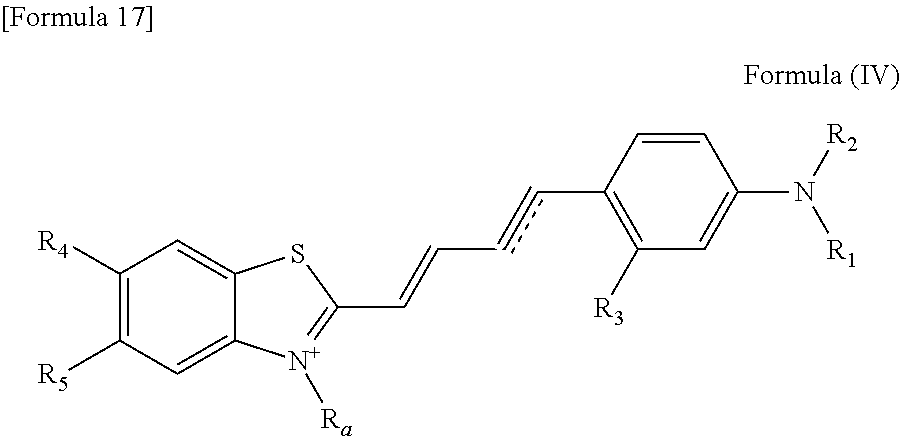
C00014
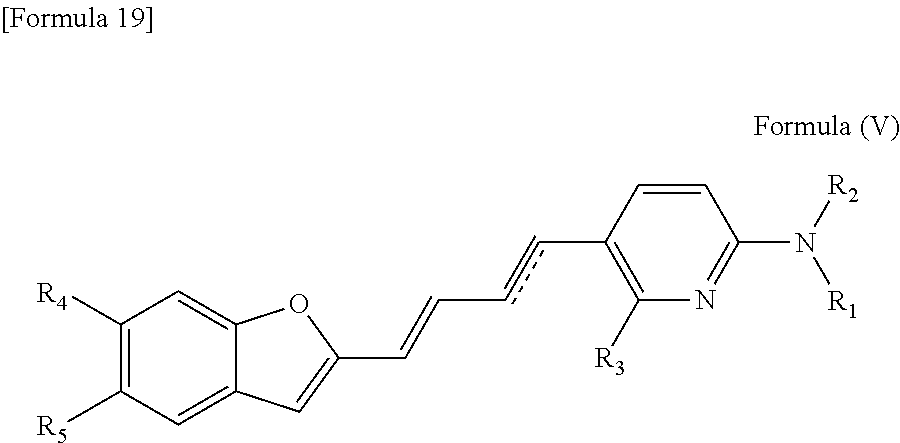
C00015

C00016

C00017

C00018

C00019

C00020

C00021
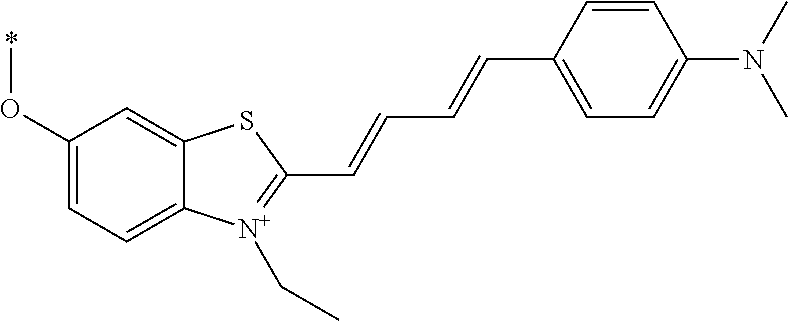
C00022

C00023

C00024

C00025

C00026

C00027

C00028

C00029
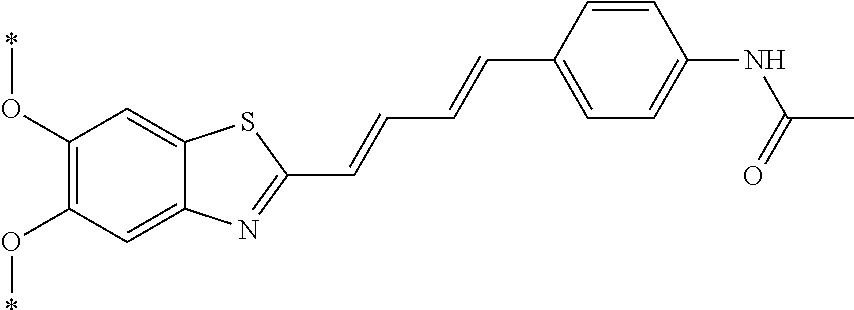
C00030

C00031
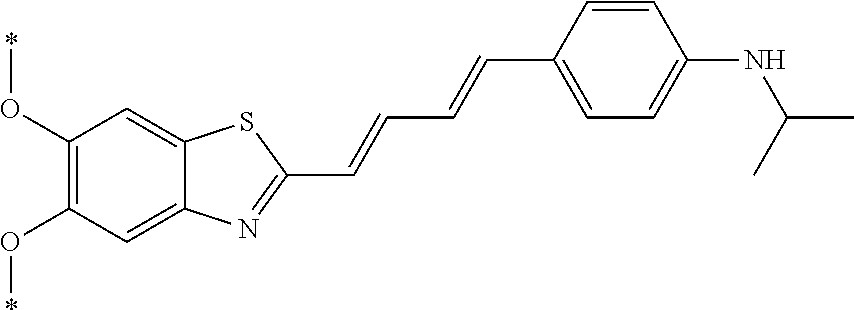
C00032

C00033

C00034
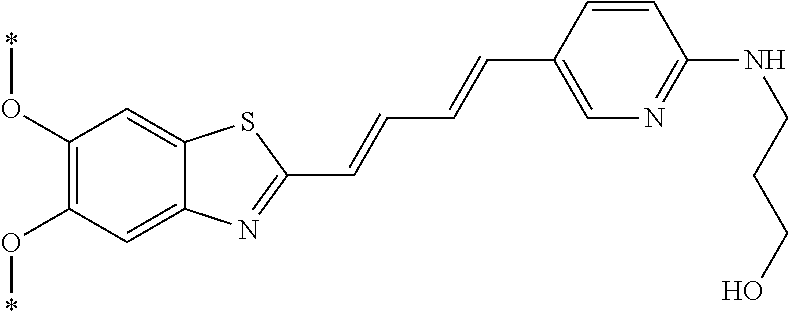
C00035

C00036

C00037

C00038

C00039
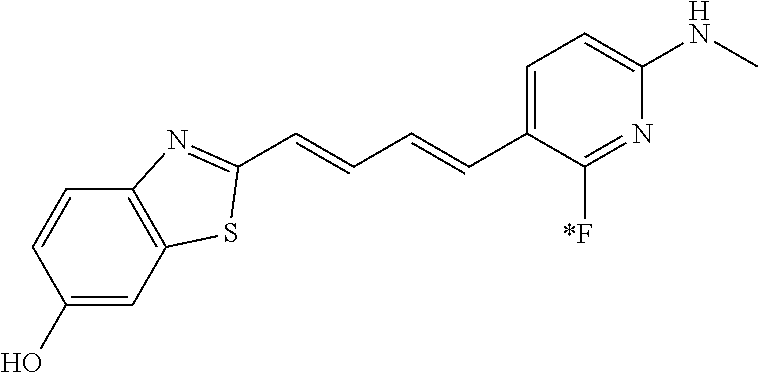
C00040
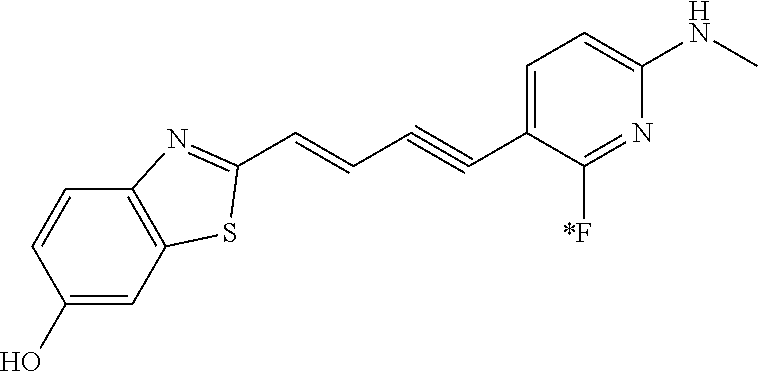
C00041

C00042

C00043

C00044

C00045

C00046

C00047
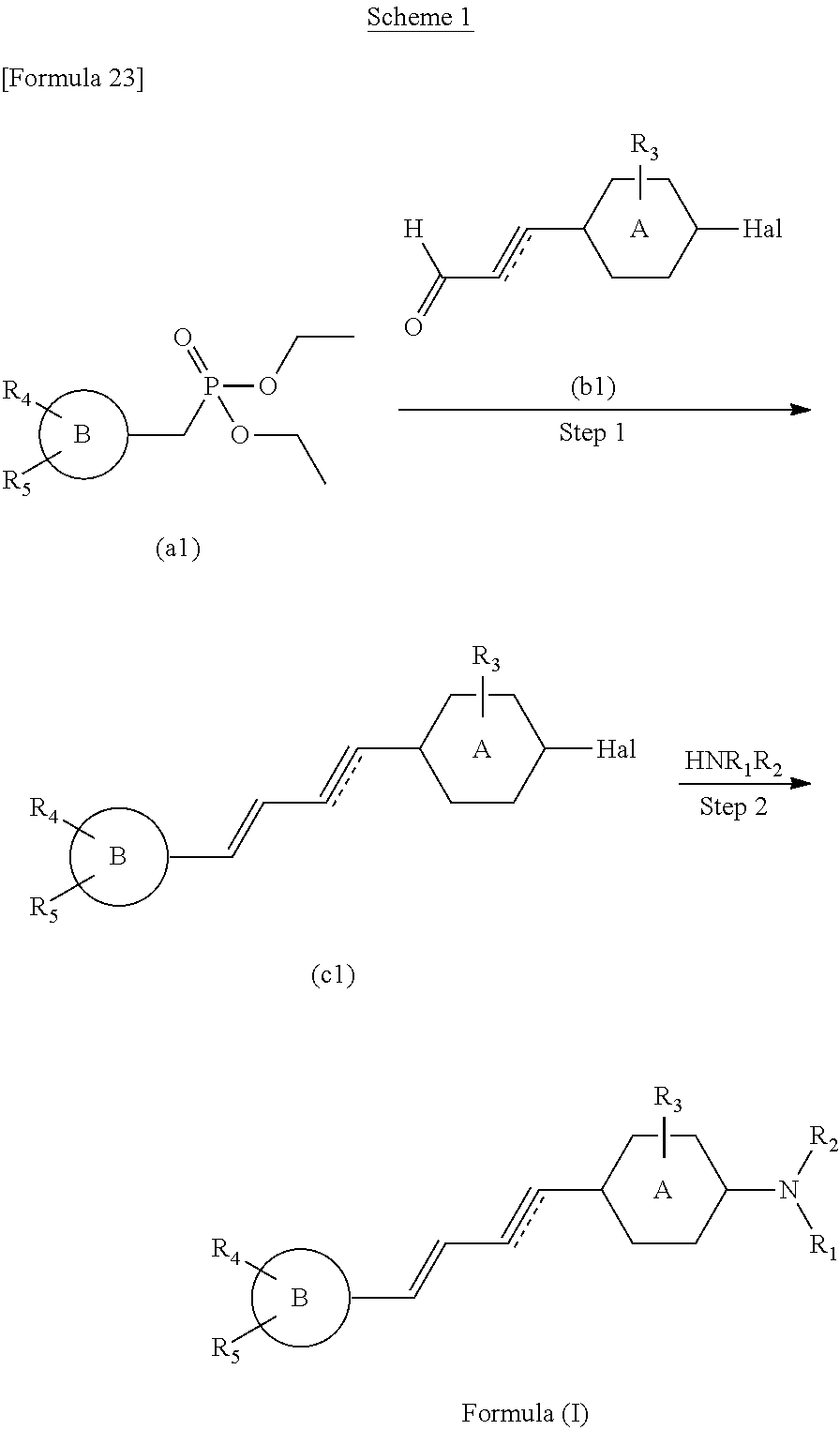
C00048

C00049

C00050
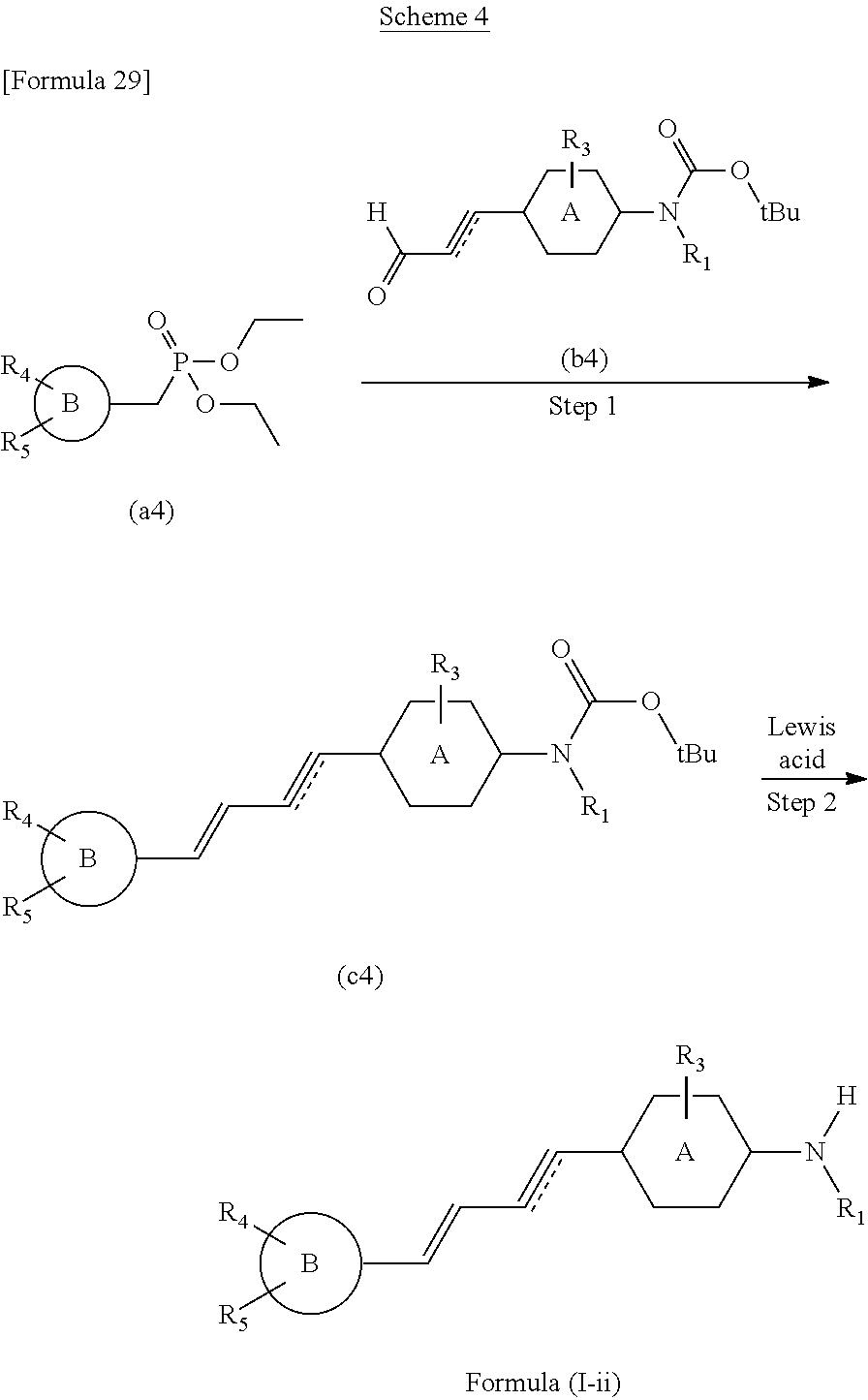
C00051

C00052

C00053

C00054
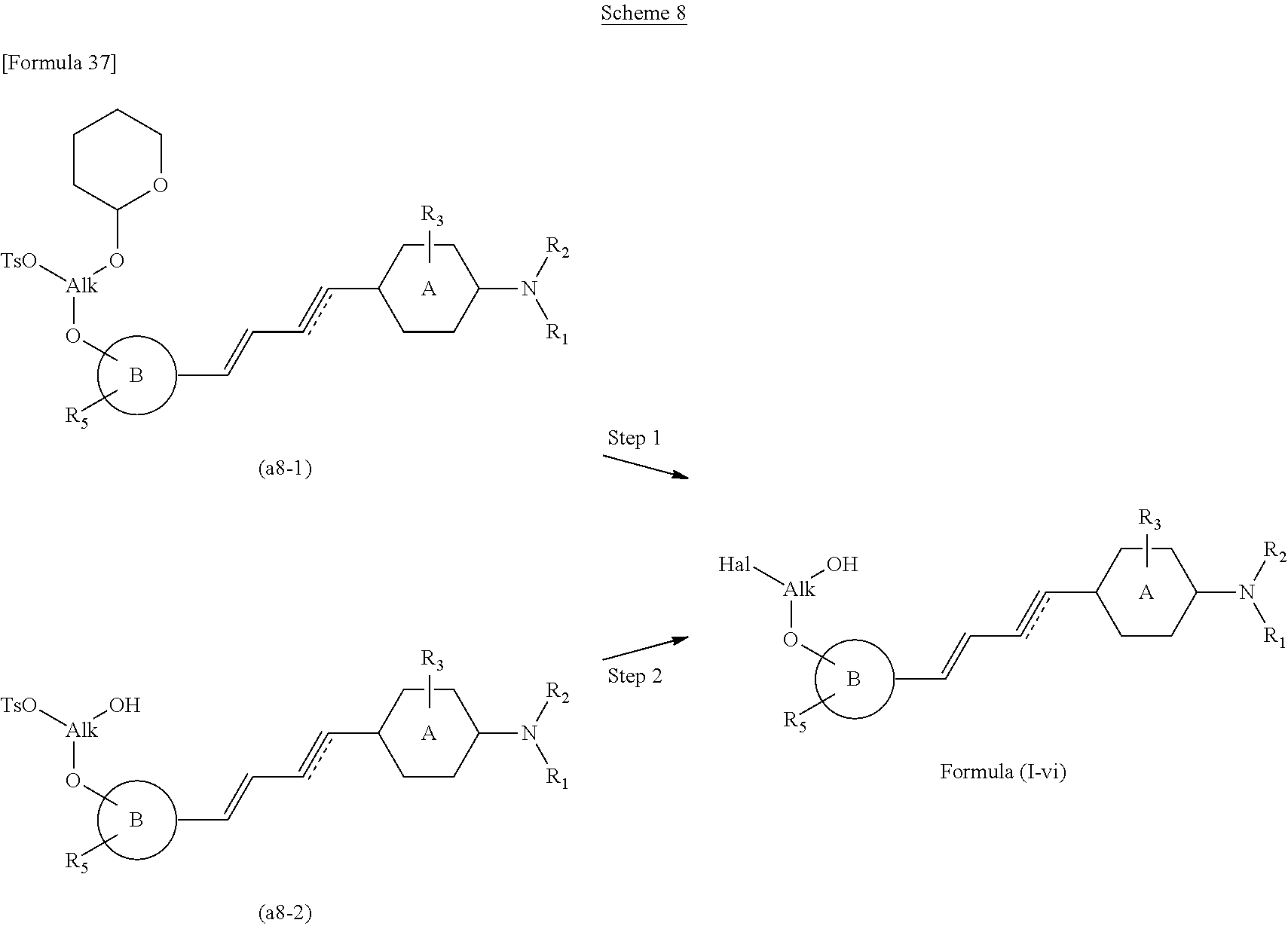
C00055

C00056

C00057
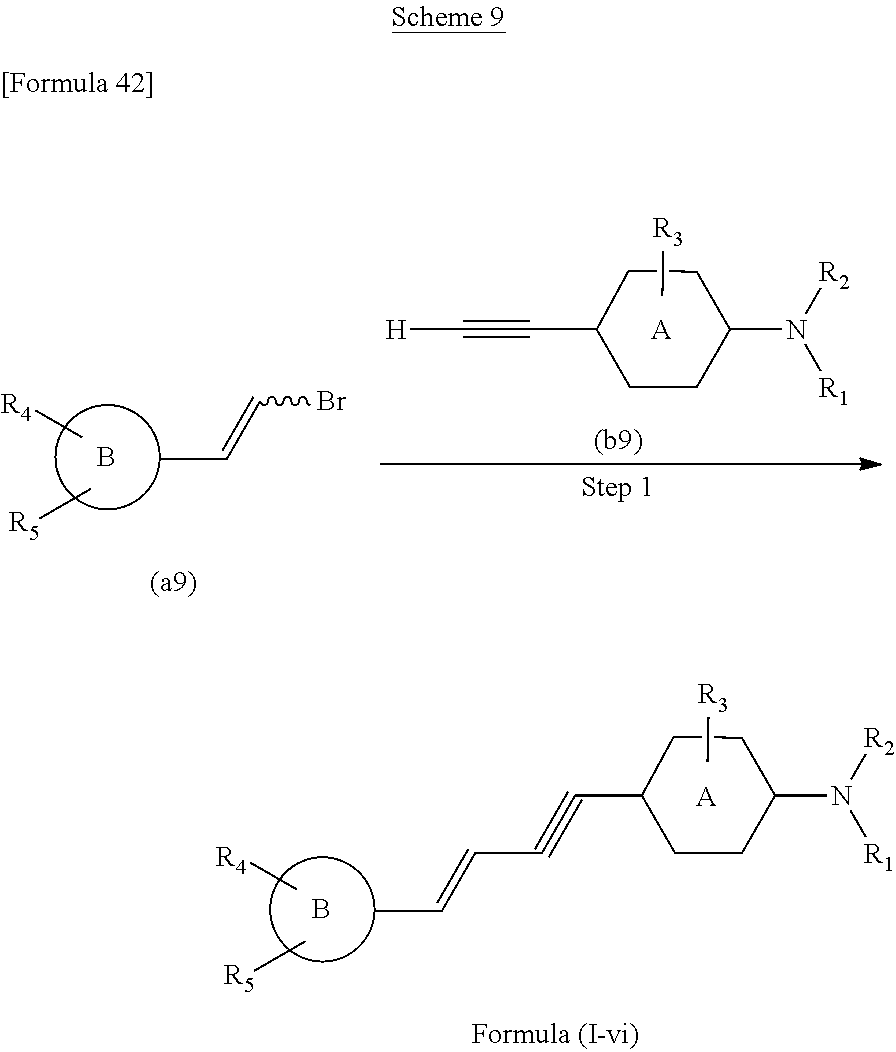
C00058

C00059

C00060

C00061

C00062

C00063

C00064

C00065

C00066

C00067
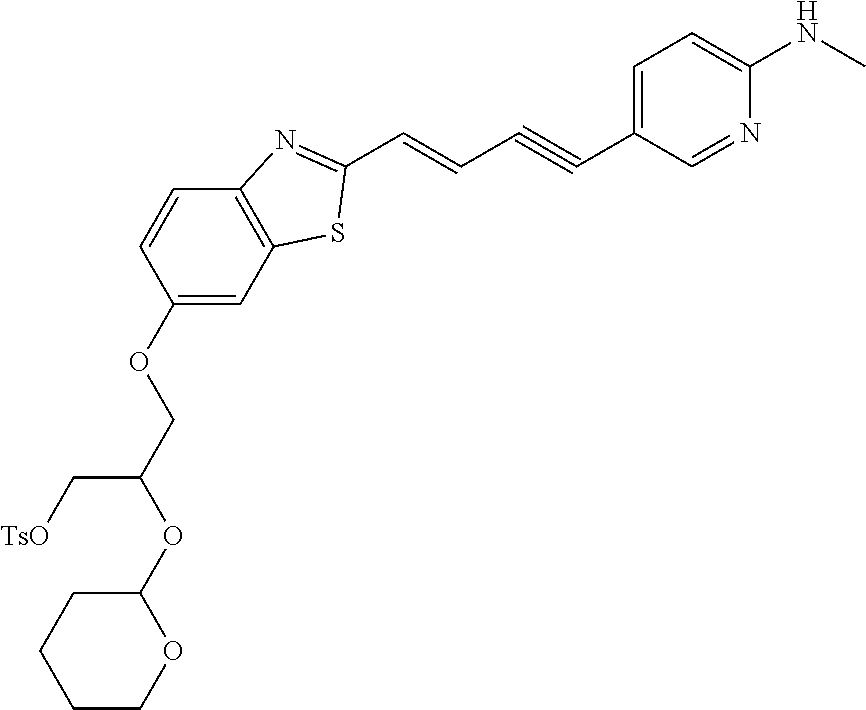
C00068
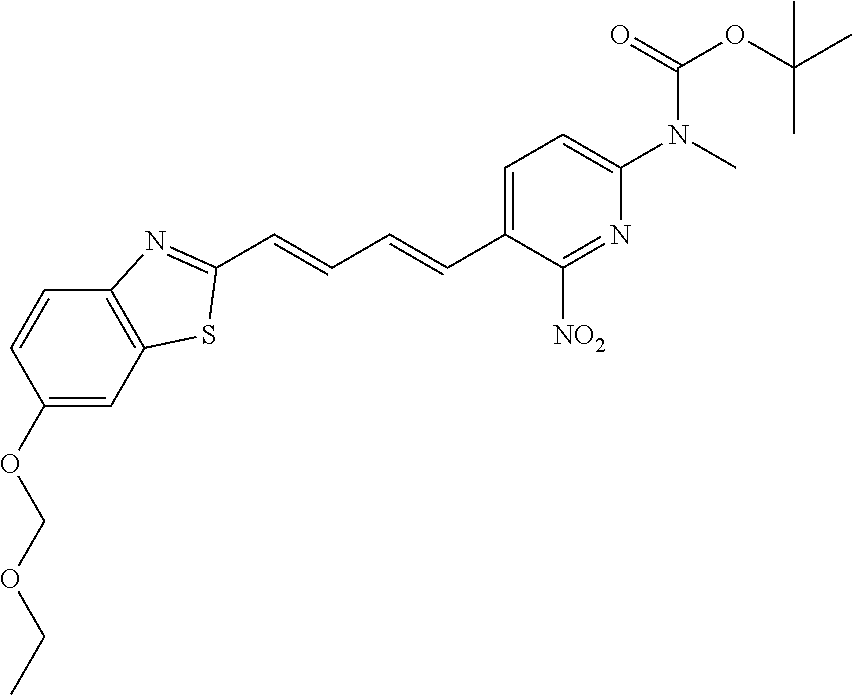
C00069

C00070

C00071

C00072

C00073

C00074

C00075
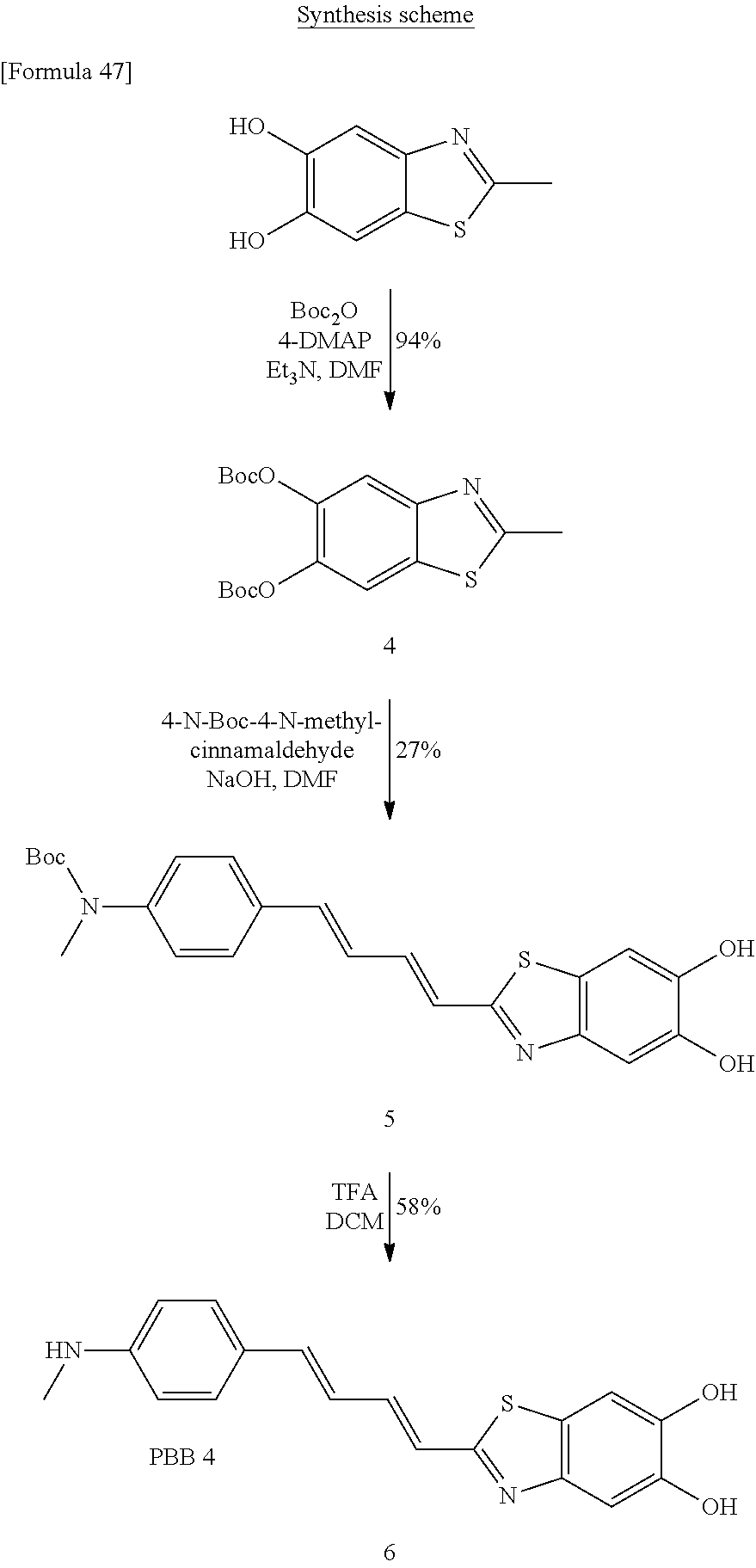
C00076
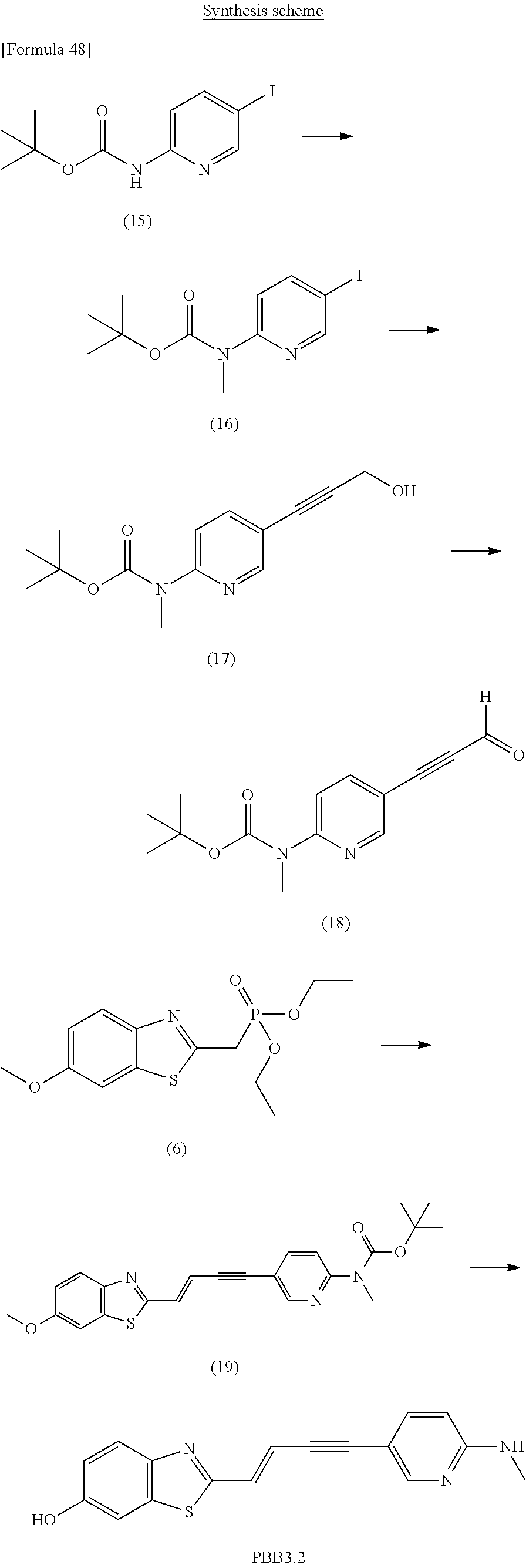
C00077

C00078
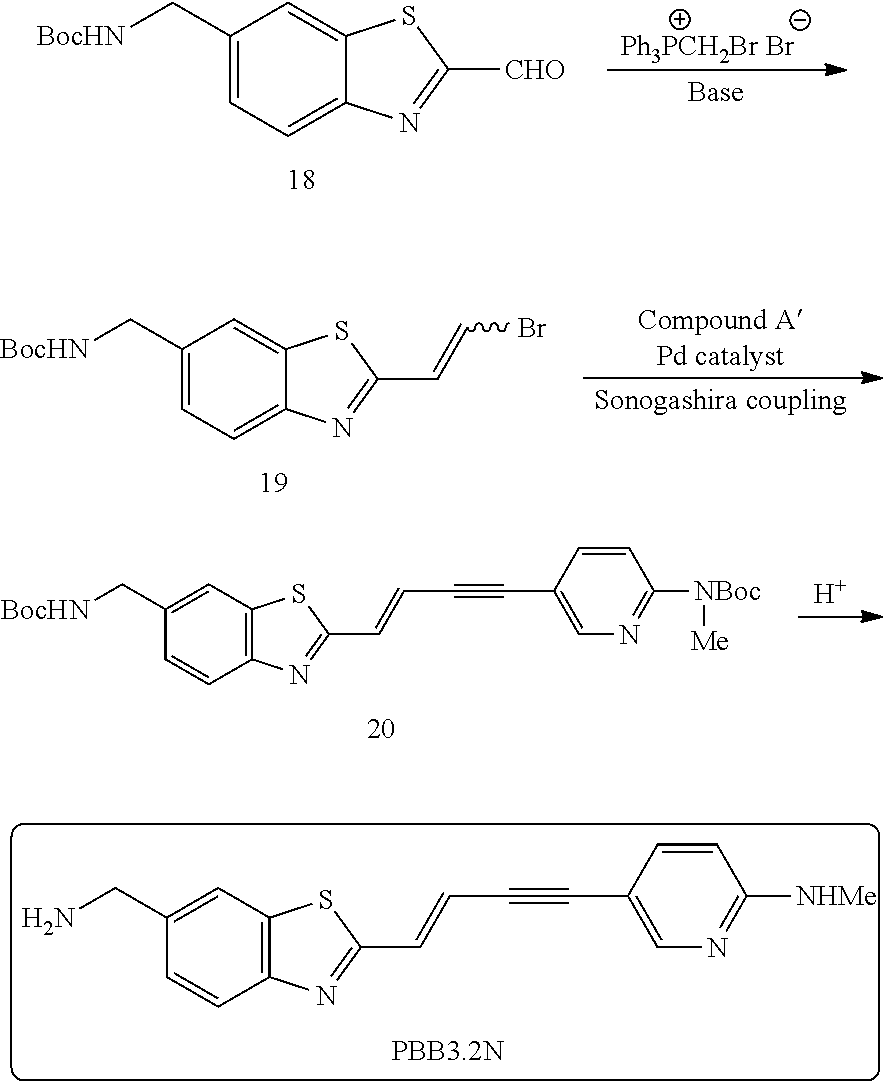
C00079

C00080

C00081
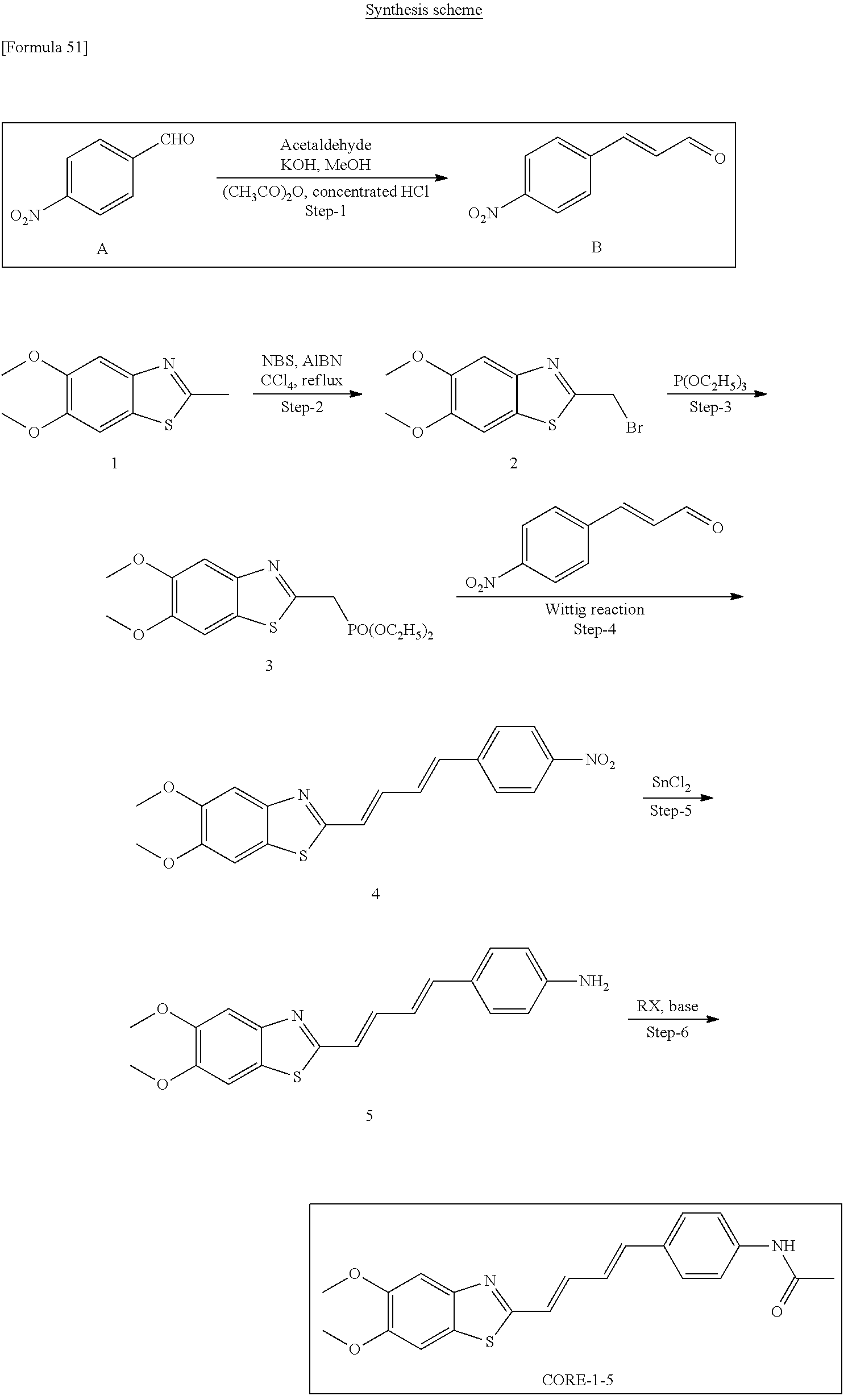
C00082

C00083
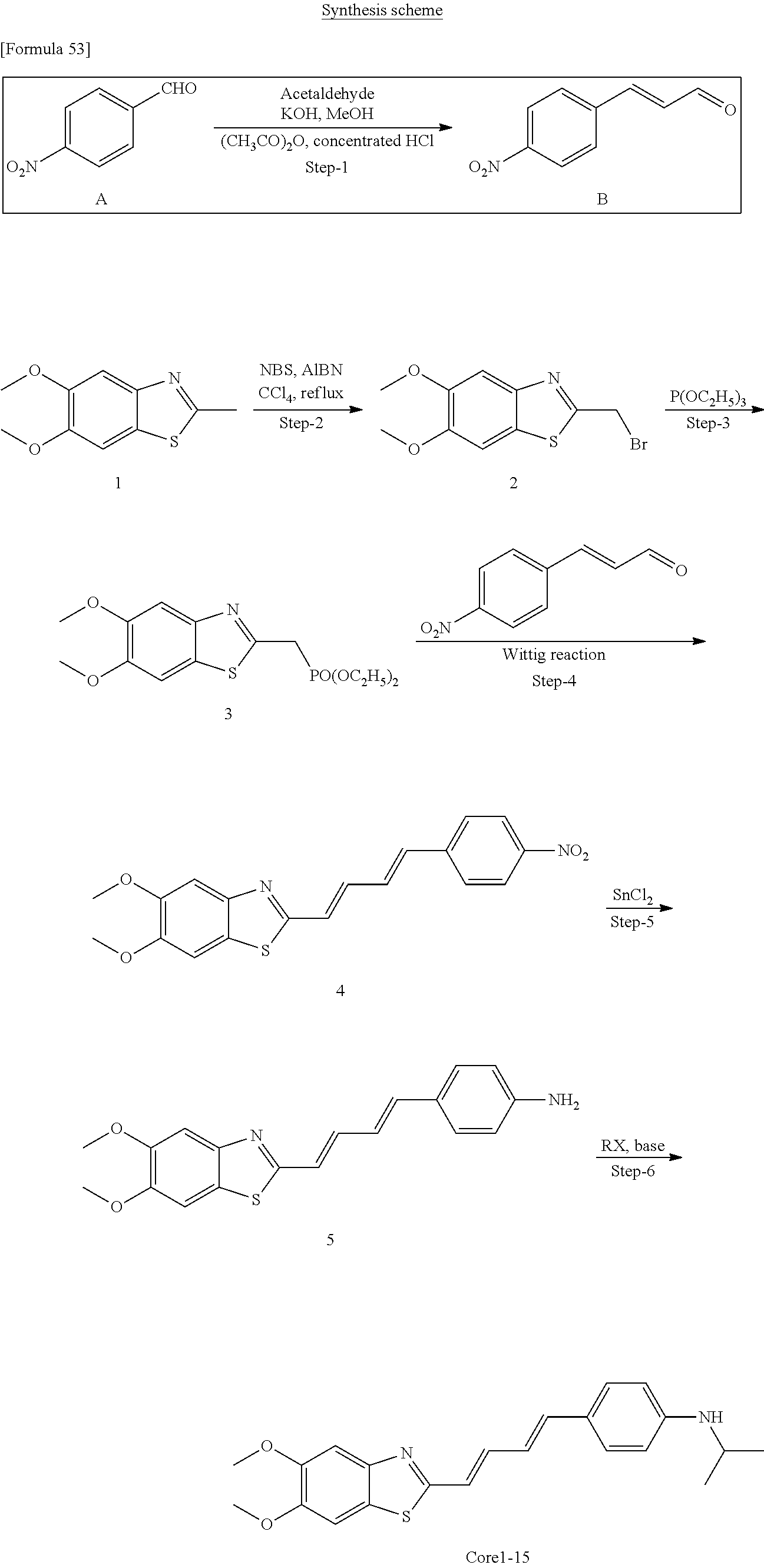
C00084
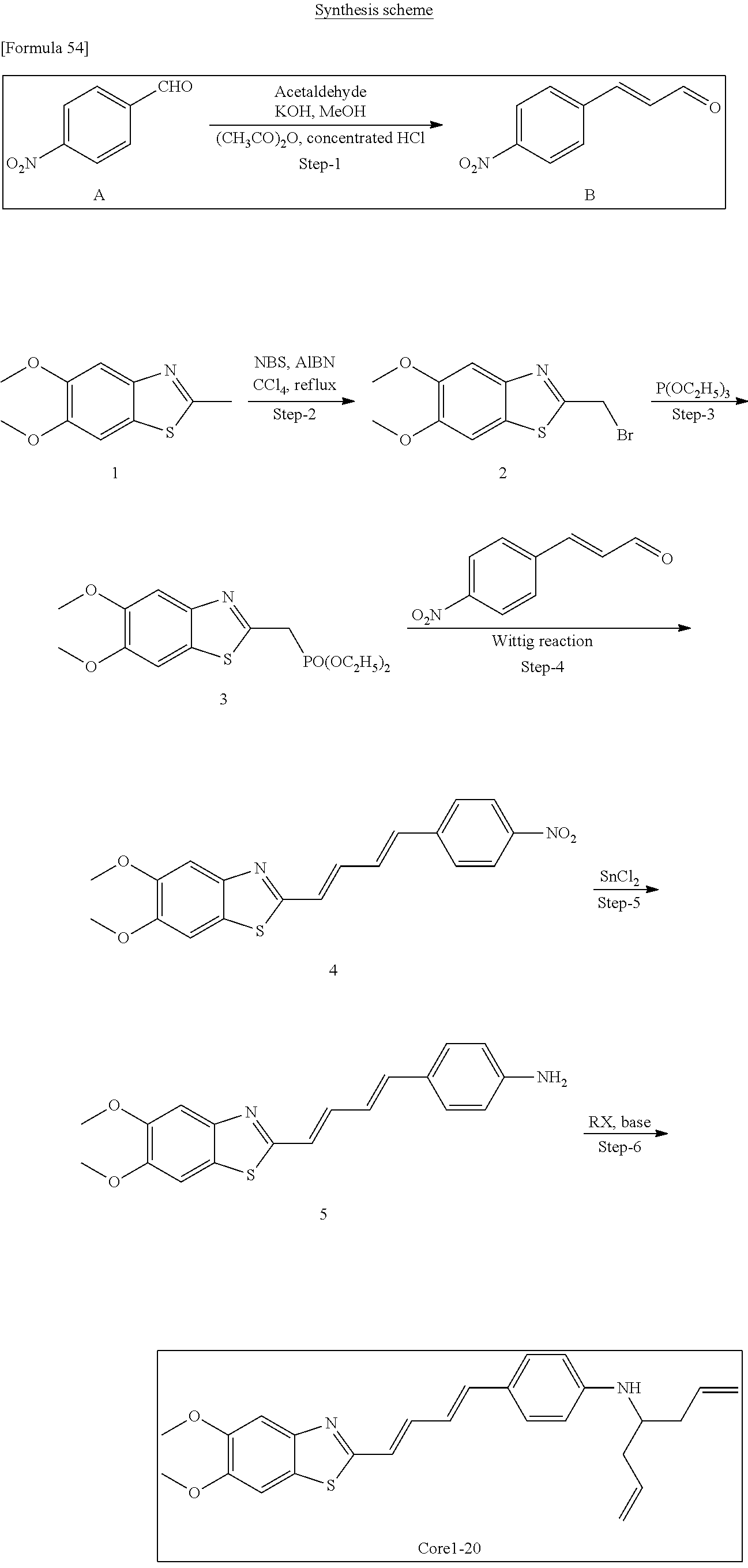
C00085
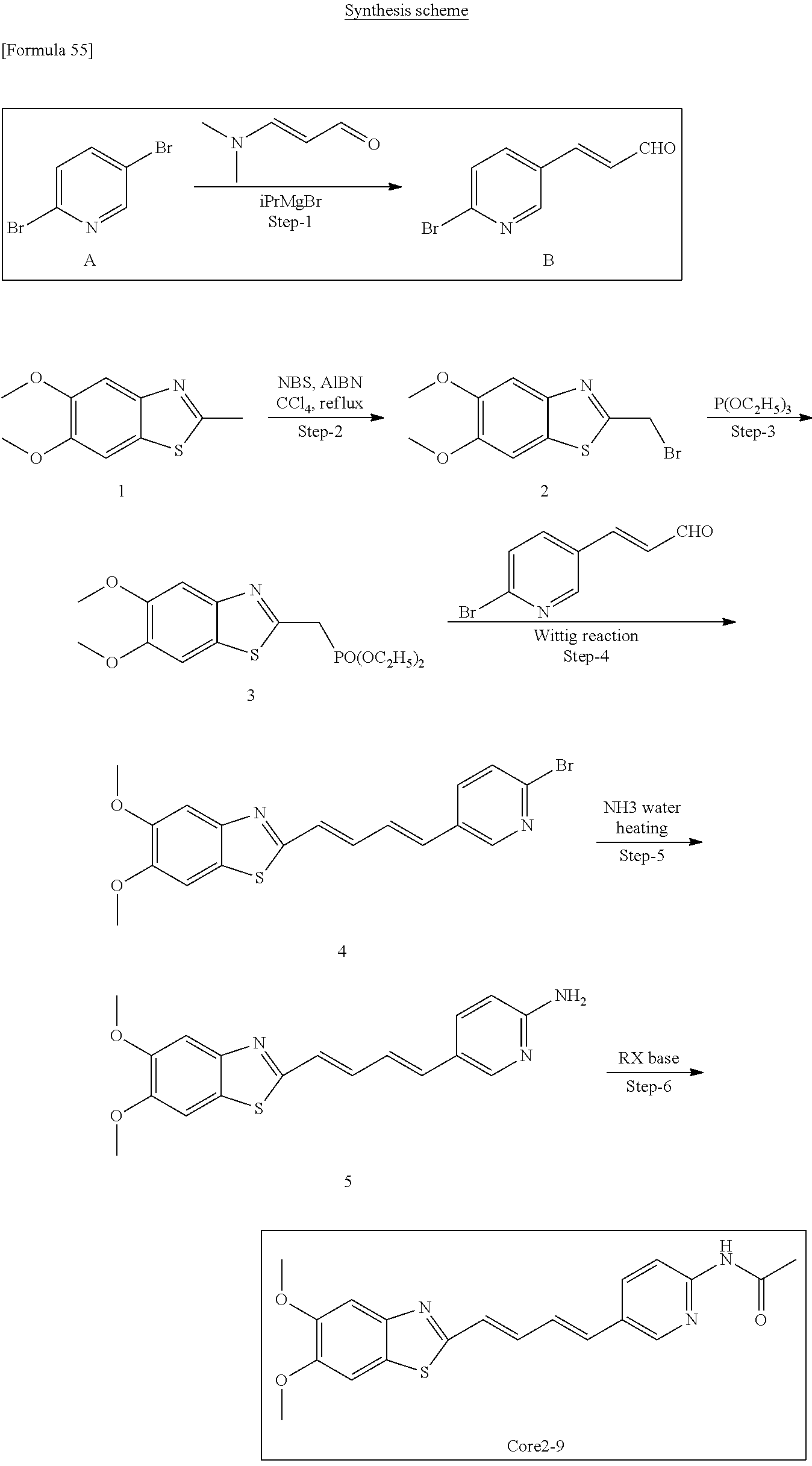
C00086
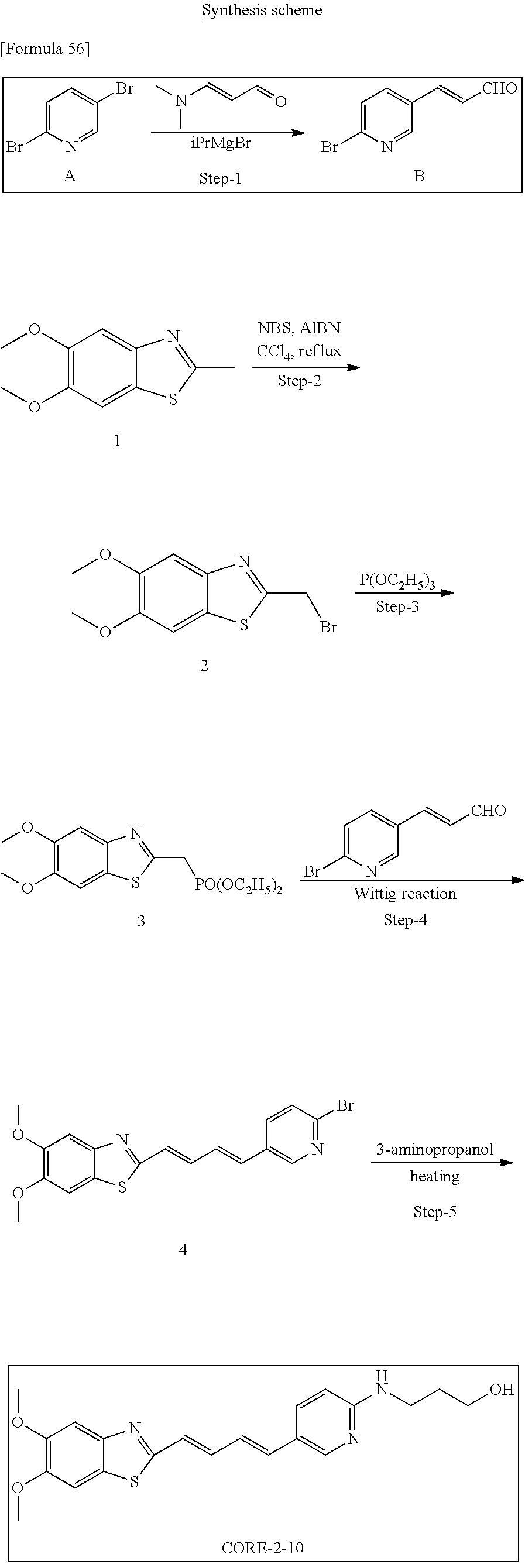
C00087

C00088

C00089
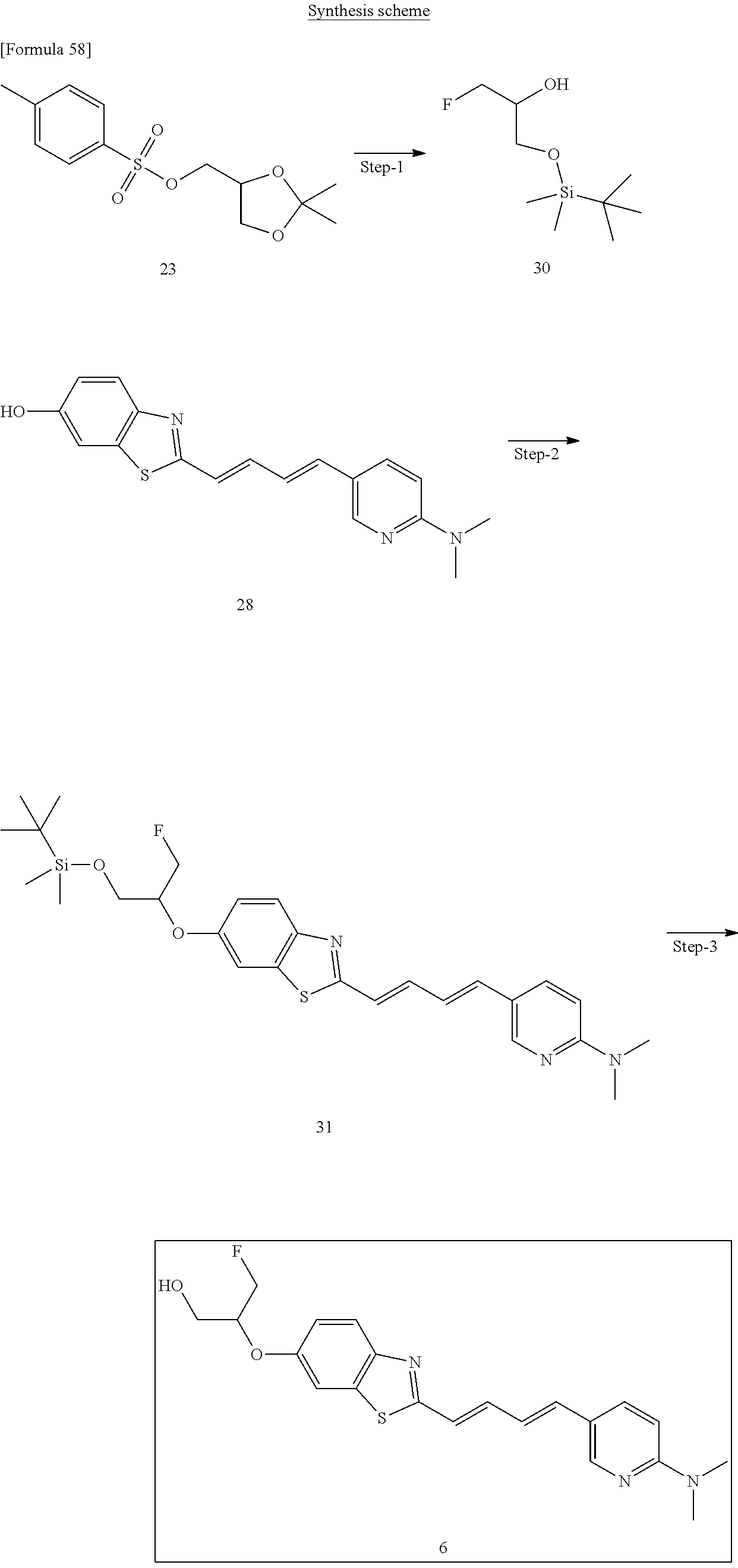
C00090
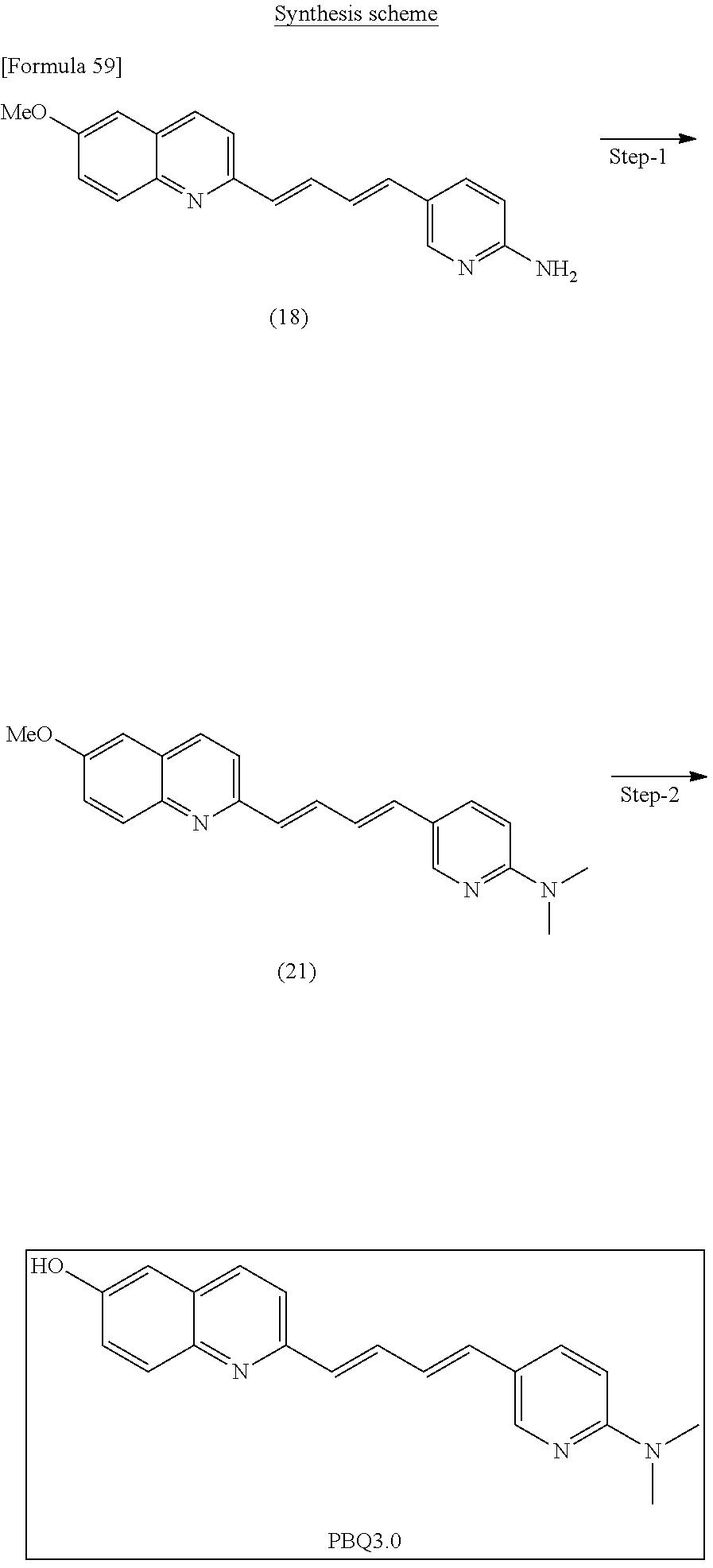
C00091

C00092

C00093
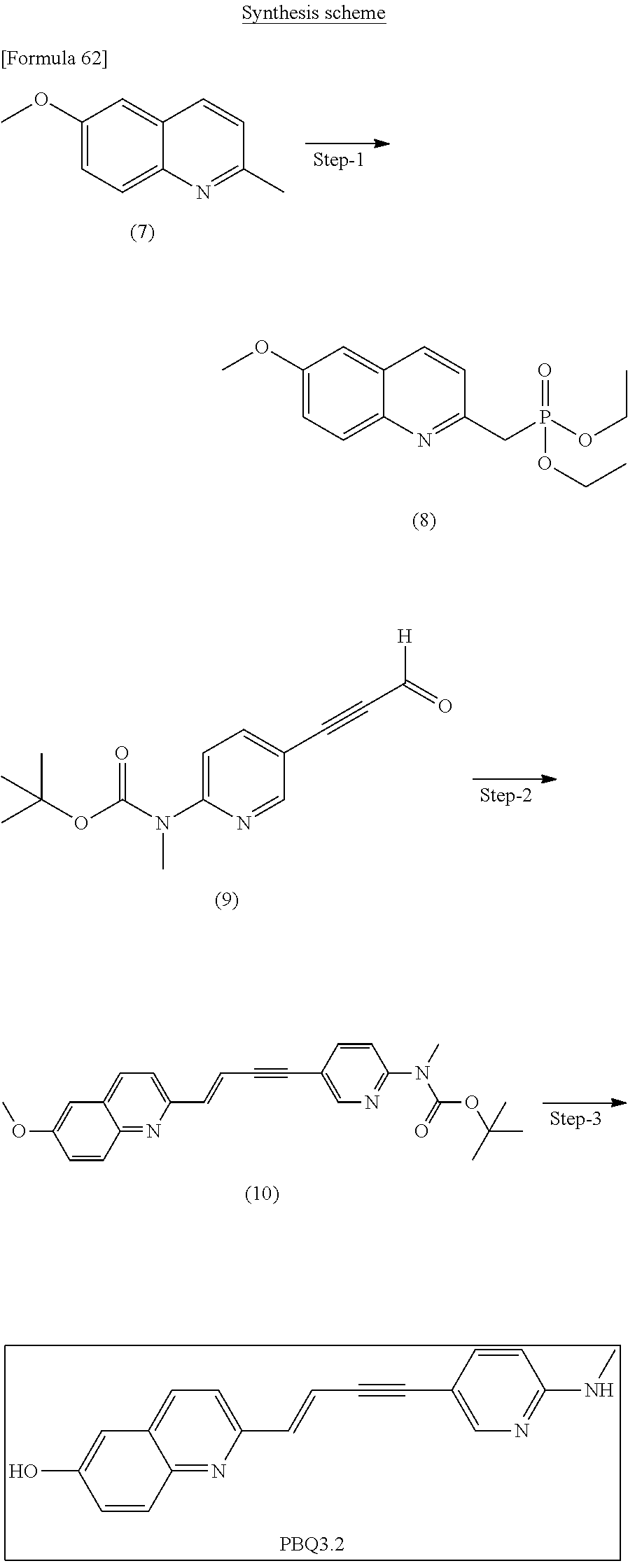
C00094
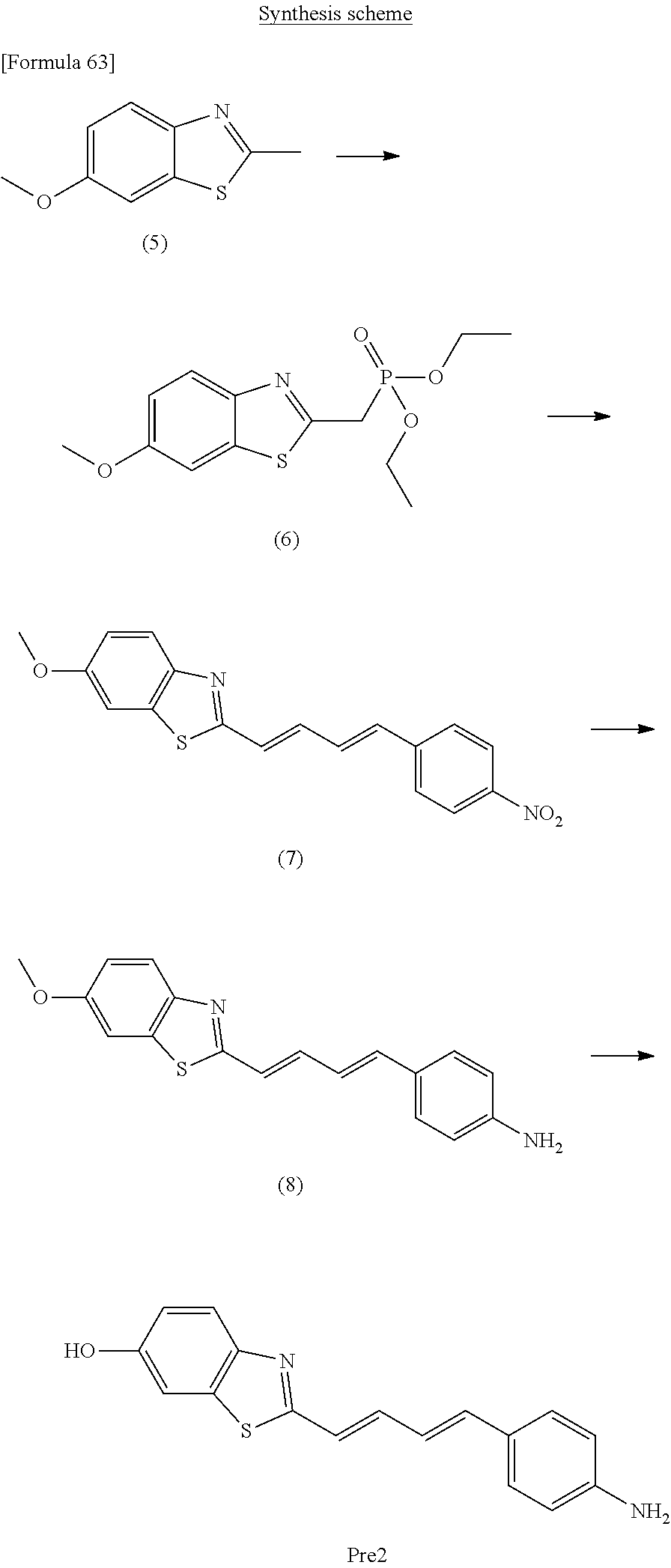
C00095

C00096

C00097

C00098
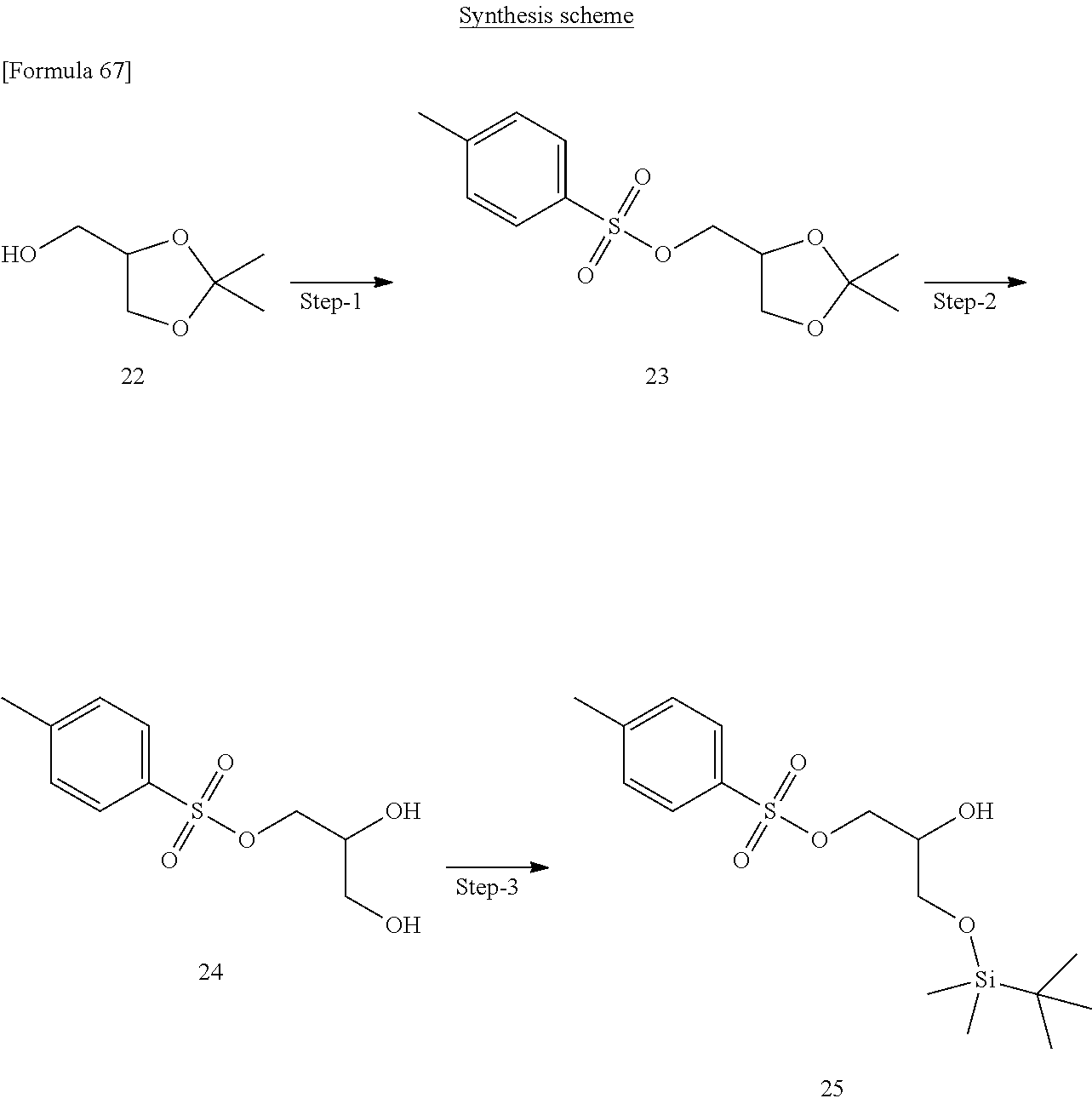
C00099

C00100

C00101

C00102

C00103

D00001

D00002

D00003

D00004

D00005
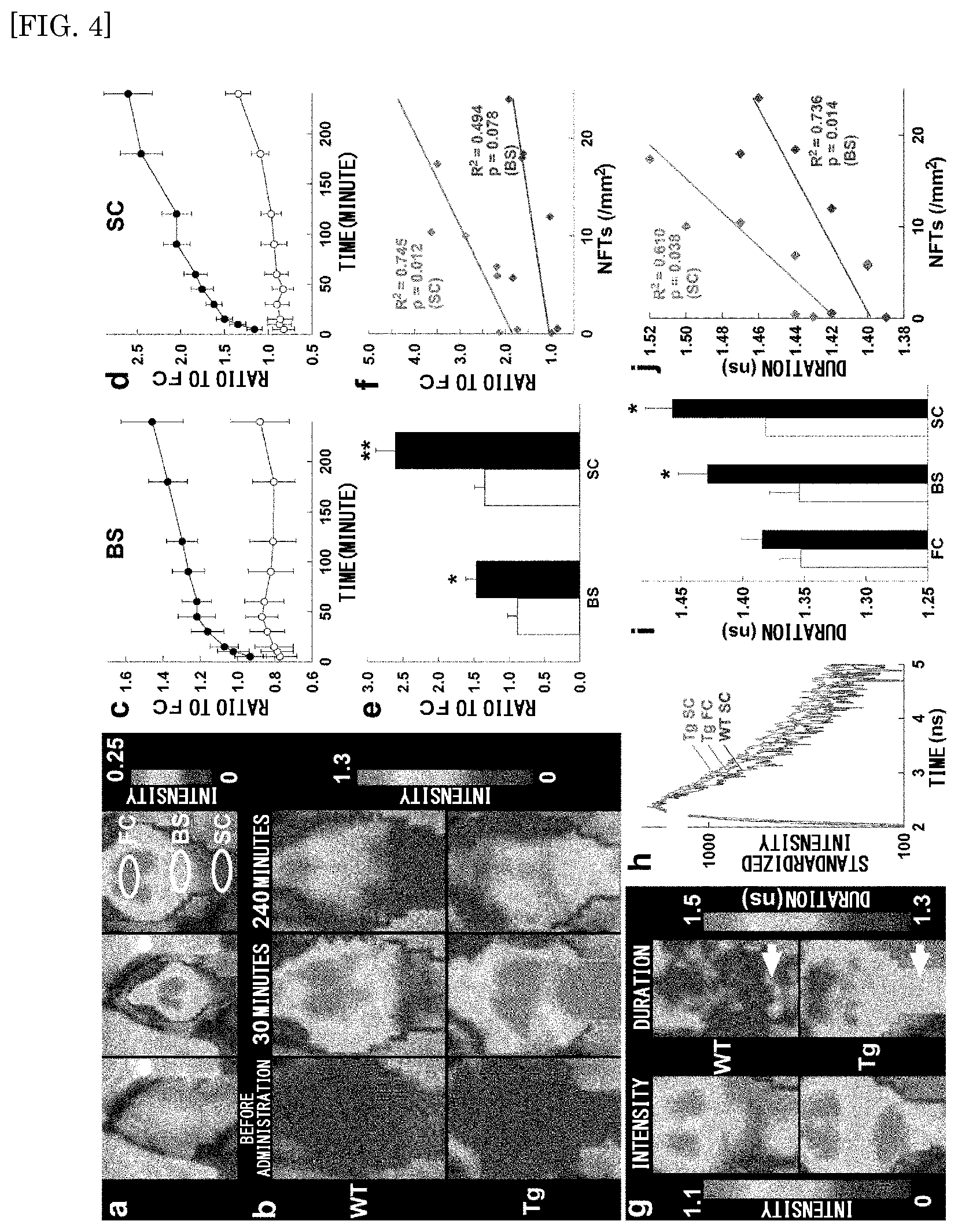
D00006

D00007
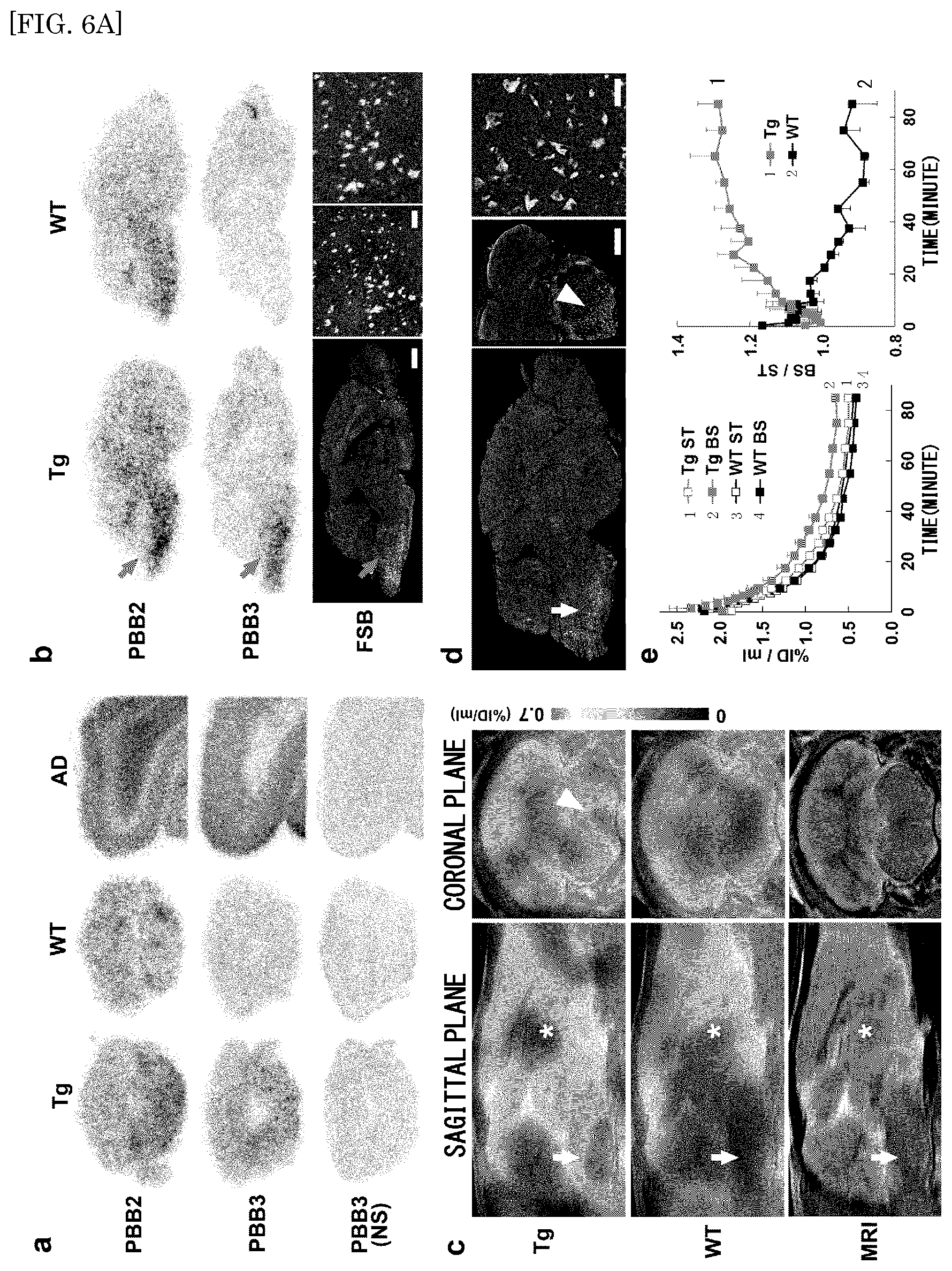
D00008
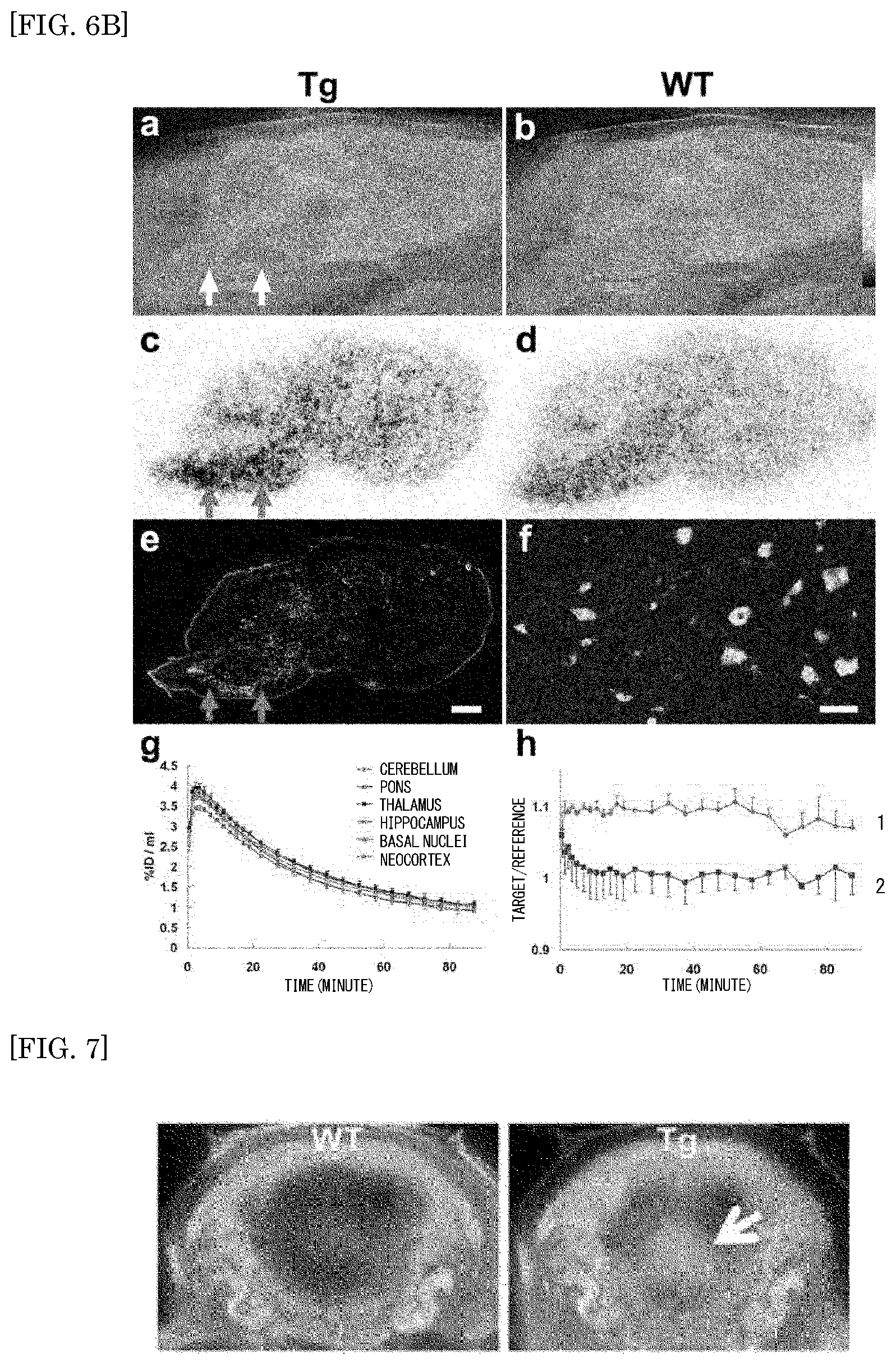
D00009
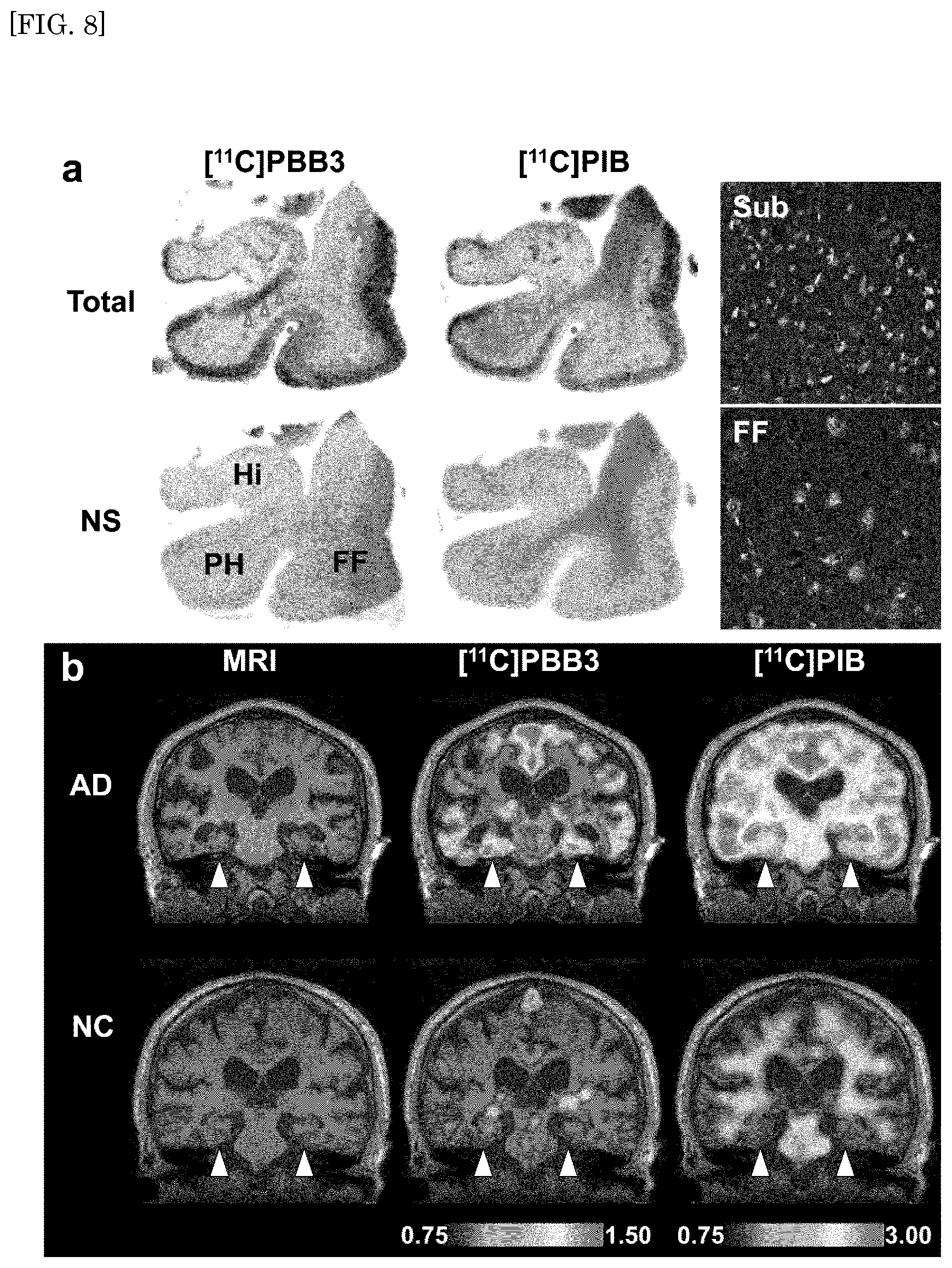
P00001

XML
uspto.report is an independent third-party trademark research tool that is not affiliated, endorsed, or sponsored by the United States Patent and Trademark Office (USPTO) or any other governmental organization. The information provided by uspto.report is based on publicly available data at the time of writing and is intended for informational purposes only.
While we strive to provide accurate and up-to-date information, we do not guarantee the accuracy, completeness, reliability, or suitability of the information displayed on this site. The use of this site is at your own risk. Any reliance you place on such information is therefore strictly at your own risk.
All official trademark data, including owner information, should be verified by visiting the official USPTO website at www.uspto.gov. This site is not intended to replace professional legal advice and should not be used as a substitute for consulting with a legal professional who is knowledgeable about trademark law.